|
2024
AmLight supporting Network Research Exhibition (NRE) demonstrations at SuperComputing (SC24)
November 17-22, 2024
 At the SuperComputing 2024 (SC24) conference, which took place from November 17–22 in Atlanta, GA, AmLight played a key role in supporting Network Research Exhibitions (NREs) that showcased cutting-edge advancements in global networking for data-intensive sciences. These demonstrations highlighted innovative methods to accelerate scientific discovery, enable international collaboration, and streamline the handling of massive data flows.
As the scale of scientific data expanded, so did the complexities of managing network infrastructures, scientific workflows, and globally distributed resources. The NREs at SC24 addressed these challenges by demonstrating next-generation technologies, dynamic provisioning systems, and high-performance networking solutions designed to meet the needs of disciplines ranging from astrophysics to genomics. With contributions from research organizations spanning the Americas, Europe, Asia, Africa, and Oceania, SC24’s NREs paved the way for smarter, faster, and more efficient global research and education networks. At the SuperComputing 2024 (SC24) conference, which took place from November 17–22 in Atlanta, GA, AmLight played a key role in supporting Network Research Exhibitions (NREs) that showcased cutting-edge advancements in global networking for data-intensive sciences. These demonstrations highlighted innovative methods to accelerate scientific discovery, enable international collaboration, and streamline the handling of massive data flows.
As the scale of scientific data expanded, so did the complexities of managing network infrastructures, scientific workflows, and globally distributed resources. The NREs at SC24 addressed these challenges by demonstrating next-generation technologies, dynamic provisioning systems, and high-performance networking solutions designed to meet the needs of disciplines ranging from astrophysics to genomics. With contributions from research organizations spanning the Americas, Europe, Asia, Africa, and Oceania, SC24’s NREs paved the way for smarter, faster, and more efficient global research and education networks.
This year the AmLight team is supporting several Network Research Executions (NREs):
SC24-NRE-013 PDF: A Next Generation Multi-Terabit/sec Campus and Global Network System for Data Intensive Sciences
FABRIC – Ciena, Booth #1940
The Global Network Advancement Group (GNA-G) and its Data Intensive Sciences (DIS) and SENSE/AutoGOLE Working Groups, a worldwide collaboration bringing together major science programs, research and education networks, and advanced network R&D projects spanning the U.S, Europe, Asia, Latin America and Oceania, are developing a next generation network-integrated system that will meet the challenges of data intensive sciences, showing the way towards the next generation of intelligent operations of R&E networks, as well as new methods and modes of network operation and capacity management that will benefit both network research and production teams. The continued use of the Waveserver Ais discussed in this proposal will be a key enabler of these developments. This network research exhibition (NRE) will present and demonstrate, in partnership with several NREs covering specific areas, many aspects of the next generation system which the GNA-G is developing both for data intensive sciences and help set the course for future R&E network operations.
SC24-NRE-014 PDF : MMCFTP’s Data Transfer Experiment Using Ten 100 Gbps Lines Between JAPAN and USA
NICT, Booth #3155
Today, academic networks are interconnected through international lines of over 100 Gbps. By combining and using these lines simultaneously, we can achieve the faster data transfers needed for cutting-edge scientific and technological research. In this demonstration, Japan and the US will be connected via 10 x 100 Gbps lines, and memory-to-memory transfer experiments will be conducted using MMCFTP, a high-speed transfer tool that supports multipath transfers. We aim to achieve a peak speed of 800 Gbps.
SC24-NRE-015 PDF: High-Speed Data Transfers from South Africa to USA!
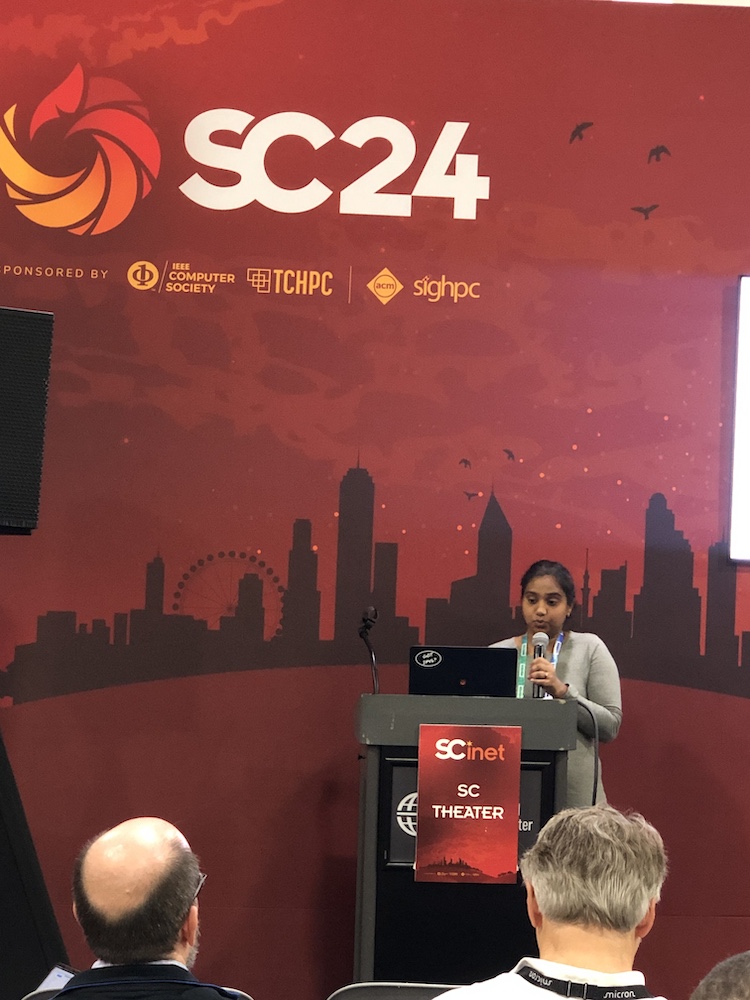 The AmLight network uses a hybrid network strategy that combines optical spectrum and leased capacity to build a reliable, leading-edge network infrastructure for research and education. AmLight supports high-performance network connectivity required by international science and engineering research and education collaborations involving the National Science Foundation (NSF) research community, with expansion to South America and West Africa. This collaboration offers a unique opportunity to work alongside SANReN, encompassing African involvement in the experiments while closely monitoring the performance of the AmLight-ExP’s SACS link through a diverse array of experiments arranged for SC24. The aim is to demonstrate SANReN 100Gbps Data Transfer Nodes(DTNs) which have been implemented to assist researchers with their large data transfer needs to the US and internationally. Large data transfers to the US usually make use of AmLight-ExP’s 100G link over SACS submarine cable system, which established a vital connection between South Africa and the United States via Brazil to Miami. The AmLight network uses a hybrid network strategy that combines optical spectrum and leased capacity to build a reliable, leading-edge network infrastructure for research and education. AmLight supports high-performance network connectivity required by international science and engineering research and education collaborations involving the National Science Foundation (NSF) research community, with expansion to South America and West Africa. This collaboration offers a unique opportunity to work alongside SANReN, encompassing African involvement in the experiments while closely monitoring the performance of the AmLight-ExP’s SACS link through a diverse array of experiments arranged for SC24. The aim is to demonstrate SANReN 100Gbps Data Transfer Nodes(DTNs) which have been implemented to assist researchers with their large data transfer needs to the US and internationally. Large data transfers to the US usually make use of AmLight-ExP’s 100G link over SACS submarine cable system, which established a vital connection between South Africa and the United States via Brazil to Miami.
SC24-NRE-016 PDF: NA REX Demonstration
NA REX is a collaboration directed at improving research and education networking and open exchange points in North America, and by extension globally, enabled by participating open international R&E exchange points, national R&E networks, and regional R&E networks. NA REX is being designed specifically to support R&E communities to accelerate science research, especially multi-domain science, data intensive science, and research testbeds. To accomplish this goal, the NA REX consortium is designing an international infrastructure based on 400 Gbps end-to-end paths interconnecting major open exchange points. Other service components include open exchange Data Transfer Nodes (DTNs), and AutoGOLE/NSI dynamic provisioning.
SC24-NRE-022 PDF: AutoGOLE/SENSE: Edge Site Resource Integration with Network Services
Department of Energy, Booth #3401
 The GNA-G AutoGOLE/SENSE WG demonstrations will present the latest features and status for AutoGOLE and SENSE infrastructure and services. This showcase will include demonstrations of technologies, methods, and systems for dynamic Layer 2 and Layer 3 network multi-domain service provisioning. These services are focused on meeting the challenges for data intensive science programs and workflows, such as the Large Hadron Collider (LHC), the Vera Rubin Observatory, and challenges in many other disciplines. The services are designed to support multiple petabyte transactions across a global footprint, represented by a persistent testbed spanning the US, Europe, Asia Pacific and Latin American regions. The SC24 demonstrations will focus on new features in the area of programmatic driven domain science workflow integration and realtime monitoring/troubleshooting. The GNA-G AutoGOLE/SENSE WG demonstrations will present the latest features and status for AutoGOLE and SENSE infrastructure and services. This showcase will include demonstrations of technologies, methods, and systems for dynamic Layer 2 and Layer 3 network multi-domain service provisioning. These services are focused on meeting the challenges for data intensive science programs and workflows, such as the Large Hadron Collider (LHC), the Vera Rubin Observatory, and challenges in many other disciplines. The services are designed to support multiple petabyte transactions across a global footprint, represented by a persistent testbed spanning the US, Europe, Asia Pacific and Latin American regions. The SC24 demonstrations will focus on new features in the area of programmatic driven domain science workflow integration and realtime monitoring/troubleshooting.
SC24-NRE-024 PDF: FABRIC
FABRIC – Ciena, Booth #1940
This demonstration will show the FABRIC Research Cyberinfrastructure in operation: https://portal.fabric-testbed.net
FABRIC (Adaptive ProgrammaBle Research Infrastructure for Computer Science and Science Applications) is an International infrastructure that enables cutting-edge experimentation and research at-scale in the areas of networking, cybersecurity, distributed computing, storage, virtual reality, 5G, machine learning, and science applications. The FABRIC infrastructure includes a distributed set of equipment at commercial collocation spaces, national labs and campuses. Each of the FABRIC sites has large amounts of compute and storage, interconnected by high speed, dedicated optical links. It also connects to specialized testbeds (5G/IoT PAWR, NSF Clouds), the Internet and high-performance computing facilities to create a rich environment for a wide variety of experimental activities.
SC24-NRE-025 PDF: HECATE Merges with PolKA AI-enabled Traffic Engineering for Data-intensive Science
California Institute of Technology, Booth #839
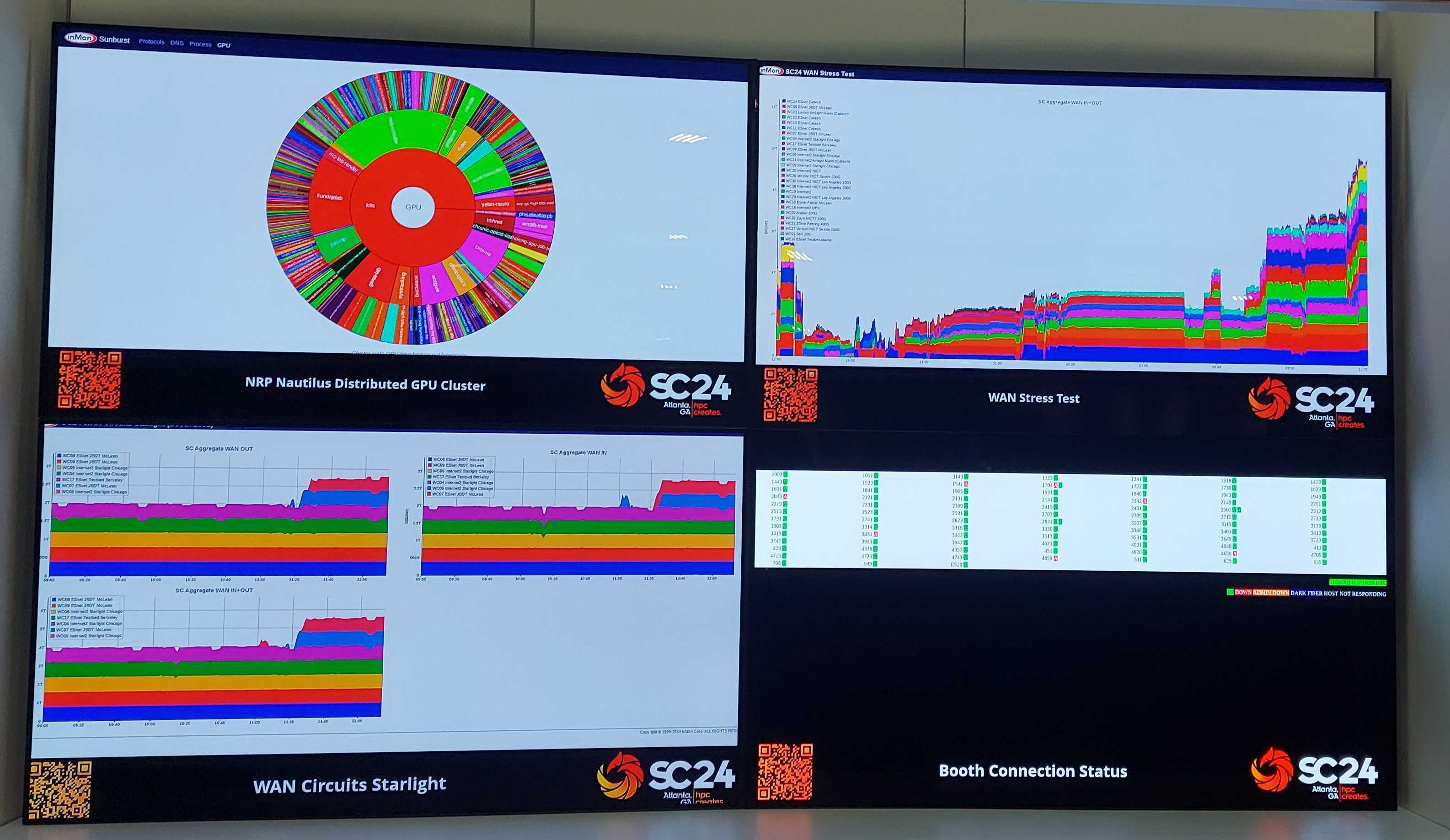 Traffic engineering and path computation techniques such as MPLS-TE (Multiprotocol Label Switching Traffic Engineering), Google’s B4, and Microsoft’s SWAN (Software Driven WAN) propose manners in which routers greedily select routing flow patterns globally, to increase path utilization. However, these techniques require meticulously designed heuristics to calculate optimal routes and also do not distinguish between arriving flow characteristics. Here, we are merging Hecate’s data-driven learning with the PolKA (Polynomial Key-based Architecture) Source Routing (SR) approach to translate data-driven flow control into an agile routing configuration for optimizing traffic engineering. Traffic engineering and path computation techniques such as MPLS-TE (Multiprotocol Label Switching Traffic Engineering), Google’s B4, and Microsoft’s SWAN (Software Driven WAN) propose manners in which routers greedily select routing flow patterns globally, to increase path utilization. However, these techniques require meticulously designed heuristics to calculate optimal routes and also do not distinguish between arriving flow characteristics. Here, we are merging Hecate’s data-driven learning with the PolKA (Polynomial Key-based Architecture) Source Routing (SR) approach to translate data-driven flow control into an agile routing configuration for optimizing traffic engineering.
SC24-NRE-029 PDF: Multi Domain Experiments Using ESnet SENSE on the National Research Platform / PacWave / FABRIC
FABRIC – Ciena, Booth #1940, John Graham.
The San Diego Supercomputer Center (SDSC) and the Prototype National Research Platform (PNRP) NSF Award 2112167 Category II are providing twelve Xilinx Alveo U55C FPGAs in six servers for researchers at the SC24 Network Research Exhibition (NRE). These devices will be utilized in ESnet SmartNIC P4 Segment Routing over IPv6 (SRv6) using Unstructured Segment Identifier (uSID) experiments, connecting from the FABRIC testbed StarLight site (FABRIC-STAR) to various sites. Each U55C FPGA features dual 100 Gigabit Ethernet interfaces, integrated into the SDSC Automated Global Optical Lightpath Exchange (AutoGOLE) Science Environment for Network and Computer Engineering (SENSE) network topology. The PacWave NSF Award 2029306 (IRNC Core Improvement: Accelerating Scientific Discovery & Increasing Access – Enhancing & Extending the Pacific Wave Exchange Fabric) has supplied seven 1U DC-powered measurement and monitoring servers, known as Interactive Global Research Observatory Knowledgebase (IGROK) nodes. Each node is equipped with a Bluefield 2 Data Processing Unit (DPU), also with dual 100 Gigabit Ethernet interfaces, integrated into the PacWave AutoGOLE SENSE network topology.
SC24-NRE-030 PDF: GP4L – Global Platform For Lab
This showcase will include demonstration of new deployed sites, specially the integration of BlueField2 nodes from seven Pacwave peering sites, the performance benchmark results from the new supported software dataplane based on freeRtr/DPDK and VPP. Demonstrate GP4L orchestration and automation capabilities, and additionally support other NREs that are experimenting with at scale advanced/novel networking protocols and use cases, like PolKA (Polynomial Key-based Architecture) a stateless source routing protocol based on arithmetic operations over a polynomial encoded route label.
SC24-NRE-031 PDF: High Performance Networking with the Sao Paulo Backbone SP Linking 8 Universities and the Bella Link
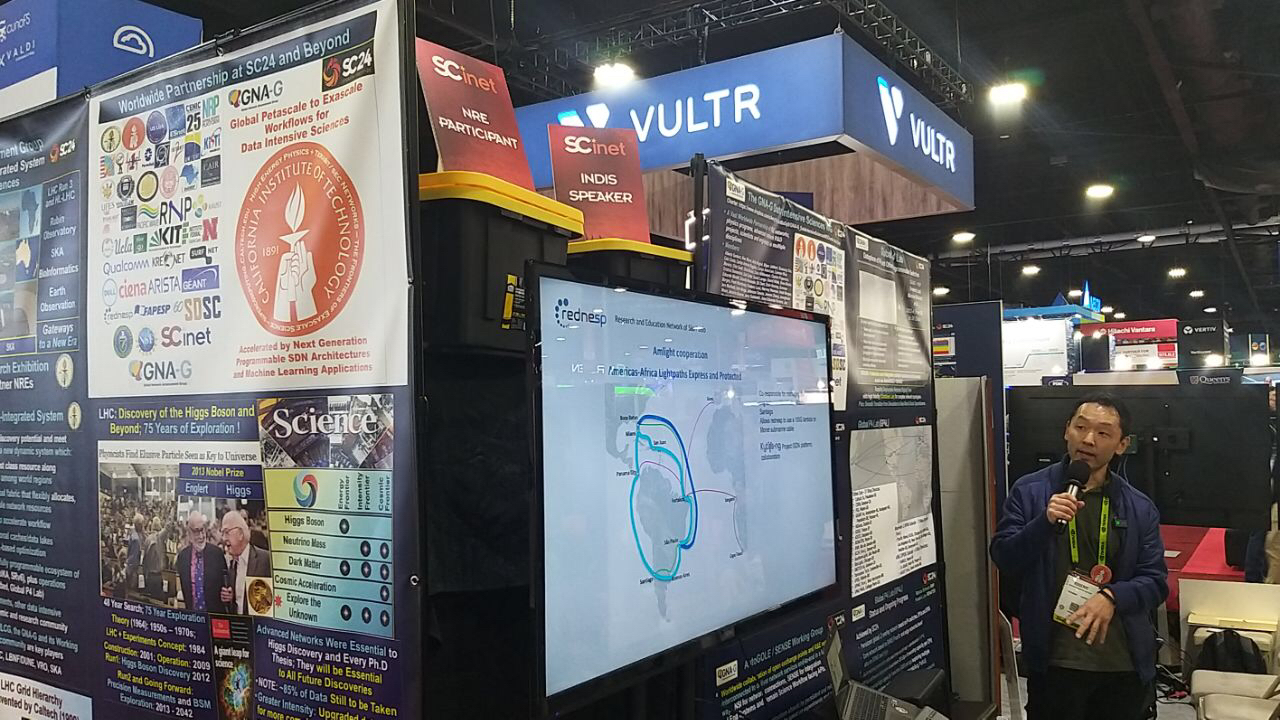 The research and education network at Sao Paulo (rednesp), formerly ANSP (Academic Network at Sao Paulo), connects dozens of research and education institutions in the State of Sao Paulo, Brazil also providing international connections to the USA and to Europe. After designing it in 2022, rednesp started deploying a new backbone, known as “Backbone SP” connecting 8 major research and education institutions with 100 Gbps links. The rednesp team will try to improve on last year’s bandwidth between Sao Paulo and the USA when 320 gbps (total bandwidth) was reached. At SC24, the target will be 400 gbps which shall be a record throughput connecting Brazil and the USA using academic networks. The team will also demonstrate technical characteristics such as the latency, bandwidth and jitter of the Backbone SP and its integration with international links. The usefulness of the network in supporting data intensive science applications in areas like high energy physics and cryo-electron microscopy shall be demonstrated. Also, 400 gbps equipment are being purchased and deployed and it should be possible to demonstrate connections with that speed in the state of São Paulo. The research and education network at Sao Paulo (rednesp), formerly ANSP (Academic Network at Sao Paulo), connects dozens of research and education institutions in the State of Sao Paulo, Brazil also providing international connections to the USA and to Europe. After designing it in 2022, rednesp started deploying a new backbone, known as “Backbone SP” connecting 8 major research and education institutions with 100 Gbps links. The rednesp team will try to improve on last year’s bandwidth between Sao Paulo and the USA when 320 gbps (total bandwidth) was reached. At SC24, the target will be 400 gbps which shall be a record throughput connecting Brazil and the USA using academic networks. The team will also demonstrate technical characteristics such as the latency, bandwidth and jitter of the Backbone SP and its integration with international links. The usefulness of the network in supporting data intensive science applications in areas like high energy physics and cryo-electron microscopy shall be demonstrated. Also, 400 gbps equipment are being purchased and deployed and it should be possible to demonstrate connections with that speed in the state of São Paulo.
SC24-NRE-032 PDF: PolKA Routing Approach to Support Traffic Steering for Data-intensive Science
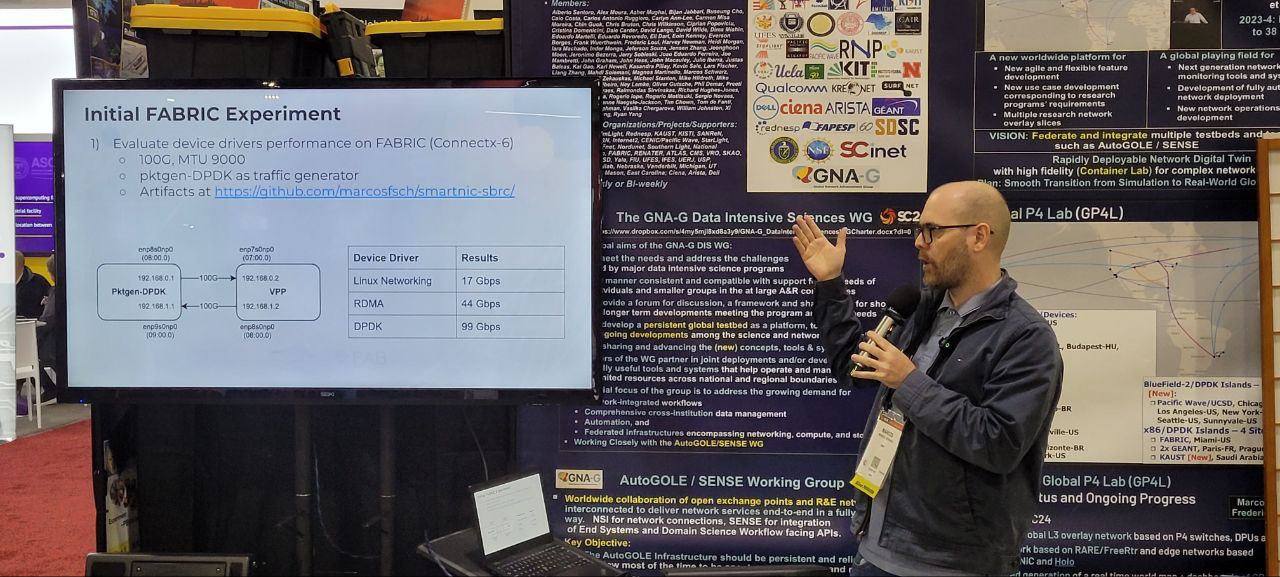 To handle terabit-per-second competing data flows across complex intercontinental networks for Data Intensive Science (DIS) research programs, the main goal of traffic steering is to optimize network resource use, enhance data transmissions’ performance, and ensure reliable and efficient network operation. These requirements are driven by the global distribution of DIS workflows and the demanding projections for the future. In this NRE, we present how PolKA (Polynomial Key-based Architecture) Source Routing (SR) offers Better, Faster, and Stronger functionalities to address the traffic steering challenges for DIS networks. To handle terabit-per-second competing data flows across complex intercontinental networks for Data Intensive Science (DIS) research programs, the main goal of traffic steering is to optimize network resource use, enhance data transmissions’ performance, and ensure reliable and efficient network operation. These requirements are driven by the global distribution of DIS workflows and the demanding projections for the future. In this NRE, we present how PolKA (Polynomial Key-based Architecture) Source Routing (SR) offers Better, Faster, and Stronger functionalities to address the traffic steering challenges for DIS networks.
SC24-NRE-036 PDF: Streaming Event Horizon Telescope Data to MIT-Haystack
Indiana University, #1401
The Event Horizon Telescope is an international collaboration of 11 Telescopes capturing images of black holes. The data captured is sent back to MIT-Haystack Observatory for processing. Currently this data is stored to disk and shipped to Haystack due to the volume of data captured. Each of these instruments have varying levels of connectivity to their regional, wide area, and international research and education (R&E) networks. This demonstration will show an increase in the speed to science by helping the EHT collaboration make better use of network resources available to transfer a subset of data to MIT-Haystack Observatory to confirm each site’s configuration before a full EHT run takes place.
2023
AmLight supporting Network Research Exhibition (NRE) demonstrations at SuperComputing (SC23)
November 12-18, 2023
The SC Conference Series serves as a testing ground for the latest advancements in high-performance networking, computing, storage, and analysis. Within this domain, the Network Research Exhibition (NRE) demonstrations harness the cutting-edge capabilities of SCinet, the dedicated high-capacity network of SC. Moreover, a curated group of NRE participants is annually welcomed to present their demo and experiment outcomes from the prior year’s conference in the Innovating the Network for Data-Intensive Science (INDIS) Workshop. In the current year, the AmLight infrastructure played a pivotal role by hosting several Network Research Exhibitions, bolstering high-performance showcases for Research and Educational Networks (RENs).
NRE-019 AmLight 2.0: Flexible control, deep visibility, and programmability @ Tbps!
Location: Caltech Booth (1255) & SCinet Theater (1275)
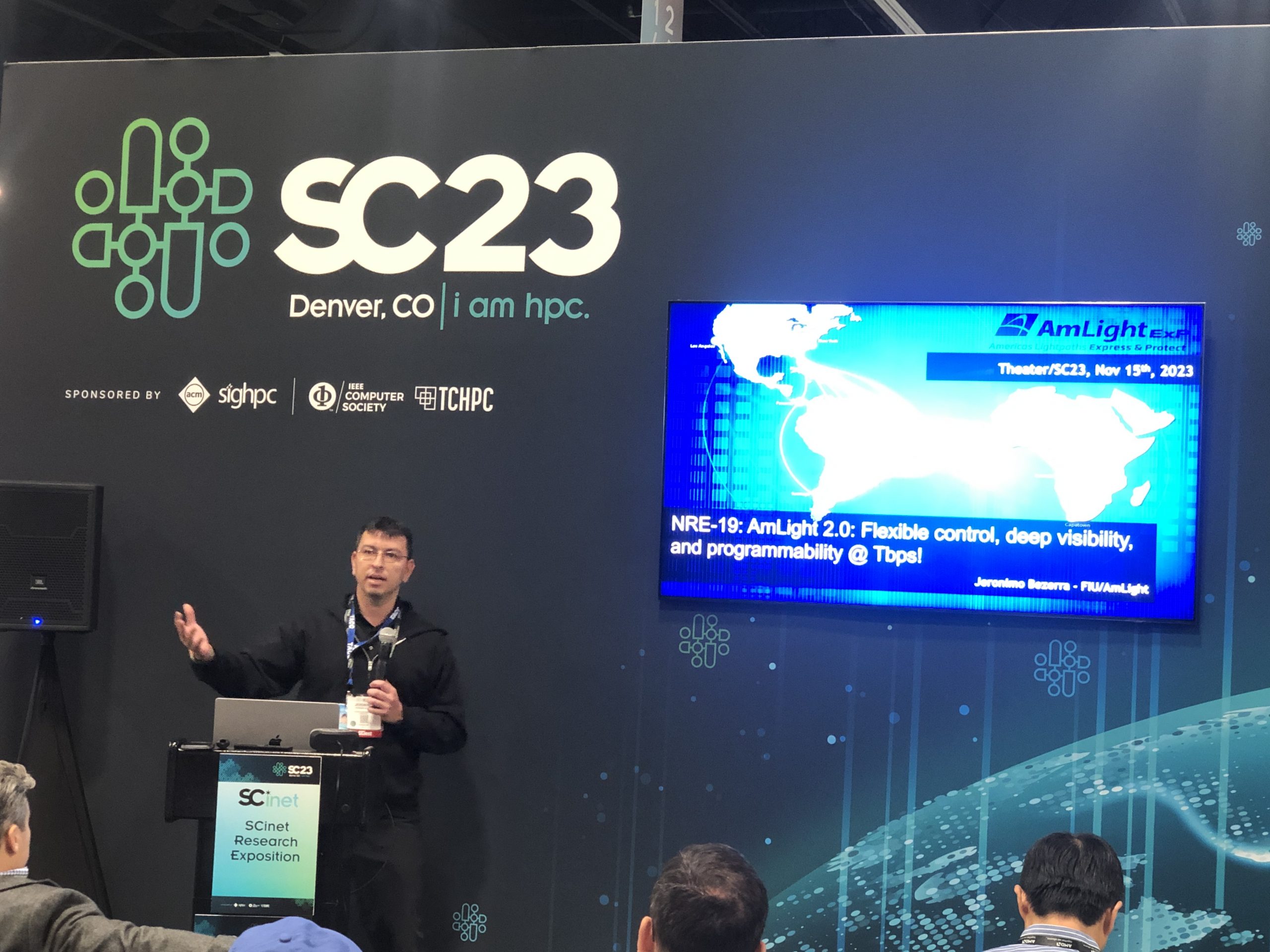 AmLight employs a hybrid network approach, combining optical spectrum and leased capacity to establish a cutting-edge and reliable network infrastructure dedicated to research and education. This network is vital for facilitating high-performance connectivity crucial to international collaborations in science, engineering, and education, particularly involving the National Science Foundation (NSF) research community. In 2023, AmLight rolled out its custom Software-Defined Networking (SDN) fabric, enabling network experimentation with P4 and flexible forwarding pipelines. This innovation, supported by the new SDN controller Kytos-ng, boasts more than 24 long-haul 100G links connecting key sites across the U.S., Latin America, and South Africa. AmLight’s SDN architecture, utilizing Edgecore Tofino 1 and Tofino 2, offers benefits like In-band Network Telemetry (INT) support and a flexible approach to pathfinding, finely tuned for traffic engineering support. AmLight employs a hybrid network approach, combining optical spectrum and leased capacity to establish a cutting-edge and reliable network infrastructure dedicated to research and education. This network is vital for facilitating high-performance connectivity crucial to international collaborations in science, engineering, and education, particularly involving the National Science Foundation (NSF) research community. In 2023, AmLight rolled out its custom Software-Defined Networking (SDN) fabric, enabling network experimentation with P4 and flexible forwarding pipelines. This innovation, supported by the new SDN controller Kytos-ng, boasts more than 24 long-haul 100G links connecting key sites across the U.S., Latin America, and South Africa. AmLight’s SDN architecture, utilizing Edgecore Tofino 1 and Tofino 2, offers benefits like In-band Network Telemetry (INT) support and a flexible approach to pathfinding, finely tuned for traffic engineering support.
NRE-013 Turbocharging 100G Link: A High-Speed Data Filling Demo from South Africa to Denver!
Location: Caltech Booth (1255) & SCinet Theater (1275)
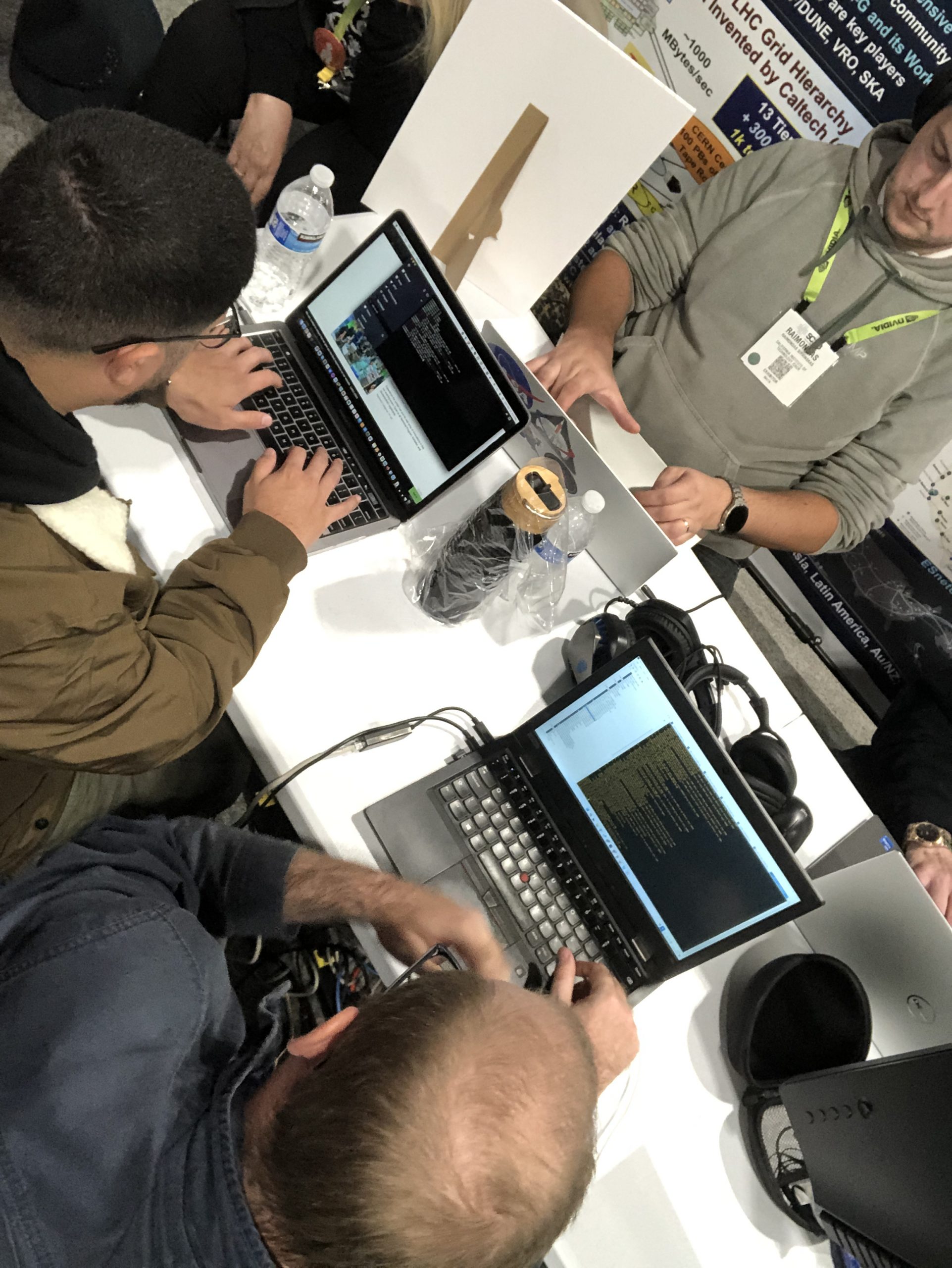 The AmLight network employs a hybrid strategy, combining optical spectrum and leased capacity to create a cutting-edge and dependable infrastructure supporting high-performance connectivity crucial for global science and engineering collaborations, especially with the NSF research community. The South African National Research Network (SANReN) group is instrumental in acquiring and implementing national and international capacity, aligning with the government’s cyberinfrastructure vision to enhance South African researchers’ global participation. Managed by CSIR’s Next Generation Enterprises and Institutions cluster, SANReN is a pivotal element of the National Integrated Cyberinfrastructure System (NICIS). The Tertiary Education and Research Network of South Africa (TENET) secures Internet and IT services for South African universities. The partnership with SANReN/TENET offers a unique opportunity to enhance AmLight-ExP’s 100G link using DTNs, and to monitor the link’s performance via diverse experiments. The demo aims to showcase the potential of the AmLight-SACS 100G link, fostering stronger collaborations between South Africa and the United States, while also exploring integration with CHPC and SANReN/TENET within the network of NRENs. The AmLight network employs a hybrid strategy, combining optical spectrum and leased capacity to create a cutting-edge and dependable infrastructure supporting high-performance connectivity crucial for global science and engineering collaborations, especially with the NSF research community. The South African National Research Network (SANReN) group is instrumental in acquiring and implementing national and international capacity, aligning with the government’s cyberinfrastructure vision to enhance South African researchers’ global participation. Managed by CSIR’s Next Generation Enterprises and Institutions cluster, SANReN is a pivotal element of the National Integrated Cyberinfrastructure System (NICIS). The Tertiary Education and Research Network of South Africa (TENET) secures Internet and IT services for South African universities. The partnership with SANReN/TENET offers a unique opportunity to enhance AmLight-ExP’s 100G link using DTNs, and to monitor the link’s performance via diverse experiments. The demo aims to showcase the potential of the AmLight-SACS 100G link, fostering stronger collaborations between South Africa and the United States, while also exploring integration with CHPC and SANReN/TENET within the network of NRENs.
NRE-020 Global P4 Lab
Location: SCinet Theater (1275)
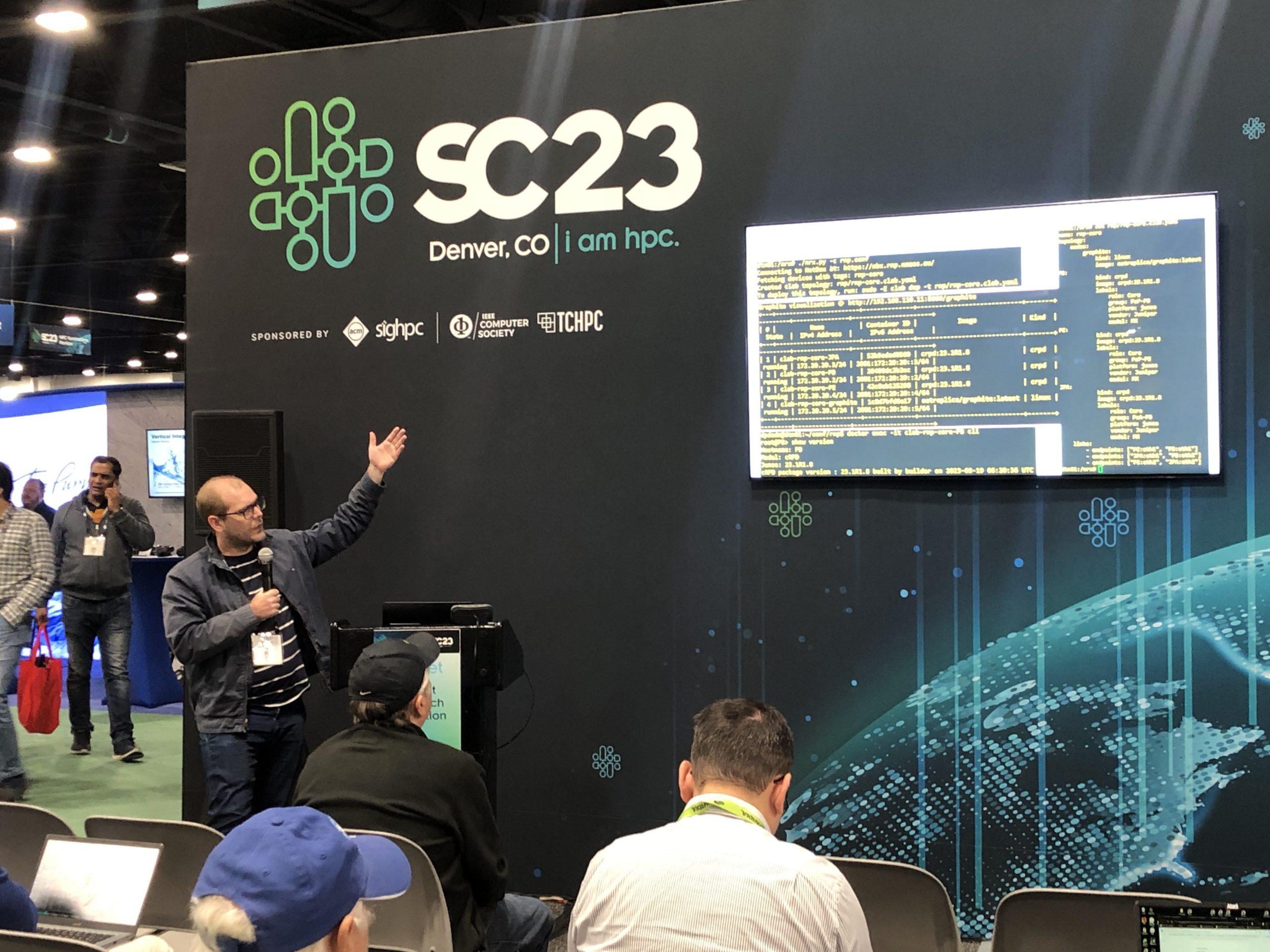 GP4L (Global P4 Lab) is a global overlay network composed of 100G/400G programmable switches from the GNA-G AutoGOLE / SENSE Persistent Multi-Resource Testbed and the GÉANT P4 Lab. The GP4L uses SONiC and RARE/FreeRtr, which are full-featured open-source network operating systems (NOSes), that at the same time implement traditional networking protocols and can be extended to integrate next-generation features as an opt-in strategy. GP4L provides the means to implement production-oriented feature experimentations and protocols, without impacting the rest of the network. This showcase will include demonstrations of newly deployed sites and interconnections with other testbeds like FABRIC and BRIDGES, Digital Twin capabilities, automated generation of real-time world map topology, and also support other NREs that are experimenting with at-scale advanced/novel networking protocols and use cases, like PolKA (Polynomial Key-based Architecture): a stateless source routing protocol based on arithmetic operations over a polynomial encoded route label. Also supported was IPv6 Flow Label Packet Marking initiative from WLCG, called SciTags. GP4L (Global P4 Lab) is a global overlay network composed of 100G/400G programmable switches from the GNA-G AutoGOLE / SENSE Persistent Multi-Resource Testbed and the GÉANT P4 Lab. The GP4L uses SONiC and RARE/FreeRtr, which are full-featured open-source network operating systems (NOSes), that at the same time implement traditional networking protocols and can be extended to integrate next-generation features as an opt-in strategy. GP4L provides the means to implement production-oriented feature experimentations and protocols, without impacting the rest of the network. This showcase will include demonstrations of newly deployed sites and interconnections with other testbeds like FABRIC and BRIDGES, Digital Twin capabilities, automated generation of real-time world map topology, and also support other NREs that are experimenting with at-scale advanced/novel networking protocols and use cases, like PolKA (Polynomial Key-based Architecture): a stateless source routing protocol based on arithmetic operations over a polynomial encoded route label. Also supported was IPv6 Flow Label Packet Marking initiative from WLCG, called SciTags.
NRE-013 The Global Network Advancement Group: A Next Generation System for Data Intensive Sciences
Location: Caltech Booth (1255) & SCinet Theater (1275)
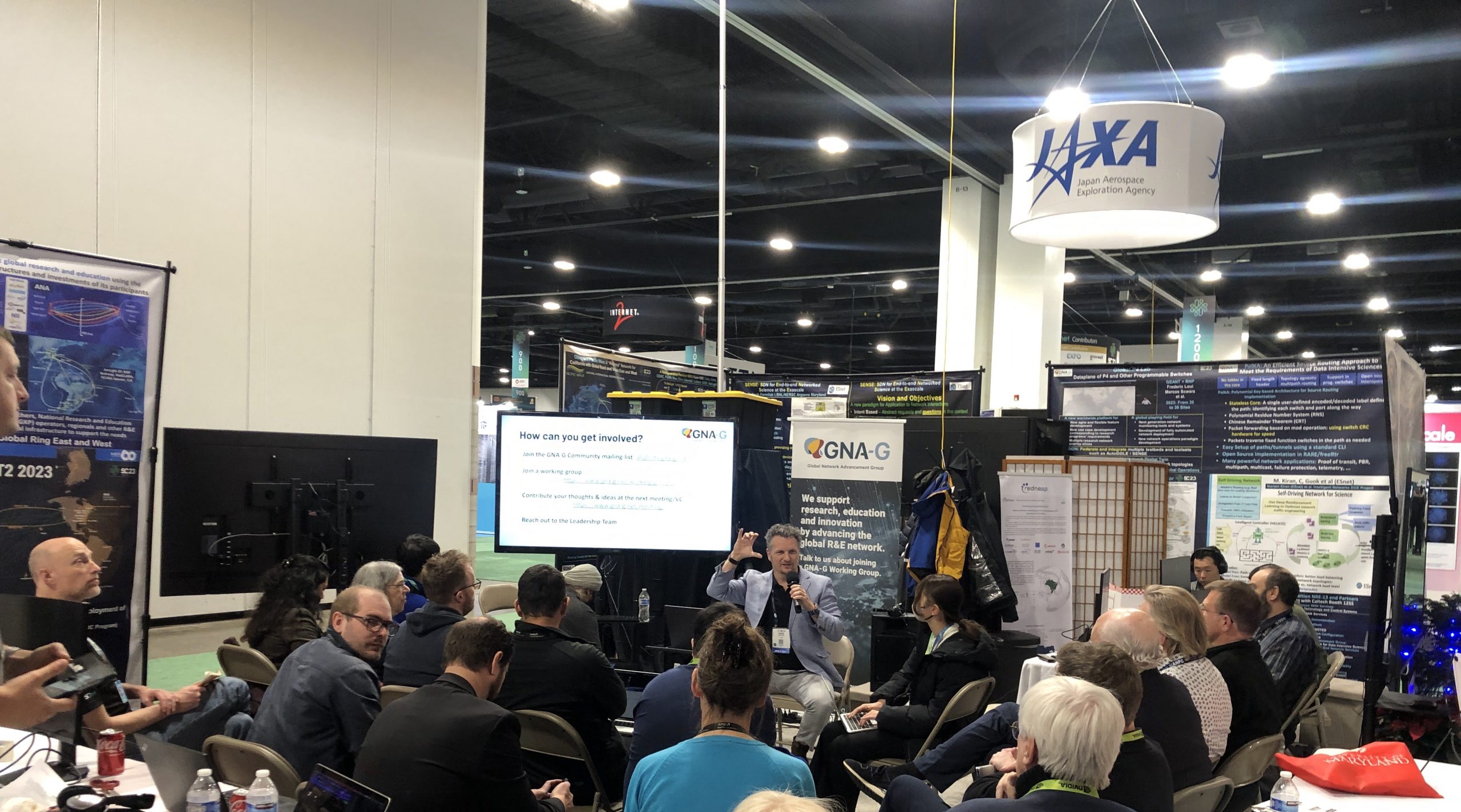 The Global Network Advancement Group, along with its Data Intensive Sciences and SENSE/AutoGOLE Working Groups, is collaborating globally to create a cutting-edge, integrated network system to address the challenges of exabyte and terabit/sec workflows, crucial for various scientific domains including high energy and astrophysics, bioinformatics, and data-intensive sciences. This initiative, known as the network research exhibition (NRE), showcased and demonstrated key aspects of this next-generation system, highlighting its potential to revolutionize research and education network operations. The NRE teams were focused on developing a dynamic, adaptive, programmable software-driven system that treats worldwide networks as a top-tier resource, seamlessly integrating them with computing and storage across diverse domains, ultimately optimizing network resources and streamlining workflows. The Global Network Advancement Group, along with its Data Intensive Sciences and SENSE/AutoGOLE Working Groups, is collaborating globally to create a cutting-edge, integrated network system to address the challenges of exabyte and terabit/sec workflows, crucial for various scientific domains including high energy and astrophysics, bioinformatics, and data-intensive sciences. This initiative, known as the network research exhibition (NRE), showcased and demonstrated key aspects of this next-generation system, highlighting its potential to revolutionize research and education network operations. The NRE teams were focused on developing a dynamic, adaptive, programmable software-driven system that treats worldwide networks as a top-tier resource, seamlessly integrating them with computing and storage across diverse domains, ultimately optimizing network resources and streamlining workflows.
NRE-014 AutoGOLE/SENSE: End-to-End Network Services and Workflow Integration
Location: Caltech Booth (1255) & SCinet Theater (1275)
 The AutoGOLE/SENSE and Data Intensive Sciences working groups within the Global Network Advancement Group represent a global collaboration involving R&E network operators, system developers, software developers, and scientists from various disciplines. The AutoGOLE/SENSE infrastructure offers multiple provisioning options, including OpenNSA, SURF ultimate Provider Agent (SuPA), MEICAN, and SENSE, which integrates network and end-system resources into a unified provisioning environment. The demonstration showcased how domain science applications can seamlessly integrate these services into their workflows through API-driven information discovery and service provisioning. The infrastructure enabled intercontinental data flows across high-performance R&E networks with DTN-based endpoints, depicted in the diagram above. At the campus level, connectivity beyond 100G was demonstrated at Caltech, UCSD, and Berkeley Lab (LBL), supported by CENIC and Ciena Waveserver Ais at Caltech and Los Angeles. The AutoGOLE/SENSE and Data Intensive Sciences working groups within the Global Network Advancement Group represent a global collaboration involving R&E network operators, system developers, software developers, and scientists from various disciplines. The AutoGOLE/SENSE infrastructure offers multiple provisioning options, including OpenNSA, SURF ultimate Provider Agent (SuPA), MEICAN, and SENSE, which integrates network and end-system resources into a unified provisioning environment. The demonstration showcased how domain science applications can seamlessly integrate these services into their workflows through API-driven information discovery and service provisioning. The infrastructure enabled intercontinental data flows across high-performance R&E networks with DTN-based endpoints, depicted in the diagram above. At the campus level, connectivity beyond 100G was demonstrated at Caltech, UCSD, and Berkeley Lab (LBL), supported by CENIC and Ciena Waveserver Ais at Caltech and Los Angeles.
2023 Internet2 Technology Exchange
September 18-22, 2023

The 2023 Internet2 Technology Exchange was the event where global leaders convened to ensure the R&E community moved forward, together.
TechEX23 boasted an exceptional lineup of expert-led sessions, tutorials, working meetings, and co-located events, all designed to tackle the most pressing challenges and discover solutions in the realm of research & education.
The event featured five tracks for knowledge exchange & growth: Advanced networking, Cloud technology, Federated trust, identity, and access management, Information security, and Research engagement and innovation.
The Power of Community-Driven Content: The topics featured in the sessions were thoughtfully submitted and presented by the community, for the community. This ensured that the program was tailored to address the real-world issues faced by professionals, offering insights and strategies that made a genuine impact.
Jeronimo Bezerra and Renata Frez presented several updates on AmLight infrastructure
Title: A Scalable Solution to Detect Microbursts
Short abstract: Detecting microbursts presents a persistent challenge for research and education networks (REN) and commercial internet service providers due to their sporadic and short-lived nature, often slipping past conventional network monitoring tools. These sudden bursts of traffic, lasting mere milliseconds, significantly affect data transfers and can cause costly performance issues in both long-haul and regional networks. The rise of programmable network devices with Intel Tofino ASIC and P4 has sparked an increasing interest in addressing this issue. While many solutions leverage programmable devices, implementing additional stages to the forwarding pipeline may not always be feasible, particularly for RENs supporting a range of protocols and functions. Consequently, out-of-band solutions employing technologies like In-band Network Telemetry (INT) and traffic mirroring have gained traction, enabling microburst detection through bandwidth utilization measurements at sub-second intervals. To enhance detection, an adaptive and efficient solution has been developed, aiming to evaluate and store granular counters selectively based on operator-defined metrics, effectively identifying microbursts as short as 20 milliseconds while managing resource usage. Read the full abstract here.
Title: DDoS Detection/Mitigation @ AmLight
Short abstract: Recent years have seen a rise in cyber attacks targeting Government and Research & Education facilities, as highlighted by Cloudflare. As an International Research and Education Network, AmLight provides vital academic and commodity connectivity across the USA, Latin America, and Africa. The network supports diverse science drivers with varying levels of infrastructure robustness, ranging from multiple 100 Gbps connections to 10 Gbps or less. However, even a 1Gbps attack can disrupt operations for some connectors within AmLight. To counter these threats effectively, a multi-tier DDoS Detection/Mitigation Model has been implemented. The model includes three levels: Tier 1 focuses on large-scale attack mitigation, leveraging a scrubbing service provided by AmLight’s primary upstream provider. Tier 2, on the other hand, detects and mitigates small-scale attacks through a cloud-based DDoS detection solution, allowing customization and federated management by individual connectors for enhanced resilience. Read the full abstract here.
More details about the event can be found here: https://internet2.edu/2023-internet2-technology-exchange/
ACCESS STEP 1 Workshop
May 15-27, 2023

Florida International University recently hosted a two-week Student Training and Engagement Program (STEP) workshop from May 15 to 27 in Miami, Florida. The workshop, organized by ACCESS Operations, aimed to equip students with marketable skills in areas such as operations, data and networking, and cybersecurity. With a focus on recruiting students from underrepresented groups and women, STEP aims to promote diversity in STEM fields.
The workshop provided a platform for 15 students to explore various areas of interest within the field, such as web programming, high-performance computing, cybersecurity, networking, and practical applications of AI. Participants had the opportunity to discover their specific interests and gain insight into the areas of study they should consider pursuing in the future. The workshop fostered high levels of direct interaction among diverse groups with a wide range of skill sets, creating a rich and collaborative learning experience.
The project was on collaboration with Indiana University which is the lead institution of the ACCESS STEP project. ACCESS is an advanced computing and data resource supported by the National Science Foundation and made possible through these lead institutions and their partners – Carnegie Mellon University; University of Colorado Boulder; University of Illinois at Urbana-Champaign; and State University of New York at Buffalo.
More details about ACCESS: https://access-ci.org/
CI Lunch and Learn talk: Microburst Detection at AmLight
April 21 and July 7, 2023
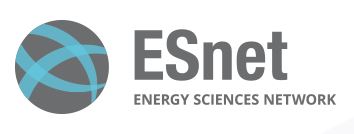 On Friday, April 21st and July 7th at 2 pm Miami time, Jeronimo Bezerra, CIARA Associate Director, will be presenting at the CI Lunch and Learn community talks on Microburst Detection. The focus will be on an adaptive and efficient approach to detect microbursts leveraging per-packet telemetry in a production network. On Friday, April 21st and July 7th at 2 pm Miami time, Jeronimo Bezerra, CIARA Associate Director, will be presenting at the CI Lunch and Learn community talks on Microburst Detection. The focus will be on an adaptive and efficient approach to detect microbursts leveraging per-packet telemetry in a production network.
Part I presentation slides here.
Part I Video recording here.
Part I presentation slides here.
Part I Video recording here.
2022
Internet2 Technology Exchange 2022
December 5-9, 2022
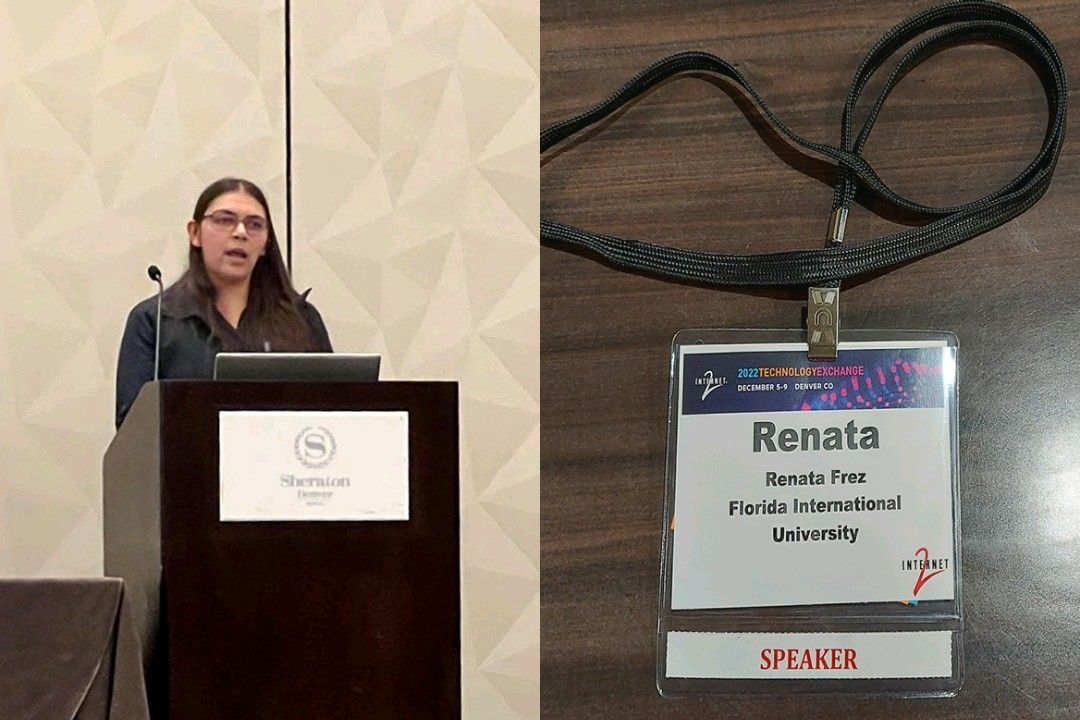 Renata Freez, Dr. Julio Ibarra, and Jeronimo Bezerra participated in the Internet2 Technology Exchange which is a premier technical event in the global research and education community. The goal is to convene technologists, scientists, engineers, architects, analysts, students, and anyone passionate about technology, innovation, and challenging tasks. TechEx provides a forum for debate and discussion that enable timely conversations critical to ensuring that we, as a community of technology leaders committed to supporting research and collaboration, are aligned and are moving forward together. Renata Freez, Dr. Julio Ibarra, and Jeronimo Bezerra participated in the Internet2 Technology Exchange which is a premier technical event in the global research and education community. The goal is to convene technologists, scientists, engineers, architects, analysts, students, and anyone passionate about technology, innovation, and challenging tasks. TechEx provides a forum for debate and discussion that enable timely conversations critical to ensuring that we, as a community of technology leaders committed to supporting research and collaboration, are aligned and are moving forward together.
Renata Freez presented “Evaluating INT, JTI, and sFlow @ AmLight” at the Advanced Networking session
For more information click here
AmLight supporting Network Research Exhibition (NRE) demonstrations at SuperComputing (SC22)
November 13-18, 2022
 The SC Conference Series is a test bed for cutting-edge developments in high-performance networking, computing, storage, and analysis. Network Research Exhibition (NRE) demonstrations leverage the advanced capabilities of SCinet, SC’s dedicated high-capacity network. The SC Conference Series is a test bed for cutting-edge developments in high-performance networking, computing, storage, and analysis. Network Research Exhibition (NRE) demonstrations leverage the advanced capabilities of SCinet, SC’s dedicated high-capacity network.
Additionally, each year, a selection of NRE participants are invited to share the results of their demos and experiments from the preceding year’s conference as part of the Innovating the Network for Data-Intensive Science (INDIS) Workshop. Network researchers and professionals from government, education, research, and industry are invited to submit proposals for demonstrations and experiments at the SC Conference that display innovation in emerging network hardware, protocols, and advanced network-intensive scientific applications.
This year the AmLight infrastructure carried out multiple Network Research Exhibitions to support Research and Educational Networks (RENs) high-performance showcases.
For more information click here
The 3rd Global Research Platform Workshop (3GRP)
October 10-11, 2022
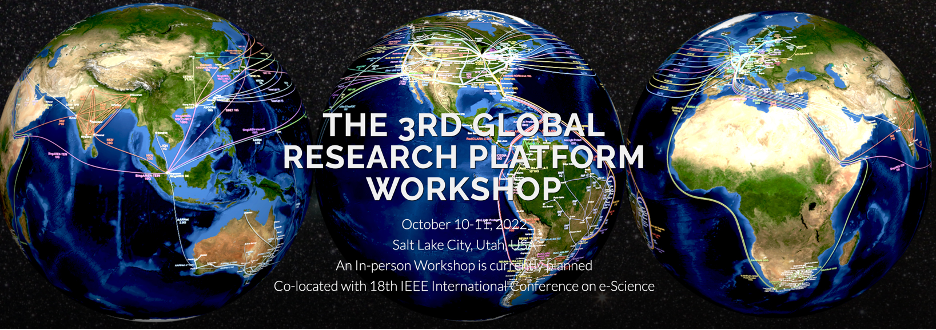
The 3rd GRP Workshop (3GRP) is co-located with the 18th IEEE International Conference on e-Science. Both audiences share common interests, content, and culture. Co-location provides attendees with the option to register for both events.
The Global Research Platform (GRP) is an international scientific collaboration to create innovative advanced ubiquitous services that integrate resources around the globe at speeds of gigabits and terabits per second, especially for large-scale data-intensive science research. GRP focuses on design, implementation, and operation strategies for next-generation distributed services and infrastructure to facilitate high-performance data gathering, analytics, transport, computing, and storage among multiple science sites at 100 Gbps or higher. GRP community partners are in North America, Asia, Europe, and South America and work together to customize international fabrics and distributed cyberinfrastructure to support optimal data-intensive scientific workflows.
3GRP focuses on recent and emerging advances in architectures, services, technologies, and infrastructures. Speakers explain how their innovations can directly support global science research. The 3GRP Workshop program is being designed around seven themes: (a) Next-Generation Research Platforms; (b) Orchestration Among Multiple Domains; (c) Large-Scale Data Transport; (d) High-Fidelity Data Flow Monitoring, Visualization, Analytics, Diagnostics, Event Correlation, AI/ML/DL; (e) Data-Intensive Science and Programmable Networking; (f) Network and Communication Service Automation; and, (g) International Testbeds for Data-Intensive Science.
The Americas’ Research Platform (AmRP) Workshop will be held October 11, 1:00pm – 5:00pm. AmRP consists of North, Central and South America GRP participants and their key international partners and has its own agenda, distinct from the GRP Workshop. See AmRP website for more information.
For more information click here
Presentation can be found here
FIU AmLight supporting the Advanced Cyberinfrastructure Coordination Ecosystem: Services & Support (ACCESS)
August 22, 2022
Research cyberinfrastructure ecosystems are catalysts for discovery and innovation that play a critical role in ensuring U.S. leadership in science and engineering. An investment in national research cyberinfrastructure serves the evolving needs of the research community, increases economic competitiveness and opportunity, and strengthens national security.
The U.S. National Science Foundation announced an additional investment of $52 million through the Advanced Cyberinfrastructure Coordination Ecosystem: Services & Support, or ACCESS, program. ACCESS will improve the accessibility of national cyberinfrastructure centers and increase integration with systems and research communities on campuses across the nation. The 2022 ACCESS awardee teams comprise 71 researchers, students, staff and more than 90 partner organizations across the country. The five 2022 ACCESS awardees will work to improve the agility, accessibility, usability and coordination of the research cyberinfrastructure ecosystem.
The NSF funded five awards for five independently managed yet tightly-coordinated services defined in the following five tracks: (1) Allocation Services; (2) End User Support Services; (3) Operations & Integration Services; (4) Monitoring & Measurement Services; and (5) Technology Translation Services. Together, these services are expected to provide a seamless experience for an increasing breadth of research users across a highly performing innovative array of national computational computing resources.
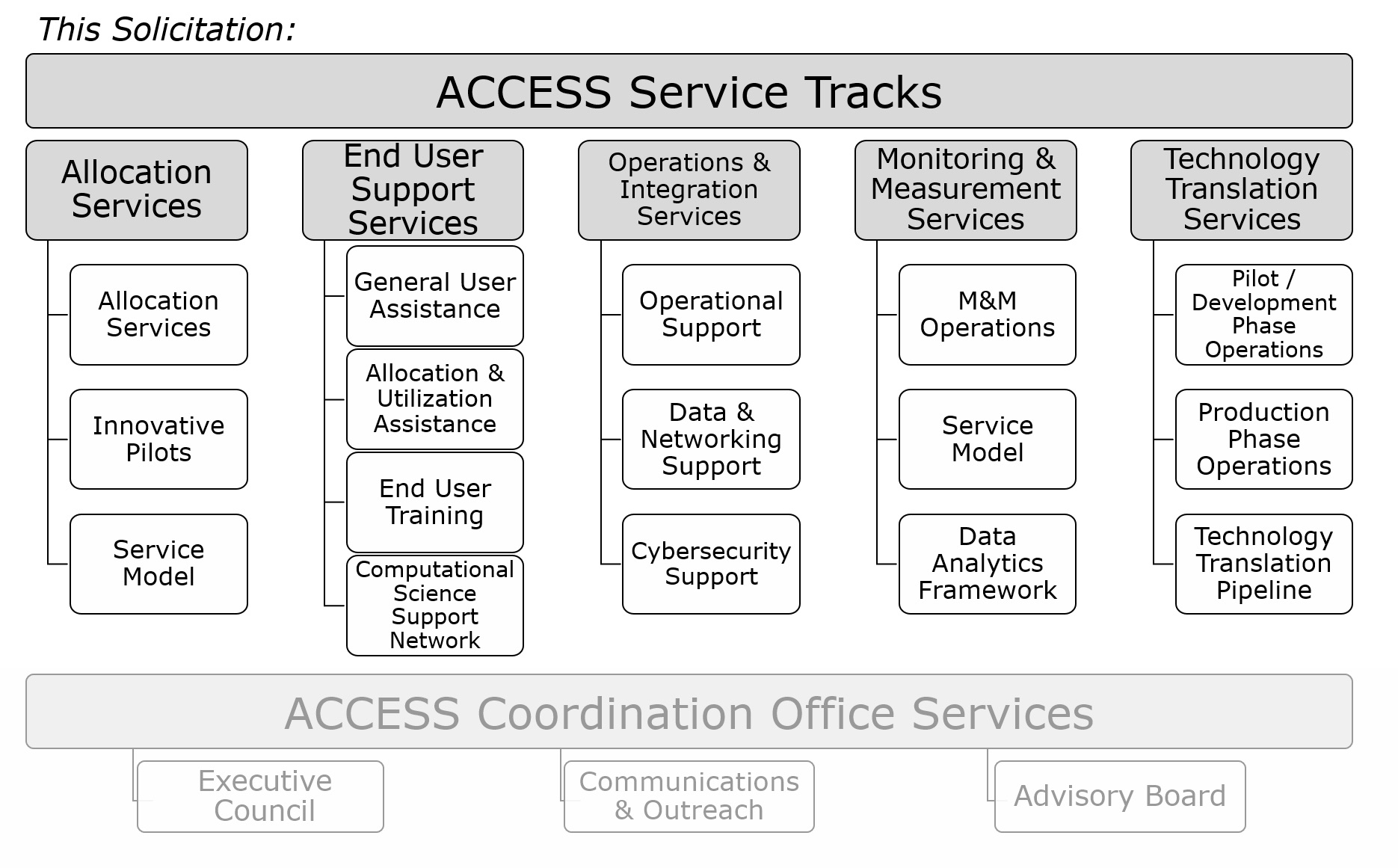
FIU and AmLight are participating in Track 3: Operational & Integration Services with sub-award “The COre National Ecosystem for CyberinfrasTructure (CONECT) Award” to provide operations, data and networking, and cybersecurity support.
CONECT will be led by NCSA in partnership with the Florida International University, Indiana University, PSC, the San Diego Supercomputer Center at UC San Diego and the University of Chicago.
ACCESS’s CONECT project is a $20 million, five-year award, that delivers innovative integrations across the NSF-funded cyberinfrastructure ecosystem in operations, data, networking, and cybersecurity. Research and education in science and engineering are increasingly reliant on a seamlessly integrated, secure and robust ecosystem of advanced computing, data technologies, and human expertise. CONECT will employ agile mechanisms to integrate rapidly diversifying non-traditional resources by building on the successes of its predecessors to create a more dynamic, inclusive, reliable and secure ecosystem.
For more information click here

Bridging Europe, Africa and the Americas (BEAA) – New Collaboration for shared transoceanic R&E networking resilience
April 6, 2022
Seven leading regional and national Research and Education networks and organisations across multiple continents announced the establishment of the “Bridging Europe, Africa and the Americas” (BEAA) Collaboration, aiming to increase the resilience of their networks across a set of transoceanic links that interconnect their communities in Eastern and Southern Africa, Europe and Latin America.
The BEAA Collaboration was formalised through a Memorandum of Understanding (MoU), signed between Amlight/the Florida International University Board of Trustees, GÉANT, RedCLARA, RNP, the Council for Scientific and Industrial Research (CSIR), TENET and the UbuntuNet Alliance. All partners agreed to collaborate for an initial period of three years, by providing mutual back-up through high-capacity links and resources.
Back-up connectivity enabled by the agreement will ensure that advanced Research and Education collaborations among the regions will continue even in case of service outages. Participating organisations will use the capacity provided by the agreed back-up arrangements to carry high volumes of data required for data-intensive research, including – notably – Earth Observation (EO) data of the European Union’s Copernicus programme.
Opening a new chapter in the R&E collaboration between Europe, Africa and the Americas, the BEAA agreement showcases an increasingly resilient, flexible and interconnected global R&E networking ecosystem, apt to support scientists worldwide in tackling the big scientific challenges of our times.
To read the full pressrelease click here

CISE Distinguished Lecture Series: Julio Ibarra- Americas-Africa Lightpaths Express and Protect (AmLight-ExP) Networks
January 13, 2022
Dr. Julio Ibarra presented "Americas-Africa Lightpaths Express and Protect (AmLight-ExP) Networks" at the National Scince Foundation (NSF) CISE Distinguished Lecture Series.
The NSF-sponsored AmLight Express and Protect (AmLight-ExP) network links the scientific research and education (R&E) communities in the U.S. to Latin America, Africa, and the U.S. territories of the Caribbean. Over the past 15 years, under the stewardship of NSF Office of Advanced Cyberinfrastructure, Florida International University (FIU) with its partners, have evolved a network infrastructure that connects four continents; peers with R&E networks in Brazil, Chile, Panama, South Africa, Puerto Rico, and the U.S. Virgin Islands; and operates a production R&E network with an upstream aggregate bandwidth capacity of 600 Gbps. As a project focused on production R&E networking and network innovation, this talk will present how AmLight-ExP is leveraging technology innovations, such as In-band Network Telemetry (INT), autonomic networking functions, Software-Defined Networking (SDN)/Software Defined Exchanges (SDX) to respond to the growing complexity of its environment and increasing demand for bandwidth, lower latency and jitter, customized traffic prioritization, and SLA-grade network resilience.
NSF Public Attachments:
Transcript
Audio recording
Slides (PDF version)
Video Recording (Presentation view)

AMPATH Joins MANRS Initiative to Improve Routing Security
December 2021
 MANRS has the following objectives: (1) Raise awareness of routing security problems and encourage the implementation of actions that can address them; (2) Promote a culture of collective responsibility towards the security and resilience of the Internet’s global routing system; (3) Demonstrate the ability of the Internet industry to address routing security problems; and (4) Provide a framework for network operators to better understand and address issues relating to the security and resilience of the Internet’s global routing system. To achieve such objectives, MANRS recommends four actions: filtering non-compliant packets and advertisements, implementing anti-spoofing techniques, improving coordination between network operators, and deploying a global validation trusting mechanism. As a member of MANRS, AMPATH is ready to prevent the propagation of invalid routing information, avoid traffic from spoofed sources, and facilitate communication between service providers. More information about MANRS can be found at https://www.manrs.org/. MANRS has the following objectives: (1) Raise awareness of routing security problems and encourage the implementation of actions that can address them; (2) Promote a culture of collective responsibility towards the security and resilience of the Internet’s global routing system; (3) Demonstrate the ability of the Internet industry to address routing security problems; and (4) Provide a framework for network operators to better understand and address issues relating to the security and resilience of the Internet’s global routing system. To achieve such objectives, MANRS recommends four actions: filtering non-compliant packets and advertisements, implementing anti-spoofing techniques, improving coordination between network operators, and deploying a global validation trusting mechanism. As a member of MANRS, AMPATH is ready to prevent the propagation of invalid routing information, avoid traffic from spoofed sources, and facilitate communication between service providers. More information about MANRS can be found at https://www.manrs.org/.
In the scope of MANRS, AMPATH has deployed the Resource Public Key Infrastructure (RPKI). RPKI is a solution to validate inter-domain received prefixes and detect anomalies, thereby avoiding the use of hijacked prefixes and delivering a reliable and secure experience to the Internet community. The validation results are used not only for the routing decision at AMPATH, but they are advertised to connectors to support their routing policies.
The AMPATH and AmLight community members benefit from the increased security of elements that connect to the Internet, thus reducing vulnerability to malicious attacks and increasing the robustness of the global routing table used for data traffic worldwide. “AMPATH is excited to be a member of the MANRS community and to contribute towards making the Internet more secure,” said Dr. Julio Ibarra, Principal Investigator of AMPATH. RNP’s Associate Director of Engineering and Operations Ari Frazão Jr. stated “For us at RNP, we are going to be able to benefit from an infrastructure that follows the good security practices recommended by MANRS, which certainly brings us a very important gain“.
The AMPATH BGP Policy is available at https://ampath.net/policies.
2021

Pegasus and AtlanticWave-SDX Help Orchestrating Science Applications
April 5, 2021
Many new technologies and new paradigms are emerging in the research community to support science workflows, including the use of Data Transfer Nodes (DTNs), distributed compute and data infrastructure, research testbeds, and new inter-domain federated orchestrators. Workflow management systems (WMS), like Pegasus, are evolving to be more resource aware in order to make more intelligent decisions on dispatching and coordinating computation and data transfer jobs.
For global-scale scientific applications, Open Exchange Points (OXP) are the critical communication infrastructure to connect the compute resources and the data intensive instruments that are often located in different continents. For nearly a decade, Software Defined Networking (SDN) has been introduced into the OXP domains to create a Software Defined eXchange (SDX) that can dramatically improve the network utilization, programmability, and the efficiency to manage network resources. This opens the door to allow the resource orchestrator and application software to make the best use of the networking capabilities in real time.
The collaboration between the Pegasus and AtlanticWave-SDX (AW-SDX) projects demonstrates our vision to develop an end-to-end resource orchestration framework that will enable intelligent interactions between the scientific workflows and the network substrate.
The AtlanticWave-SDX (AW-SDX) project (NSF OAC-1451024 and 1451024, 2015-2025) changed how domain scientists and network engineers can use Open Exchange Points (OXPs) to support science workflows. The AW-SDX team developed an inter-domain SDX platform to link a large number of data sources and scientific users to the advanced distributed OXPs across Miami, Atlanta, Latin America, and South Africa towards an open, innovative platform while continuously enhancing their production capacity and service capabilities.
To read the full article click here.
ESnet and FIU Receive NSF Award for Q-Factor
March 23, 2021
 Energy Science Network (ESnet) and Florida International University (FIU) received a two-year National Science Foundation (NSF) Office of Advanced Cyberinfrastructure research grant for “Q-Factor: A framework to enable high-speed data transfer optimization based on real-time network state information provided by programmable data planes.” (NSF Award Abstract #2018754)
As the trend towards data-intensive research continues, scientists and campus IT experts are investing significant resources to facilitate the efficient movement of large datasets between geographically distributed sites. Because many university campus networks are not currently configured to support the data movement requirements of data-intensive science, campus researchers require new tools to address poor network performance.
To help address this problem, FIU and ESnet are planning to research, prototype, and deploy new technology named “Q-Factor.” The central focus of Q-Factor research will be the creation of a novel telemetry agent that will be capable of dynamically tuning data transfer parameters at rapid sub-second intervals using temporal network state information collected from programmable data planes. Q-Factor will enhance inter-campus data transfers performed over regional, national, and international networks without requiring changes to end-user applications.
Science applications, such as the Vera Rubin Observatory, the Open Science Grid, the Large Hadron Collider (LHC) high luminosity experiments, and big data science drivers will benefit from the increased bandwidth utilization provided by Q-Factor.
“The cost of achieving effective end-to-end performance is high for network operators, because of the lack of real-time network state information. Q-Factor is an exciting research opportunity for FIU and ESnet to create knowledge that will benefit domain scientists and their network-dependent applications,” said Julio Ibarra, Q-Factor co-principal investigator and assistant vice president of technology augmented research at FIU.
“At ESnet, we are excited to partner with FIU to further advance our network’s capabilities, increase the performance of scientific data transfers, and unleash the potential in programmable data plane telemetry,” said Richard Cziva, Q-Factor co-principal investigator and software engineer at Lawrence Berkeley National Laboratory.
For the FIU press release click here.
For the ESnet press release click here.
To visit the Q-Factor Website click here.

2020
Americas-Africa Lightpaths Express and Protect (AmLight-ExP)Enhanced Infrastructure for Research and Education
Miami, FL October 20, 2020
Miami, Florida, October 20, 2020 – Florida International University’s Center for Internet Augmented Research and Assessment (CIARA), in the Division of IT, is pleased to announce a new $3.8M five-year award from the U.S. National Science Foundation (NSF), Award# OAC-2029283, for the International Research and Education Network Connections Core program: Americas-Africa Lightpaths Express and Protect (AmLight-ExP) project.
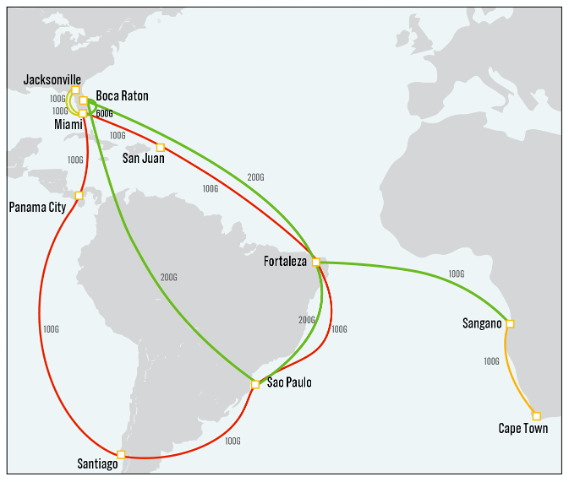 Big data science in South America and Sub-Saharan Africa will be dramatically evolving over the next five years, with increasing dependency on advanced cyberinfrastructure and programmable networking. Significant projects include the Vera Rubin Observatory in Chile, Brazilian participation in the High Luminosity Large Hadron Collider experiments at CERN, and the Square Kilometer Array in South Africa.
“This is great news for the development of astronomy in Chile, especially with the construction and soon commissioning of the Rubin telescope, which will have the largest digital camera in the world. The advanced cyberinfrastructure delivered by the Americas-Africa Lightpaths Express and Protect network will be a key element to continue developing first-class science and to be able to share these discoveries with local communities through our education and outreach programs,” said Mario Hamuy, AURA Vice President and Head of Mission, Chile.
The AmLight Express and Protect (AmLight-ExP) project enables high-throughput consortium funded network connectivity required by international science and engineering research and education collaborations involving the NSF research community, with expansion to South America and West Africa.
“The Brazilian Education and Research Network, RNP, has collaborated very closely with FIU/CIARA since their first IRNC award in 2005, in improving the quality and robustness of the international connections between the USA, South America and, most recently, Africa. Thus, we celebrate the new award extending this collaboration for a further 5 years. We are pleased to bring together researchers and students between the Americas and Africa. This is a milestone for RNP. Our partnerships and the support of NSF and MCTI have opened direct South-South links of great capacity that will boost education, science and also reinforce the remarkable cooperation among Portuguese-speaking communities on both continents”, said Nelson Simoes, RNP Director.
AmLight-ExP is a reliable, resilient, leading-edge software-defined network infrastructure for research and education. In the map, the Express network consists of the green paths; the Protect network consists of the red paths. With significant and critical investments from the Academic Network of São Paulo (ANSP); Brazil’s Research and Education (R&E) network (RNP); the Association of Universities for Research in Astronomy (AURA); the regional network of Latin America (RedCLARA); and the national R&E network of S. Africa (TENET/SANReN), the total bandwidth provided by AmLight ExP between the U.S., South America, and Africa is expected to grow to over 4 Terabits per second in aggregate capacity by 2025. Duncan Greaves, CEO of TENET said, “We congratulate FIU/CIARA on securing this award and we're delighted to see AmLight-ExP advancing. Important research endeavors in South Africa and Africa more generally will benefit notably, as will international research co-operation among the Americas and Africa.”
This flexible inter-regional infrastructure enables science communities to expand research and learning activities, empowered through access to scalable optical spectrum on submarine cables and programmable networks. “The Academic Network of Sao Paulo provides connectivity to more than 50 institutions, which are responsible for more than 40 percent of Brazilian science production. This new award by the NSF to FIU is a major milestone for the AmLight-ExP project, underpinned by our partnership with FIU, RNP, and AmLight consortium partners for 15+ years”, said Joao Eduardo Ferreira, Principal Investigator of ANSP.
“The approval of this new funding agreement awarded to the Florida International University’s Center for Internet Augmented Research and Assessment (CIARA) is excellent news for the scientific community in Latin America and Africa. The improved connectivity in the following years will help us strengthen the cooperation between our continents and provide additional capacity to the already in place link with Africa,” said Luis Eliecer Cadenas, RedCLARA Executive Director.
FIU’s AmLight-ExP project aims to increase the rate of discovery. Faster discovery means quicker focus on the greatest benefit for society. AmLight-ExP is a catalyst for new communities of researchers and learners with a bridge, linking U.S., Latin American and African students, teachers and researchers. AmLight-ExP is committed to serving the needs of graduate and undergraduate education through models that bring together students and the networking community with scientists from all domains.
“The increased capacity that the AmLight-Exp project will unlock between Africa and Latin America will not only significantly improve research collaboration between the two regions, but it will also provide the Americas with unparalleled access to African hosted science initiatives (such as the South African hosted SKA1-mid telescope and its precursor, the MeerKAT telescope) and vice versa. I believe tertiary education will also benefit from this initiative as it will assist in breaking down the barriers that hamper students on both continents from gaining crucial hands-on experience using NREN connected research infrastructures” stated Leon Staphorst, Director of SANReN.
“The awarding of this grant comes at the right moment when UbuntuNet Alliance recently signed a Memorandum of Understanding with RedCLARA and is Co-PI in the Network for European, American, African, and Arctic Research (NEAAAR) project. Our involvement in the Americas-Africa Lightpaths Express and Protect (AmLight-ExP) puts us in a core position to enhance our collaboration with global research and education networking players as this complements the existing partnerships with our sister organizations in Africa and with GEANT in Europe. The awarding of this grant draws us closer to our objective of being integrated in the global research and education network and that of providing state-of-the-art Internet connectivity and infrastructure that give our researchers and students a gateway to the global research and education network”, said Matthews Mtumbuka, Chief Executive Officer of UbuntuNet Alliance.
For the press release click here.

AtlanticWave-SDX: A Distributed Intercontinental Experimental Software Defined Exchange
Miami, FL October 16, 2020
Miami, Florida, October 16, 2020 – Florida International University’s Center for Internet Augmented Research and Assessment (CIARA), in the Division of IT, is pleased to announce a new $6.5M five-year award from the U.S. National Science Foundation (NSF), Award# OAC-2029278, for the AtlanticWave-SDX: A Distributed Intercontinental Experimental Software Defined Exchange.
Open Exchange Points (OXPs) serve as meet points for connecting and facilitating the exchange of data between Research and Education (R&E) networks. They are critical cyberinfrastructure in the interconnectivity of data over long geographical distances, switching data flows from one R&E network to the next, to its destination. They require this unique effort in networking science to perform efficiently and effectively. For example, data from the Vera Rubin Observatory in northern Chile will transit six OXPs as it moves from the Southern to Northern Hemispheres. Operationalizing the transit of data flows across OXPs is increasingly important to minimize the impact from events on network services (hardware failures and soft failures). End-to-end network paths for these data flows are not under the control of any individual organization. Multiple R&E network operators collaborate and must coordinate to establish geographically distributed end-to-end paths – an effort that can take days to weeks.
Led by FIU, with the University of Southern California – Information Sciences Institute (USC-ISI), and the Renaissance Computing Institute (RENCI) at the University of North Carolina at Chapel Hill this award takes off from the previous five-year project work. AtlanticWave-SDX supports research, experimental deployments, prototyping and interoperability testing, on national and international scales.
Prof. Sérgio Novaes, Scientific Director of the Center for Scientific Computing at the Sao Paulo State University (UNESP) said, “The AtlanticWave-SDX will use several science drivers as use cases that I lead for UNESP including the Open Science Grid (OSG), the High Energy Physics Information Exchange (HEPiX) and the Advanced Institute for Artificial Intelligence (AI2). AI is playing a very important role in HEP and there are, of course, several possible intersections with other areas. UNESP has been an active partner in previous IRNC proposals led by FIU and the annual Super Computing Network Research Experiments and is an enthusiastic collaborator on the AtlanticWave-SDX advancements.”
Challenges in the Wide-Area Networks (WAN) are being addressed by the application of network virtualization and network programmability solutions using Software-Defined Networking (SDN) and Network Functions Virtualization (NFV) technologies. Network virtualization and programmable networks are two key enablers that facilitate agile, fast and more economical network infrastructures as well as service development, deployment and provisioning. This award for the AtlanticWave-SDX project will introduce new capabilities, enabling OXPs to react to unplanned network events by adding intelligent closed-loop control of network services powered by in-band network telemetry.
“We are excited to work with CIARA at FIU on this important next step towards establishing networks as a provisioned resource” said Frank Wuerthwein, Open Science Grid Executive Director.
“Pegasus bridges scientific domains and the execution environment by automatically mapping high-level workflow descriptions onto distributed resources. Pegasus has been used in a number of scientific domains including astronomy, bioinformatics, earthquake science, gravitational wave physics, ocean science, limnology, and others. We look forward to collaborating with the AtlanticWave-SDX team to enhance resource sharing and improve the movement of data with minimal latency,” said Ewa Deelman Research Director, Science Automation Technologies, USC Information Sciences Institute.
AtlanticWave-SDX is comprised of two network science initiatives: An infrastructure development component with optical super channels to reframe and reprovision network capacity between R&E backbone networks; and, an innovation component to develop a distributed intercontinental experimental SDX by leveraging OXPs in the U.S., Chile, Brazil, and S. Africa.
“The Atlantic-Wave-SDX project broadens the scope and usage of the leading-edge terabit-scale Software Defined Networking solutions NoviFlow has delivered in partnership with FIU. We are truly gratified to see our efforts with FIU contribute not only to the advancement of networking science, but also in real-world applications benefiting leading academic researchers around the world,” said Dominique Jodoin, NoviFlow’s President and CEO.
For the press release click here.
AmLight Express and Protect interconnects three continents by activating 100G end-to-end links between the U.S., Brazil and South Africa
Miami, FL March 1, 2020
Miami, Florida, March 1, 2020 – Florida International University (FIU), Rede Nacional de Ensino e Pesquisa (RNP), Tertiary Education and Research Network of South Africa and South African National Research Network (TENET/SANReN), and Angola Cables are pleased to announce the activation of lightpaths initially provisioned at 100Gbps linking North America, South America, and Africa for research and education.
The Americas Africa Research and eduCation Lightpaths (AARCLight) project (NSF OAC-1638990) provided support for a grant to plan, design, and define a strategy for high-capacity research and education network connectivity between the U.S., Brazil, and West, Central and Southern Africa. The study indicated a high level of enthusiasm to engage in collaborative research among the U.S., Brazil and the African communities.
The AmLight-SACS project (NSF OCI-1937344), successfully established a 100G pathway using the South Atlantic Cable System (SACS) and West African Cable System (WACS), to extend the AmLight-ExP network from Fortaleza, Brazil to ZAOXI open exchange point in Cape Town, South Africa.
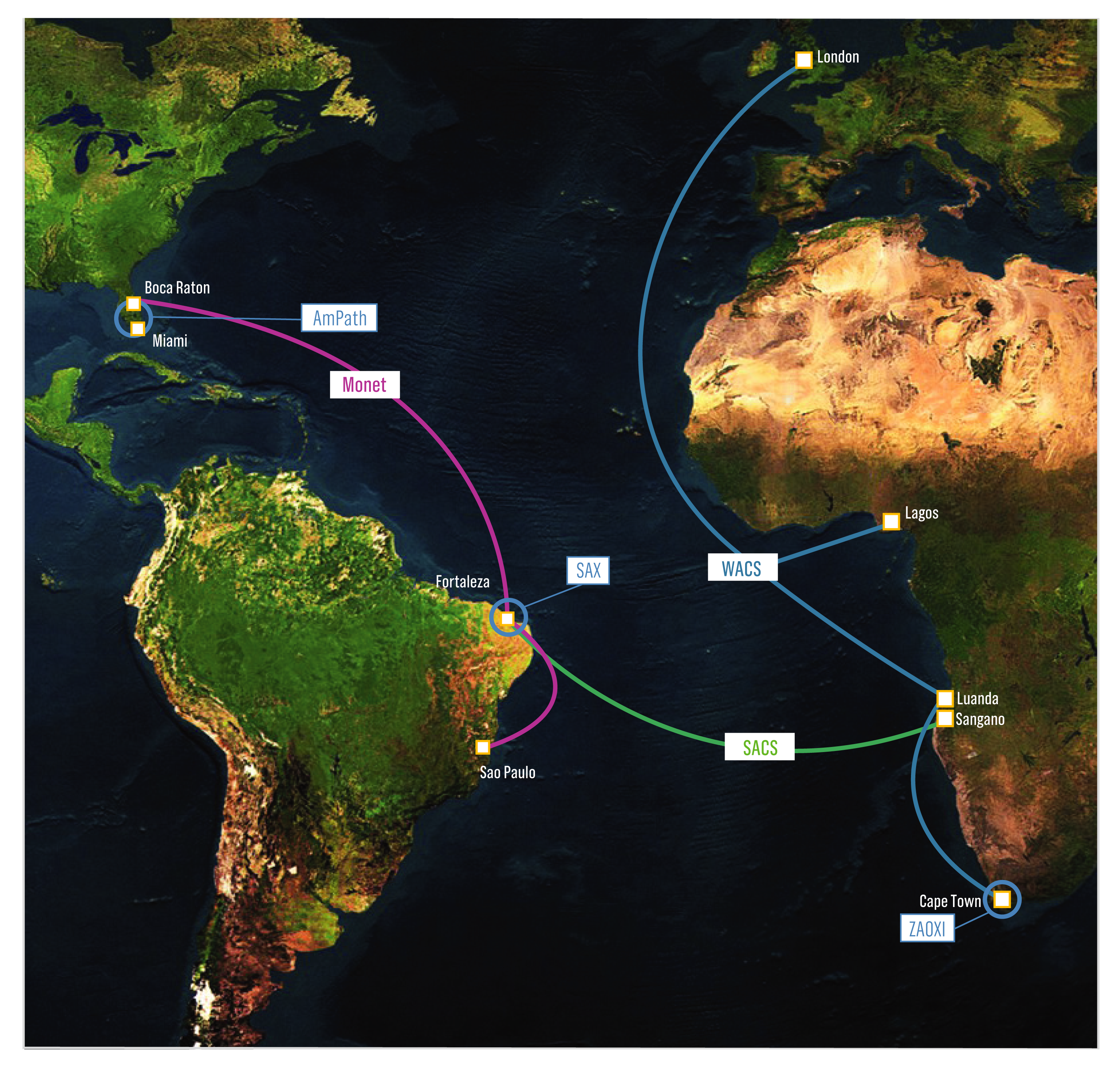
“AARCLight and AmLight-SACS have succeeded due to strong and consistent collaboration between the partners. Linking the U.S., Brazil and the nations of Africa to support robust research and education networking using a novel South Atlantic route is the culmination of 3 years of careful planning and execution. Enhancing the technological and social connections in many science disciplines including astronomy, biodiversity and genomics are anticipated to accelerate the rate of discovery while providing a diverse networking path for all collaborators”, said Heidi Morgan, Co-Principal Investigator and lead for the AmLight-SACS project.
AmLight-SACS leverages the network infrastructure in the southern hemisphere that is available to the R&E community. Using optical spectrum on Monet, AmLight-ExP links AMPATH R&E Exchange Point in Florida (USA) to South America eXchange (SAX) in Fortaleza (Brazil) at 200Gbps. SAX R&E Exchange Point is operated by RNP. Using optical spectrum on SACS, AmLight-ExP provisioned a 100G pathway from Fortaleza to Sangano (Angola). TENET/SANReN capacity on WACS was used to activate a 100G pathway between Sangano and ZAOXI R&E exchange point, in Cape Town. At ZAOXI, the Ubuntunet Alliance Network connects East Africa.
The SACS cable system between Fortaleza, Brazil, and Sangano, Angola, is the first modern east-west subsea cable in the South Atlantic. The activation of the AmLight-SACS path adds redundancy and resiliency to the global R&E network fabric by providing a transatlantic route across the South Atlantic, shortening paths from the Southern Hemisphere countries to Africa and Europe. The newly established connection provides a baseline for planning the next generation of collaborations involving major scientific instruments, safe in the understanding that there will be efficient, available, and unmediated connectivity and capacity between the continents.
To evaluate the connectivity, two 100G nodes at AMPATH were configured to generate packets that flowed from Miami, Florida to TENET/SANReN’s router at ZAOXI in Cape Town and back to Miami. The figure below shows the network utilization at 99Gbps for a period of one hour.

“The AmLight-SACS project exemplifies FIU’s Worlds Ahead mission as an international leader in Research & Education Networking to advance scholarship through high-quality teaching, state-of-the-art research and creative activity, and collaborative engagement with its local and global communities. FIU is strengthening its ties and expanding its research around the world with our South American and African collaborators! All of this is possible because of the dedication this international project team has put into the first ever South Atlantic R&E network crossing between three continents” said Julio Ibarra, Principal Investigator of AmLight.
“TENET is honoured to have been part of this project and we are delighted that it is coming to fruition. Entire ranges of research problems will in the future depend for their resolution upon multi-partner, multi-continent collaborations such as this. We are especially pleased that African researchers stand to gain substantial benefits from the project” said Duncan Greaves, CEO of the Tertiary Education and Research Network of South Africa (TENET).
“We, at UbuntuNet Alliance, are excited to witness this major milestone of the AARCLight and AmLight-SACS Project which promises to resolve most of our major digital challenges facing our research and education communities in Africa. Cost, speed and access have been a major challenge in relation to satisfying the connectivity needs of our research and education communities and this project is well positioned to help solve these challenges in addition to opening wide opportunities for research collaboration and knowledge sharing between the three continents”, said Matthews Mtumbuka, CEO of UbuntuNet Alliance.
“In the 30 years since its launch as an academic network project, RNP has always supported international collaboration with similar initiatives around the world. The recent availability of the high capacity SACS link from Fortaleza to Angola has at last provided us with a direct physical connection to Africa which will complement our existing major links to the US and Europe. The new South America eXchange in Fortaleza will bring together RNP, RedClara and many other global research and education networks. These significantly lower latency routes to Africa will support much closer Americas engagement in education, research, development and cultural activities with African partners”, said Nelson Simões, CEO of the Brazilian Education and Research Network (RNP).
“The in-service of SACS between Brazil and Angola opens new opportunities for collaboration between research and education communities in Africa, Latin America and the US, with much less latencies than on previous routes. Moreover, it provides the opportunity to move on with the planned establishment of a Global Exchange Point in Lagos, using the SACS and WACS submarine cable systems”, said Boubakar Barry, CEO of West and Central African Research and Education Network (WACREN).
For full pressrelease click here.

2019
The Relevance of Software Defined Exchange Points in the path of scientific workflows
November 17, 2019, Denver, CO
This year the Innovating the Network for Data-Intensive Science (INDIS) is excited to bring two distinguished keynote speakers: Awanish Verma, Director Marketing NFV, Acceleration Wired & Wireless Group at Xilinx and Julio Ibarra, Assistant Vice President of Technology Augmented Research at Florida International University. Supercomputing conference 2019 (SC19) hosted the 6th annual INDIS workshop on Sunday, November 17, 2019 at the Colorado Convention Center, Denver, CO.
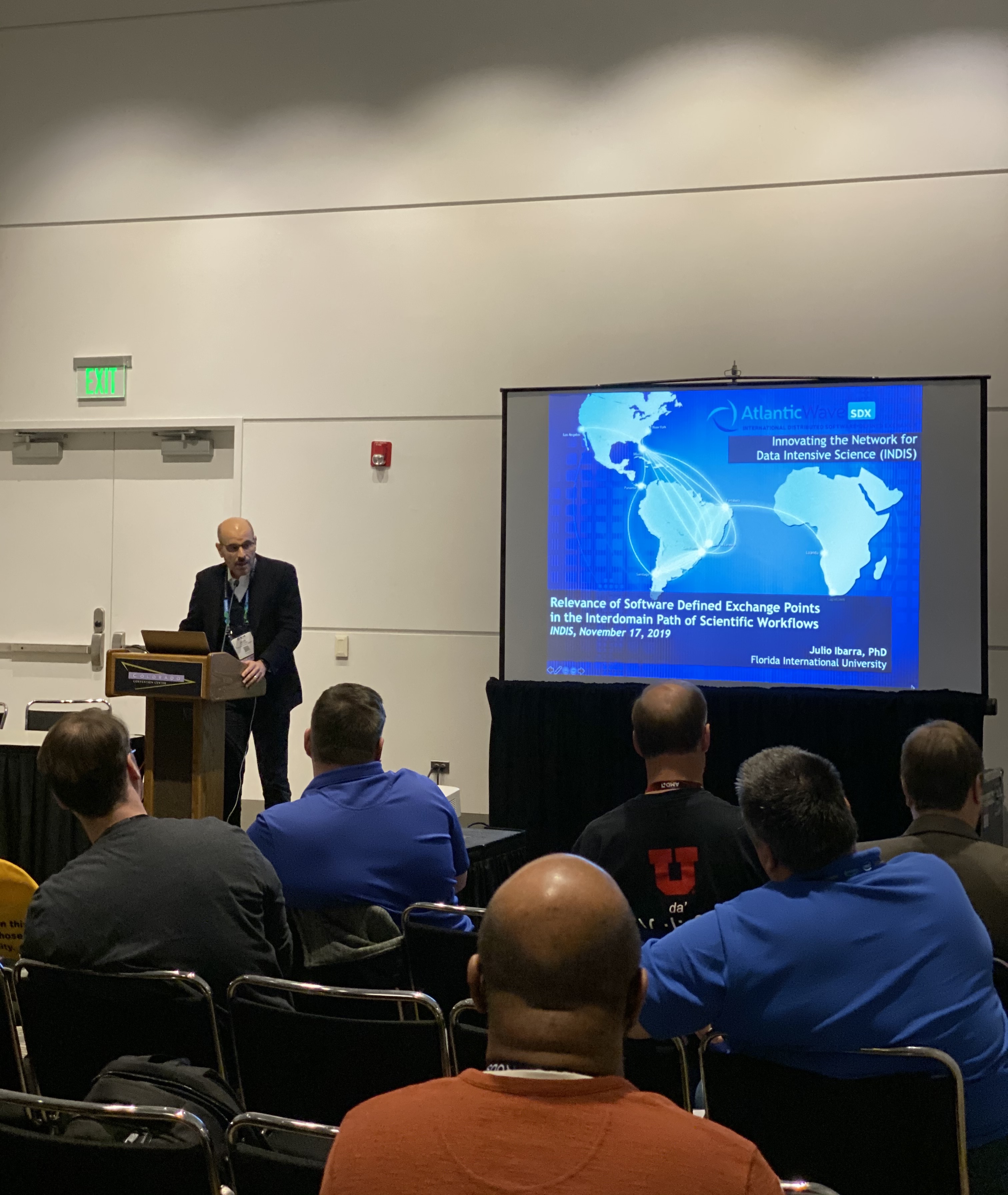
Wide area networks are now an integral and essential part of this data-driven supercomputing ecosystem connecting information sources, data stores, processing, simulation, visualization, and user communities together. Networks for data-intensive science have more extreme requirements than general-purpose networks. These requirements not only closely impact the design of processor interconnects in supercomputers and cluster computers, but they also impact campus networks, regional networks and national backbone networks. This workshop brings together the network researchers and innovators to present challenges and novel ideas that stretch network research and SC’s own innovative network, SCinet. The event offers discussions that propose new and novel techniques to present solutions for meeting these networking needs; and developments that are essential in the information systems infrastructure for the scientific discovery process.
Dr. Julio Ibarra presented “The Relevance of Software Defined Exchange Points in the path of scientific workflows” at the INDIS workshop which brings together network engineers and researchers to share challenges and potential solutions in the information systems and networking communities.
Abstract: International research network connections are increasing, providing new paths for scientific workflows to move data and work across continents: In the north Atlantic between North America and Europe, the Advanced North Atlantic (ANA) collaboration operates 740G of distributed bandwidth capacity; between the U.S. and South America, the AmLight Express and Protect (AmLight-ExP) project added three 200G optical waves between Florida and Brazil, for a total capacity of 630Gbps; the AmLight-SACS project will be activating a 100G optical wave between Brazil and Angola, establishing a new south Atlantic route between the Americas, Africa and Europe; and Bella, a project led by RedCLARA and GEANT, will provide new high-capacity network paths between South America and Europe. While this phenomenon provides the opportunity for network operators to add resiliency to the global R&E fabric, it also adds complexity to network management and traffic engineering.
Software Defined Exchange points (SDX) provide enhanced capabilities to simplify flow-management and enable new network services. Unlike traditional exchange points, an SDX controller has global visibility of the network topology, making it possible to maintain related states for the full path of a flow. This presentation will describe what an SDX is and why SDXs are relevant to scientific workflows in the global R&E network fabric. The AtlanticWave-SDX project and its SDX controller will be presented as a novel distributed programmable controller along with use cases for two science drivers. Results from extensive experiments in a testbed will be presented that demonstrate the AtlanticWave-SDX controller’s high performance in terms of scalability, response time, and resource utilization, which are extremely important to support advanced scientific applications. Finally, future work will be described to clarify where SDXs can have an impact on the global R&E network fabric.
More details about the SC19 INDIS Workshop can be found here.
Collaborating to leverage R&E network infrastructures between Africa, Brazil, and the U.S.
Antananarivo, Madagascar on October 31- November 1, 2019
Dr. Heidi Morgan presented “Collaborating to leverage R&E network infrastructures between Africa, Brazil, and the U.S.” introducing the AmLight-South Atlantic Cable System (SACS) project at the UbuntuNet Connect 2019 Conference which took place in Antananarivo, Madagascar on October 31- November 1, 2019. Dr. Morgan also participated in a roundtable discussion focused on roles of different key players in the promotion of collaboration in the digital space. The moderator for the session was RENU CEO, Nicholas Mbonimba.
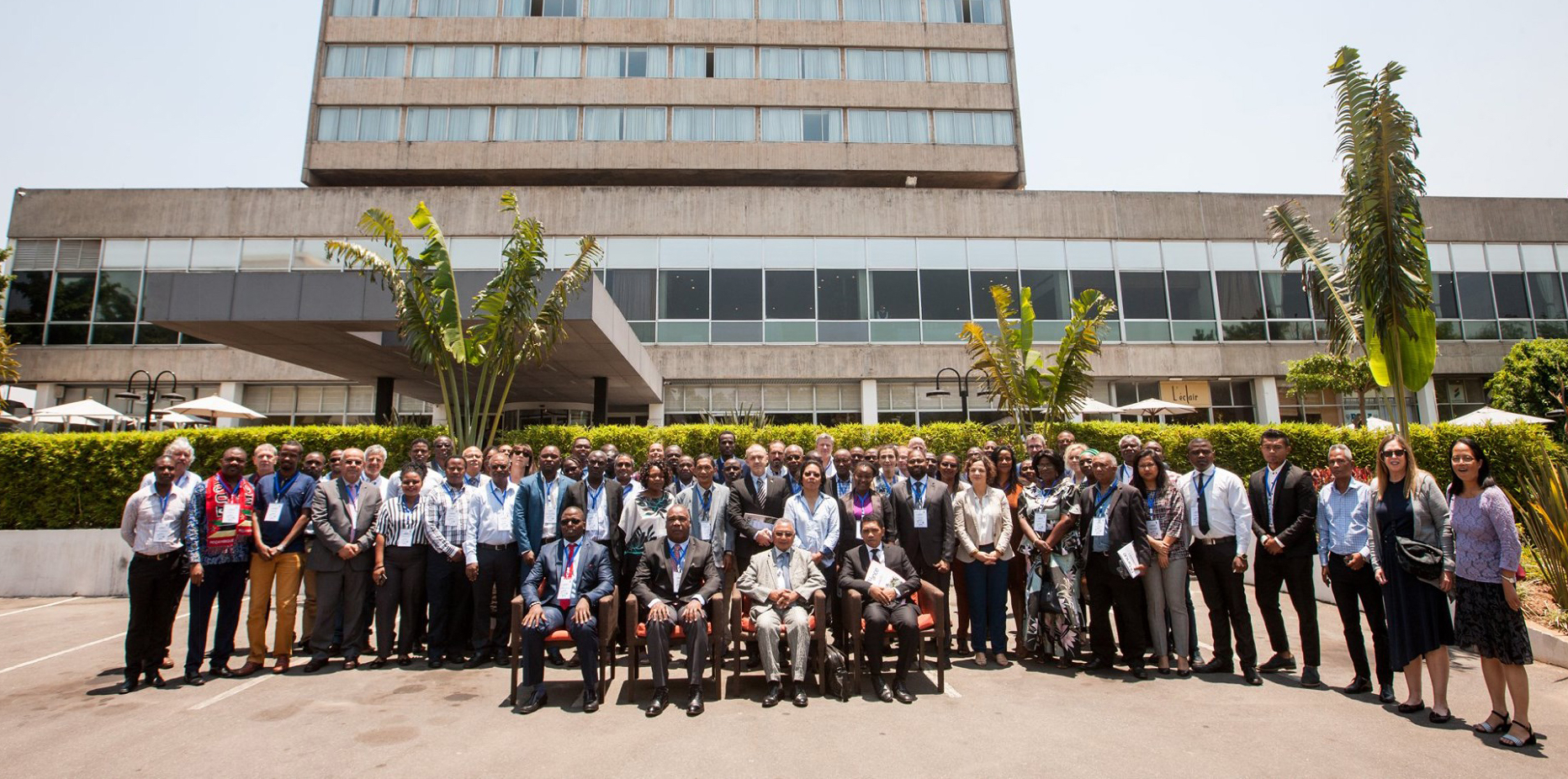
UbuntuNet-Connect, the annual conference of UbuntuNet Alliance, has the theme: NRENs: “Facilitating Collaboration in the Digital Space.” The conference was hosted by the Research and Education Network for Academic and Learning Activities, iRENALA, the NREN of Madagascar. UbuntuNet-Connect brought together practitioners in the research and education networking community, researchers, policymakers, academicians, connectivity providers, and a pool of expertise from across Africa and beyond.
More details about the UbuntuNet Connect 2019 Conference can be found here.
Florida International University (FIU) is a participating site for the FABRIC project as a Science Design Driver and Resource Provider
Miami, Florida, October 9, 2019
Florida International University (FIU) is a participating site for the FABRIC project as a Science Design Driver and Resource Provider. Additionally, FABRIC will be connected to the AmLight network for international research collaborations with researchers in South America and the Caribbean.
Through a $20 million grant from the National Science Foundation (NSF), a collaborative project has begun among universities nationwide to enable a faster and more secure internet. FIU is one of the universities selected to participate. The project, called FABRIC, will provide a coast-to-coast testbed for reimagining how data can be stored, computed and moved through shared infrastructure. Researchers will explore and test novel internet frameworks to help determine the internet architecture of the future.
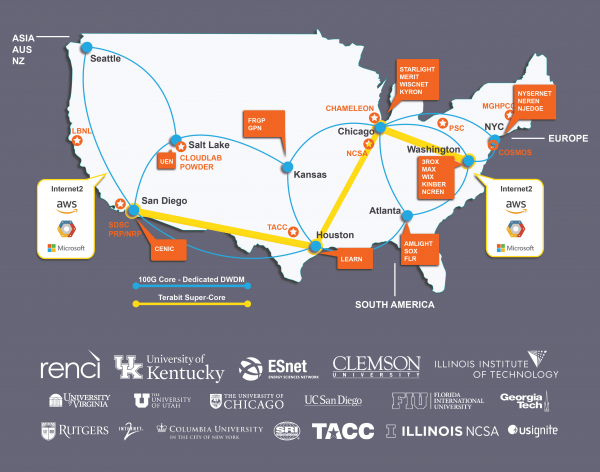
“We look forward to FABRIC enabling researchers throughout the nation to develop and test new networking technologies and capabilities,” said Erwin Gianchandani, acting assistant director for computer and information science and engineering at the National Science Foundation. “This project will lead to novel paradigms for next-generation networks and services, giving rise to future applications advancing science and the economy.”
FABRIC will consist of storage, computational and network hardware nodes interconnected by high speed, dedicated optical links. These nodes will be deployed across the country and also in major national research facilities, universities and supercomputing centers to generate and process scientific data sets.
The infrastructure will enable cutting-edge research in networking, cybersecurity, machine learning, distributed computing and storage systems. It will explore the balance between the amount of information a network maintains, the network’s ability to process information and its scalability, performance and security.
Julio Ibarra, assistant vice president of technology augmented research at FIU’s Division of Information Technology, and Alex Afanasyev, assistant professor for the School of Computing and Information Sciences within the College of Engineering & Computing, are representing FIU as FABRIC contributors and senior personnel.
“FIU is providing infrastructure development of technology software for future evolution of the internet,” said Ibarra, who is the lead on fabric node operations. Afanasyev is overseeing the effort in deploying new addressable networking technologies.
See official press release here.
AmLight Express and Protect project adds three 200Gbps optical waves for Research and Education between the U.S. and Brazil
Miami, Florida, August 30, 2019
Florida International University (FIU), Rede Nacional de Ensino e Pesquisa (RNP), Academic Network of Sao Paulo (ANSP), the Association of Universities for Research in Astronomy (AURA), and Angola Cables are pleased to announce the addition of three 200Gbps optical waves for research and education between the U.S. and Brazil. These three 200Gbps optical waves represent the Express path of the AmLight Express and Protect (AmLight-ExP) project, a 5-year National Science Foundation (NSF) award to FIU (OAC-1451018), and with support from AURA, and the AmLight Consortium.
The Express path is built upon the Monet submarine cable system, linking the U.S. to Brazil, and operated by Angola Cables. The approach chosen to add these new optical waves was through the use of optical spectrum, where Angola Cables assigned a total of 150GHz over the Monet submarine cable system to be used by the AmLight Consortium. The AmLight Consortium uses the 150GHz spectrum to create three 200Gbps optical waves between Boca Raton, Fortaleza, and Sao Paulo. Each optical wave enables the use of two 100Gbps client ports. The Express path is represented in the figure by the solid green segments, where each segment represents a 100Gbps link from the 200Gbps optical wave; the Protect path is represented by the other segments in the figure that form a ring around South America.
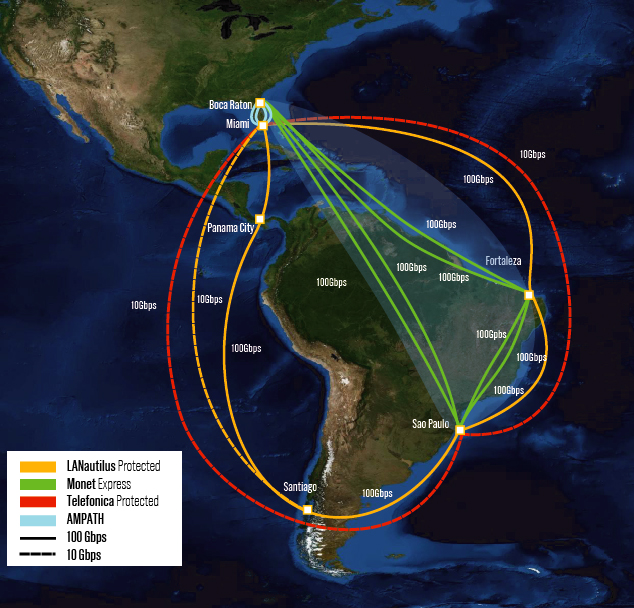
The AmLight Consortium built the Express path using CIENA generated waves over the Subcom constructed optical spectrum, a nascent approach that will provide the AmLight Consortium with the flexibility of upgrading the bandwidth capacity as optical technology advances. The spectrum will be available to the research and education community at least until 2032. This is important for the Large Synoptic Survey Telescope (LSST), whose science mission will rely upon a robust network service that can provide the bandwidth that’s needed to transport 12.7 GB images within 5 seconds from the LSST Base site in La Serena, Chile to the archive site at the National Center for Supercomputing Applications (NCSA), in Urbana-Champaign Illinois for roughly 10 hours every night, 365 nights a year, over the 10 year period of the LSST survey. Starting in 2022, LSST will make about 1000 visits per night (and each visit includes 2 images) each night with its 3.2 billion pixel camera, recording the entire visible southern sky twice each week.
The combined Express and Protect paths form a path-diverse resilient high-performance network infrastructure, built to enable and support big science applications, such as astronomy and high-energy physics, operated by the AmLight Consortium. The AmLight Consortium members include Florida International University (FIU), the Academic Network of Sao Paulo (ANSP), the Rede Nacional de Ensino e Pesquisa (RNP) (Brazilian research and education network), the Red Universitaria Nacional (Reuna) (Chilean research and education network), the regional network of Latin America (RedCLARA), the Association of Universities for Research in Astronomy (AURA), Florida LambdaRail (FLR), Internet2, Telecom Italia Sparkle, and Angola Cables.
See official press release here.
TNC Conference
Tallinn, Estonia - June 16-20, 2019
Dr. Heidi Morgan, Dr. Julio Ibarra, and Jeronimo Bezerra participated at the TNC19, the largest and most prestigious European research and education networking conference. The 35th conference edition was hosted by EENet of HITSA, the Estonian Education and Research Network in Tallinn, Estonia’s capital city. This year’s conference theme, Forging Digital Societies, was inspired by two main concepts: the idea that computer networks, by supporting human interactions, help to create and forge digital societies is combined with the innovative model of Estonia’s e-residency programme. In addition, a variety of community meetings and interactive workshops surrounded the conference’s 21 sessions throughout the week. The AmLight team participated in two major sessions: Under the sea and SDN and Optical: New kids on the block.
 Session: Under the sea Session: Under the sea
Title: Developments in the South Atlantic: Exploring models for sharing submarine cable capacity
Abstract: Bandwidth in the South Atlantic is increasing for the R&E community. In 2018, four events occurred. GEANT and CLARA announced an IRU with EllaLink, connecting Europe and Latin America. FIU signed an IRU with Angola Cables on the South Atlantic Cable System (SACS) and interconnection in Fortaleza to the Monet cable connecting Brazil to Florida. AmLight-ExP announced an IRU with Angola Cable for spectrum from Florida to Fortaleza and Sao Paulo. The SACS submarine cable system started interconnecting Fortaleza and Luanda, Angola. We will report on the AARCLight study and status of network infrastructure via the South Atlantic
Speakers: Dr. Michael Stanton, (Rede Nacional de Ensino e Pesquisa – RNP (Brazilian NREN)), Mr. Len Lotz, (TENET), Dr. Heidi Morgan, (Information Science Institute (ISI) Internet and Networked Systems group at the University of Southern California (USC))
More details about the presentation can be found here.
Presentation files can be found here.
Archived Video Stream starting at 1:08 here. Scroll down to the bottom of the page
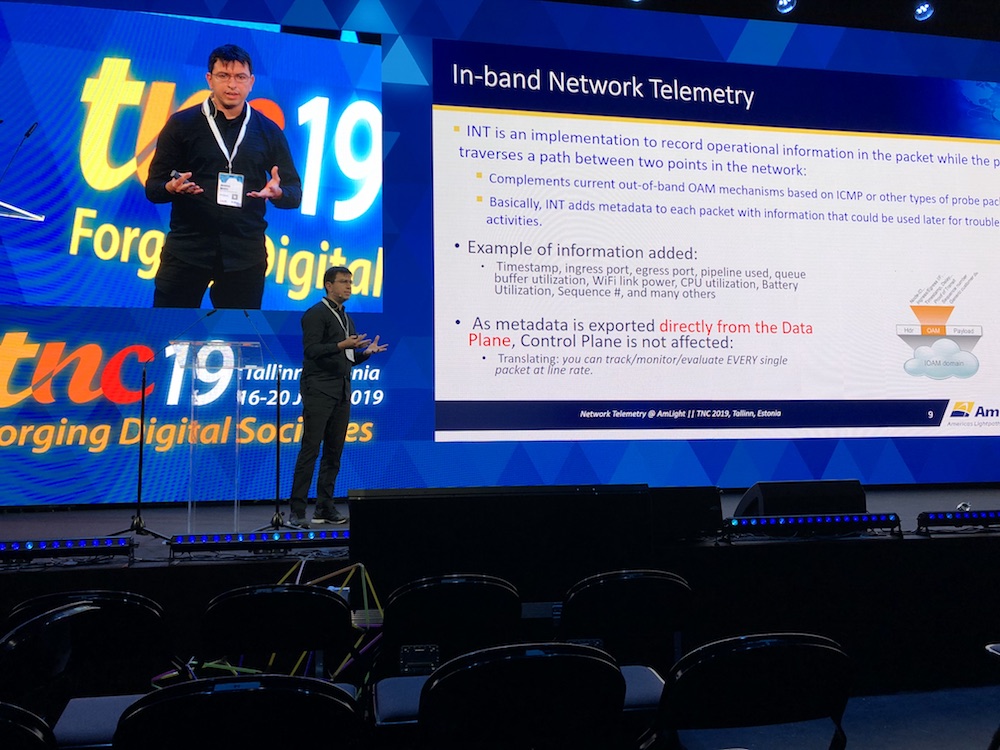 Session: SDN and Optical: New kids on the block Session: SDN and Optical: New kids on the block
Title: AmLight-INT: In-band Network Telemetry to support big data applications
Abstract: AmLight SDN network is being expanded to support in-band network telemetry using P4 and programmable switches. The goal is to support bandwidth-intensive science drivers with very strict SLAs, such as the LSST project. This presentation will share our experience in replacing the current SDN switches for PISA switches as well as trying in-band network telemetry in the field in partnership with NoviFlow switch manufacturer.
Speaker: Jeronimo Bezerra
More details about the presentation can be found here.
Presentation files can be found here.
Archived Video Stream starting at 1:00 here. Scroll down to the bottom of the page.

2018
AmLight Team at Supercomputing Conference SC18
Dallas, TX - November 11-16, 2018
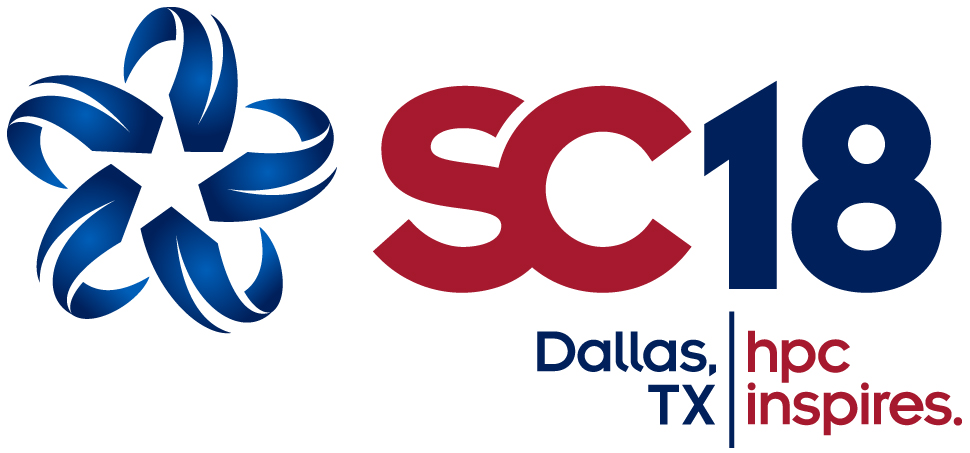 The AmLight Team participated in multiple Network Research Exhibition (NRE) demonstrations at the International Conference for High Performance Computing, Networking, Storage, and Analysis (SC18) held in Dallas, TX. NRE participants are invited to share the results of their demonstrations and experiments that display innovation in emerging network hardware, protocols, and advanced network-intensive scientific applications from the preceding year’s conference as part of the Innovating the Network for Data-Intensive Science (INDIS) workshop. The AmLight Team participated in multiple Network Research Exhibition (NRE) demonstrations at the International Conference for High Performance Computing, Networking, Storage, and Analysis (SC18) held in Dallas, TX. NRE participants are invited to share the results of their demonstrations and experiments that display innovation in emerging network hardware, protocols, and advanced network-intensive scientific applications from the preceding year’s conference as part of the Innovating the Network for Data-Intensive Science (INDIS) workshop.
NRE-16: Global Petascale to Exascale Science Workflows Accelerated by Next Generation SDN Architectures and Applications
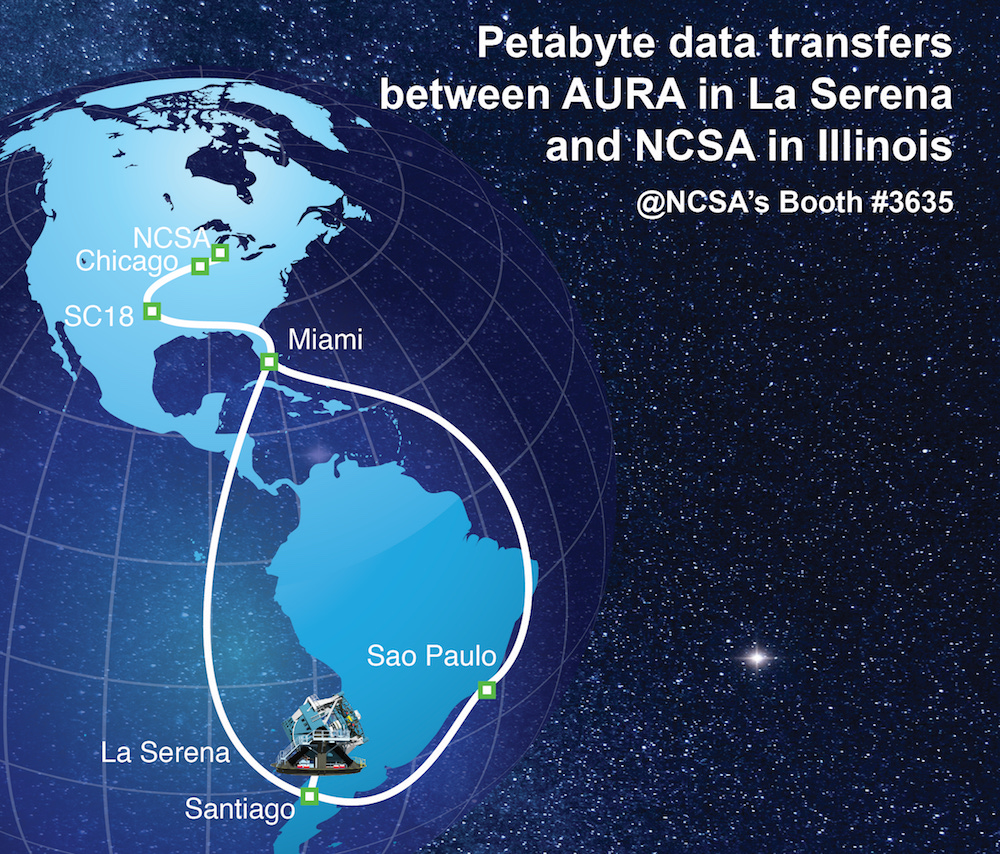 We will demonstrate several major advances in software defined and Terabit/sec networks, intelligent global operations and monitoring systems, workflow optimization methodologies with real-time analytics, and state of the art long distance data transfer methods and tools and server designs, to meet the challenges faced by leading edge data intensive experimental programs in high energy physics, astrophysics, climate science including the Large Hadron Collider (LHC), the Large Synoptic Space Telescope (LSST), the Linac Coherent Light Source (LCLS II), the Earth System Grid Federation and others. Several of the SC18 demonstrations will include a fundamentally new concept of “consistent network operations,” where stable load balanced high throughput workflows crossing optimally chosen network paths, up to preset high water marks to accommodate other traffic, provided by autonomous site-resident services dynamically interacting with network-resident services, in response to demands from the science programs’ principal data distribution and management systems. This will be empowered by end-to-end SDN methods extending all the way to autoconfigured Data Transfer Nodes (DTNs), including intent-based networking APIs combined with transfer applications such as Caltech’s open source TCP based FDT which have been shown to match 100G long distance paths at wire speed in production networks. During the demos, the data flows will be steered across regional, continental and transoceanic wide area networks through the orchestration software and controllers, and automated virtualization software stacks developed in the SENSE, PRP, AmLight, Kytos and other collaborating projects. The DTNs employed will use the latest high throughput SSDs and flow control methods at the edges such as FireQoS and/or Open vSwitch, complemented by NVMe over fabric installations in some locations. We will demonstrate several major advances in software defined and Terabit/sec networks, intelligent global operations and monitoring systems, workflow optimization methodologies with real-time analytics, and state of the art long distance data transfer methods and tools and server designs, to meet the challenges faced by leading edge data intensive experimental programs in high energy physics, astrophysics, climate science including the Large Hadron Collider (LHC), the Large Synoptic Space Telescope (LSST), the Linac Coherent Light Source (LCLS II), the Earth System Grid Federation and others. Several of the SC18 demonstrations will include a fundamentally new concept of “consistent network operations,” where stable load balanced high throughput workflows crossing optimally chosen network paths, up to preset high water marks to accommodate other traffic, provided by autonomous site-resident services dynamically interacting with network-resident services, in response to demands from the science programs’ principal data distribution and management systems. This will be empowered by end-to-end SDN methods extending all the way to autoconfigured Data Transfer Nodes (DTNs), including intent-based networking APIs combined with transfer applications such as Caltech’s open source TCP based FDT which have been shown to match 100G long distance paths at wire speed in production networks. During the demos, the data flows will be steered across regional, continental and transoceanic wide area networks through the orchestration software and controllers, and automated virtualization software stacks developed in the SENSE, PRP, AmLight, Kytos and other collaborating projects. The DTNs employed will use the latest high throughput SSDs and flow control methods at the edges such as FireQoS and/or Open vSwitch, complemented by NVMe over fabric installations in some locations.
Download the final NRE-16 demo submission (PDF)
See the official LSST press release online
NRE-17: Large Synoptic Survey Telescope (LSST) Real Time Low Latency Transfers for Scientific Processing Demonstrations
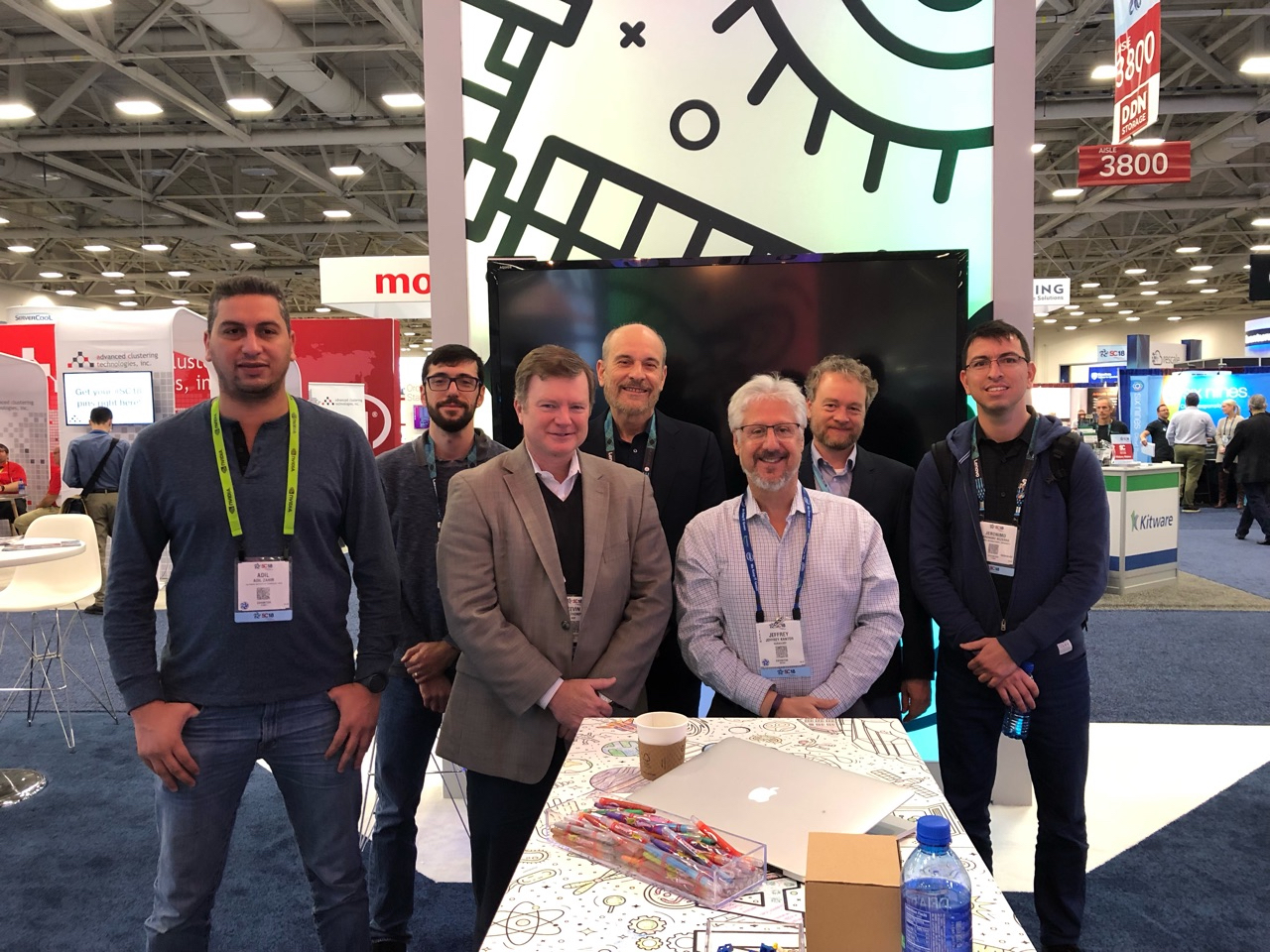 At SC18 in Dallas, Texas we plan to experiment with data transfer rates, using 100Gig FIONA Data Transfer Nodes (a.k.a. DTNs) in Chile and Illinois. The demos aim to achieve three goals: First, we will demonstrate real time low latency transfers for scientific processing of multi-Gigabyte images from the LSST base station site in La Serena, Chile, flowing over the REUNA Chilean National Research & Education Network (NREN), as well as ANSP and RNP Brazilian national circuits and the AmLight-ExP Atlantic and Pacific Ring through AMPATH2 to Starlight and NCSA. Second, we will simulate operational and data quality traffic to SLAC, Tucson and other sites including the Dallas show floor. Third, we will stress test the AmLight ExP network to simulate the LSST annual multi-petabyte Data Release from NCSA to La Serena at rates consistent with those required for LSST operations. At SC18 in Dallas, Texas we plan to experiment with data transfer rates, using 100Gig FIONA Data Transfer Nodes (a.k.a. DTNs) in Chile and Illinois. The demos aim to achieve three goals: First, we will demonstrate real time low latency transfers for scientific processing of multi-Gigabyte images from the LSST base station site in La Serena, Chile, flowing over the REUNA Chilean National Research & Education Network (NREN), as well as ANSP and RNP Brazilian national circuits and the AmLight-ExP Atlantic and Pacific Ring through AMPATH2 to Starlight and NCSA. Second, we will simulate operational and data quality traffic to SLAC, Tucson and other sites including the Dallas show floor. Third, we will stress test the AmLight ExP network to simulate the LSST annual multi-petabyte Data Release from NCSA to La Serena at rates consistent with those required for LSST operations.
Download the final NRE-17 demo submission (PDF).
NRE-18: Americas Lightpaths Express and Protect Enhances Infrastructure for Research and Education
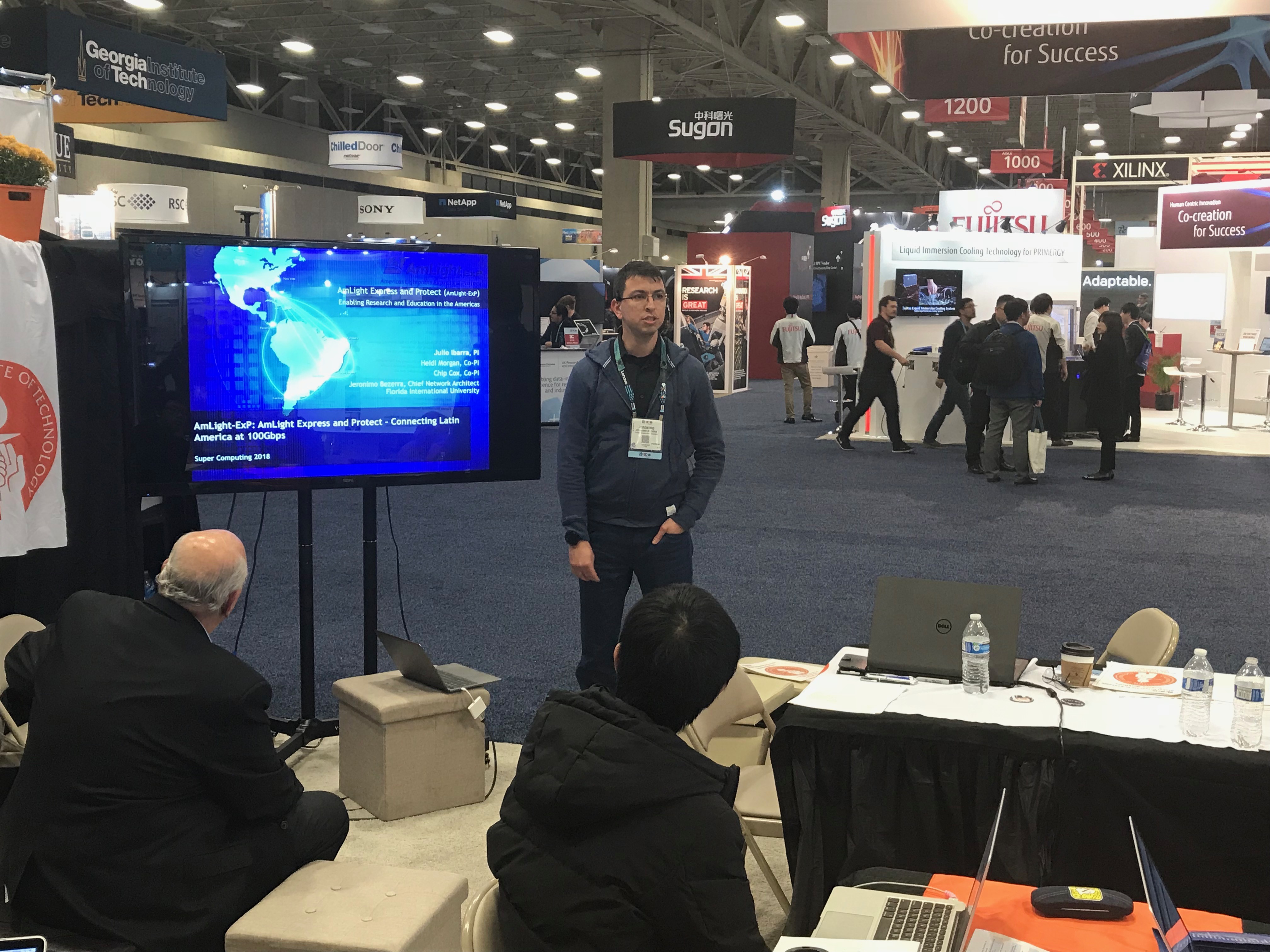 Americas Lightpaths Express and Protect (AmLight ExP) enables research and education amongst the people of the Americas through the operation of production infrastructure for communication and collaboration between the U.S. and Western Hemisphere science and engineering research and education communities. AmLight ExP supports a hybrid network strategy that combines optical spectrum (Express) and leased capacity (Protect) that provides a reliable, leading-edge diverse network infrastructure for research and education. Americas Lightpaths Express and Protect (AmLight ExP) enables research and education amongst the people of the Americas through the operation of production infrastructure for communication and collaboration between the U.S. and Western Hemisphere science and engineering research and education communities. AmLight ExP supports a hybrid network strategy that combines optical spectrum (Express) and leased capacity (Protect) that provides a reliable, leading-edge diverse network infrastructure for research and education.
Download the final NRE-18 demo submission (PDF)
More details about the SC18 can be found here
...
TNC18 – Intelligent networks, cool edges?
Trondheim, Norway - June 10-14, 2018
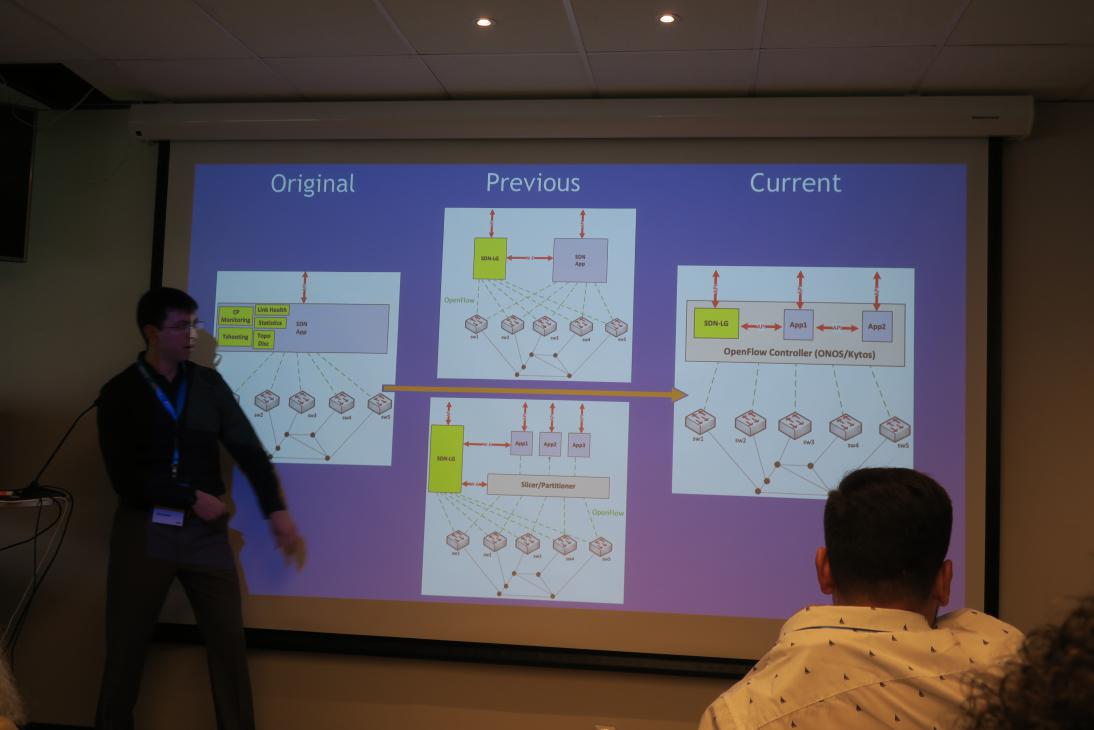 The AmLight Team presented “AmLight’s SDN Looking Glass – An SDN centralized monitoring system” and updates on the “Regional Networks, Communities, and Ecosystems Americas Africa Research and eduCation Lightpaths (AARCLight) Study: Year 1 findings” at the TERENA Network Conference (TNC18), held in Trondheim, Norway.
TNC18 focused on a variety of thought-provoking sub-themes such as the power of the Internet, the responsibility of sustainability and delivery, the power of data analytics, the creation of intelligent complexity, and networking at the speed of science. The AmLight Team presented “AmLight’s SDN Looking Glass – An SDN centralized monitoring system” and updates on the “Regional Networks, Communities, and Ecosystems Americas Africa Research and eduCation Lightpaths (AARCLight) Study: Year 1 findings” at the TERENA Network Conference (TNC18), held in Trondheim, Norway.
TNC18 focused on a variety of thought-provoking sub-themes such as the power of the Internet, the responsibility of sustainability and delivery, the power of data analytics, the creation of intelligent complexity, and networking at the speed of science.
The TNC18, the 34th edition, was hosted by Uninett. Uninett develops and operates the Norwegian national research and education network, interconnecting about 200 Norwegian educational and research institutions and more than 300 000 users, as well as giving them access to international research networks. TNC is the largest and most prestigious European research networking conference, with more than 650 participants attending this annual event. It brings together decision makers, managers, networking and collaboration specialists, plus identity and access management experts from all major European networking and research organizations, universities, worldwide sister institutions, as well as many industry representatives.
Through keynotes, speeches by renowned specialists, varying parallel sessions, demonstrations and presentations, TNC presents participants with a unique overview of the latest developments in research networking, both in the technical field and in the area of application and management.
For AmLight presentation video recording click here.
For AARCLight video recording click here.
For more details about the TNC18 click here.
CIARA Team at Internet2 Global Summit 2018
San Diego, California - May 6-9, 2018
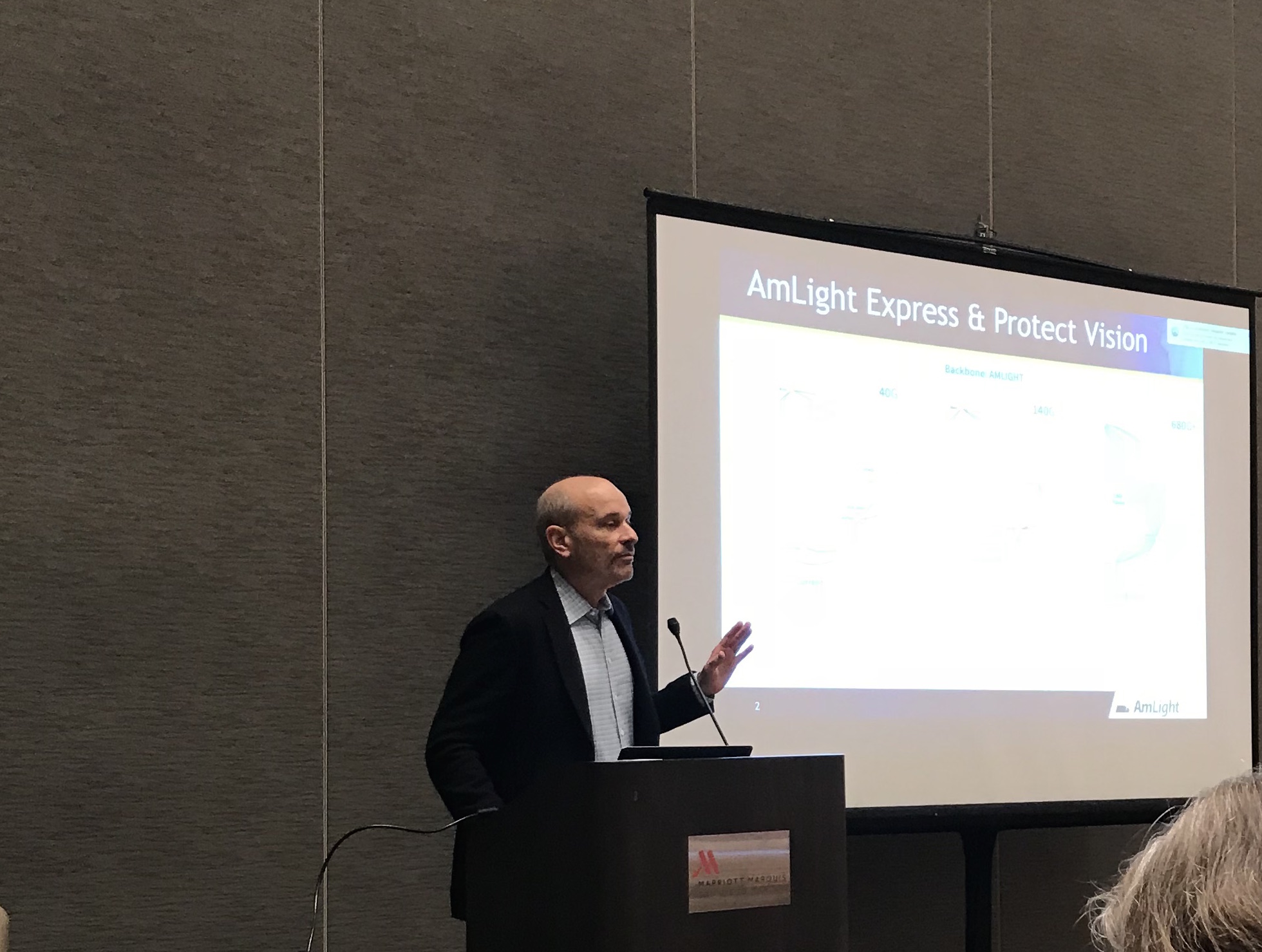 AmLigth Team presented Americas Africa Research and eduCation Lightpaths (AARCLight) Study findings for year one (NSF award #1638990), AtlanticWave-SDX (NSF award#1451024), and current status and future goals for the AmLight Express and Protect (AmLight-ExP)(NSF award #1451018) projects at the IRNC PI Meeting at the Internet2 Global Summit. AmLigth Team presented Americas Africa Research and eduCation Lightpaths (AARCLight) Study findings for year one (NSF award #1638990), AtlanticWave-SDX (NSF award#1451024), and current status and future goals for the AmLight Express and Protect (AmLight-ExP)(NSF award #1451018) projects at the IRNC PI Meeting at the Internet2 Global Summit.
The 2018 Internet2 Global Summit, co-hosted by CENIC, University of California San Diego and San Diego State University, features keynote addresses from top R&E leaders, presentations from noted experts, and sessions focused on advanced and trusted infrastructure, identity, federation and access management, and solutions for researchers with the goal of benefiting the entire research and education ecosystem.
The research and higher education community has a long-standing history of pioneering disruptive and breakthrough technologies in pursuit of advancing scholarship, scientific research, and new discoveries. The community also is known for engaging in mutual-interest collaboration across a diverse set of communities to solve common challenges for the benefit of all.
The program for the I2 Global Summit can be found here.
Amlight-Exp Activates two new 100 Gbps Points-of-Presence Enhancing Infrastructure for Research and Education
Miami, Florida - March 29, 2018
 Florida International University’s Center for Internet Augmented Research and Assessment (CIARA) is pleased to announce two new points-of-presence operating at 100G as part of the five-year AmLight-ExP (IRNC BACKBONE: Americas Lightpaths Express and Protect) NSF Award#ACI-1451018. Florida International University’s Center for Internet Augmented Research and Assessment (CIARA) is pleased to announce two new points-of-presence operating at 100G as part of the five-year AmLight-ExP (IRNC BACKBONE: Americas Lightpaths Express and Protect) NSF Award#ACI-1451018.
On February 23rd and March 8th, the AmLight network engineering team finished installing two 100G links in Fortaleza, Brazil, and two 100G links in Santiago, Chile, respectively. With these new 100G links, researchers and students in these countries will have access to a new network infrastructure with ten times more bandwidth, enhancing international academic collaboration. The links are provided as part of the NSF IRNC AmLight Express and Protect project and the AmLight Consortium: a group of not-for-profit universities, state, national and regional research and education networks including the AmLight ExP project at Florida International University, AURA, LSST, RNP, ANSP, Clara, REUNA, FLR, Telecom Italia Sparkle, and Internet2. The figure represents the new AmLight-ExP map including new sites operating at 100G.
Dr. Julio Ibarra, Assistant Vice President of Technology Augmented Research at FIU, said “Santiago, Chile and Fortaleza, Brazil are strategic locations geographically in the southern hemisphere. By adding Santiago and Fortaleza to the AmLight-ExP 100G ring, the collaborative research and education activities between the U.S. and the nations in South America can rely on a more resilient and higher throughput network infrastructure.”
Dr. Chris Smith, Head of Mission AURA Observatory in Chile said “This network represents a fundamental strategic investment by the NSF in the advancement of science internationally. While it is mission critical for NSF’s newest flagship astronomical facility, the Large Synoptic Survey Telescope (LSST), under construction by AURA in Chile and the USA, it also enhances the operational capabilities of all of the astronomical facilities in Chile, including the existing NSF facilities of NOAO, Gemini, and ALMA as well as the many smaller university-led projects that are located in northern Chile to take advantage of the excellent observational conditions there.”
Jeffrey Kantor, of the LSST Project Management Office, said, “This development will enable LSST to realize a reliable, high-speed network connecting LSST sites in Chile and the United States. This network will permit LSST data to travel in seconds to our LSST Data Facility at the University of Illinois National Center for Supercomputing Applications (NCSA) where it is processed into real-time alerts of transient events and annual data releases ultimately containing billions of galaxies and stars.”
“The new 100G AmLight-ExP links form a ring Miami-Fortaleza-São Paulo-Santiago-Miami, by making this capacity also available in Santiago and Fortaleza. This ring will soon be connected in Fortaleza, to the future 100G cables Ellalink (from Portugal) and SACS (from Angola), forming what is to be called the South Atlantic Crossroads (SAX)”, said Dr. Michael Stanton, Director of Research and Development at Brazil’s National Research and Education Network, RNP.
Eduardo Grizendi, Director of Engineering & Operation at Brazil’s National Research and Education Network, RNP, said “With these activations, we are completing a network infrastructure of excellence for the next years, of 100G high capacity, robust and redundant, to support international academic collaboration, especially between the Americas.”
“Reliable high bandwidth connectivity has been always a challenge in a continental country like Brazil, plenty of rainforests and economic difficulties. This great work of RNP with Brazillian electricity companies, will allow us to extend a 100G backbone from the extreme northern rainforest to the southern planes. This first inauguration shows it is indeed possible at a payable price and that RNP can and is doing it. No need to say how important this is to the national and international scientific collaboration in the American continent”, said Dr. Luis Lopez, Principal Investigator (PI) of ANSP.
For copy of the press release click here.

2017
Amlight-Exp Network Infrastructure Demonstrate Large Data-Sets Transfer at SC17
Denver, Colorado, November 13-17, 2017
The SuperComputing17 (SC17) event was hosted in Denver, Colorado from November 14, 2017, to November 16, 2017. Over this period, network engineers from AmLight, Academic Network of São Paulo (ANSP), State University of São Paulo (UNESP) and the California Institute of Technology (Caltech) leveraged the AmLight-ExP network infrastructure to transport large data-sets on 100Gbps links between São Paulo, Miami, and Denver. Currently, AmLight-ExP has a total aggregated capacity of 240Gbps between South America and North America. In addition, two 100G circuits were installed between Miami and Denver provisioned by CenturyLink.
To generate network traffic for the demonstrations at SC17, several DTNs (data transfer nodes) running either nuttcp or FDT were leveraged in São Paulo (UNESP/ANSP), Miami (AMPATH) and Denver (Caltech and UNESP booths). Also, the Kytos SDN Platform was utilized to provision Layer 2 paths between these DTNs for the data transfers using dedicated OpenFlow switches and AmLight SDN’s slicing capabilities. On November 16th, in the afternoon, several demonstrations were encouraged to generate as much network traffic as possible to fill-up SC17 links. At AmLight, a steady 370Gbps total aggregated traffic was transported, which is illustrated in Figure 1.

Figure 1 - Total aggregated switches network traffic on AmLight network at SC17 November 16, 2017
“The conference was a great opportunity to showcase Kytos, an open-source SDN platform that has been developed by SPRACE with the support of Huawei. Our next step will be to deploy Kytos on the ESnet testbed in association with the AmLight engineers”, said Sergio Novaes, PI of SPRACE and scientific director of UNESP Center for Scientific Computing.
“We consider these achievements very important, and we are satisfied in participating in these successful demonstrations at SC17. Exercising and stressing intensive data transfers on multiple 100 Gbps WAN links between the United States and South America, especially, between Sao Paulo, Miami and Denver, give us confidence to support a service of intensive data transfers for our academic community, regionally or on globally distributed science programs”, said Eduardo Grizendi, Director of Engineering and Operation of RNP, the Brazilian Academic Network.
For full pressrelease click here.
Global Experimentation for Future Internet (GEFI 2017) Workshop
Rio de Janeiro, Brazil, October 26-27, 2017
 Dr. Heidi Morgan and Dr. Julio Ibarra participated in GEFI Workshop which took place in Rio de Janeiro, Brazil on October 26-27, 2017, and was hosted by the Brazilian national research and education network - Rede Nacional de Ensino e Pesquisa (RNP). The GEFI series of workshops grows out of an agreement between the Global Environment for Network Innovations (GENI) and Future Internet Research and Experimentation (FIRE) projects in 2015 to advance the joint interests in hosting at-scale experimentation in future internet architectures. Dr. Heidi Morgan and Dr. Julio Ibarra participated in GEFI Workshop which took place in Rio de Janeiro, Brazil on October 26-27, 2017, and was hosted by the Brazilian national research and education network - Rede Nacional de Ensino e Pesquisa (RNP). The GEFI series of workshops grows out of an agreement between the Global Environment for Network Innovations (GENI) and Future Internet Research and Experimentation (FIRE) projects in 2015 to advance the joint interests in hosting at-scale experimentation in future internet architectures.
CIARA FIU partnered with the GEFI Workshop organizers under the NSF projects: SwitchOn Workshops (NSF Award # 1443285) and GEFI Workshop (NSF Award # 1724805) to provide participants support. The goals were to encourage collaborative research across international boundaries, in a set of topics that are interesting to researchers in each of the participating countries:
Investigations of the research infrastructures suitable for hosting at-scale experimentation in future internet architectures, services, and applications, and use of such infrastructures for experimental research. A collaboration that will encompass joint specification of system interfaces, development of interoperable systems, adoption of each other’s tools, experimental linkages of the testbeds, and experimentation that spans the infrastructures. Envision that students and young professors from participating nations will visit each other and collaborate deeply in these activities, in hopes of sparking friendships and life-long research collaborations between the communities.
The GEFI program can be found here.
12th Gateway Computing Environments Conference
Ann Harbor, Michigan, October 23-25, 2017
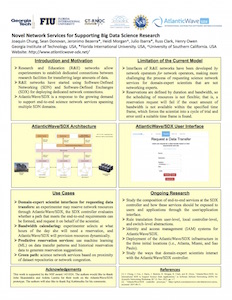 AtlanticWave-SDX Team (FIU: Jeronimo Bezerra, Dr. Heidi Morgan, Dr. Julio Ibarra, GeorgiaTech: Joaquin Chung, Sean Donovan, Dr. Russ Clark, Dr. Henry Owen) presented the “Novel Network Services for Supporting Big Data Science Research” at the 12th Gateway Computing Environments Conference on October 23-25, 2017, hosted by University of Michigan, Ann Harbor. AtlanticWave-SDX Team (FIU: Jeronimo Bezerra, Dr. Heidi Morgan, Dr. Julio Ibarra, GeorgiaTech: Joaquin Chung, Sean Donovan, Dr. Russ Clark, Dr. Henry Owen) presented the “Novel Network Services for Supporting Big Data Science Research” at the 12th Gateway Computing Environments Conference on October 23-25, 2017, hosted by University of Michigan, Ann Harbor.
Science gateways allow science & engineering communities to access shared data, software, computing services, instruments, educational materials, and other resources specific to their disciplines. They are typically a web portal or a suite of desktop applications.
Gateway developers and users—regardless of their domain area—have a lot in common but have had few venues for exchanging experiences. The second Gateways annual conference (formerly the Gateway Computing Environments workshop series) will be an opportunity for gateway creators and enthusiasts to learn, share, connect, and shape the future of gateways as part of a vibrant community with common interests.
This gathering for gateway creators and enthusiasts features hands-on tutorials, demos, keynotes, presentations, panels, posters, and plenty of opportunities to connect with colleagues.
To interconnect research facilities across wide geographic areas, network operators deploy science networks, also referred to as Research and Education (R&E) networks. These networks allow experimenters to establish dedicated network connections between research facilities for transferring large amounts of data. Recently, R&E networks have started using Software-Defined Networking (SDN) and Software-Defined Exchanges (SDX) for deploying these connections. AtlanticWave/SDX is a response to the growing demand to support end-to-end network services spanning multiple SDN domains. However, requesting these services is a challenging task for domain-expert scientists, because the interfaces of the R&E networks have been developed by network operators for network operators. In the presented paper, AtlanticWave-SDX Team proposes interfaces that allow domain-expert scientists to reserve resources of the scientific network using abstractions that focus on their data transfer needs for scientific workflow management. Recent trends in the networking field pursue better interfaces for requesting network services (e.g., intent-based networking). Although intents are sufficient for the needs of network operations, they are not abstract enough in most cases to be used by domain-expert scientists. This is an issue we are addressing in the AtlanticWave/SDX design: network operators and domain-expert scientists will have their own interfaces focusing on their specific needs.
SDX User Interface Demo: Network Operator | Scientist
AtlanticWave-SDX’s Presentation | Poster | Paper
For trying out the AtlanticWave/SDX controller visit the Github link
For the 12th Gateway Computing Environments Conference program click here.
Gateways 2017 is organized by the Science Gateways Community Institute (SGCI).
AtlanticWave-Software Defined Exchange (SDX) project is supported by NSF Award #1451024.
Astronomical Data Analysis Software and Systems (ADASS)
Santiago, Chile, October 22-26, 2017
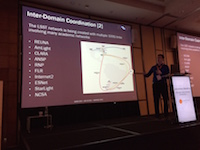 Jeronimo Bezerra presented the academic paper “International Networking in support of Extremely Large Astronomical Data-centric Operations” at the Astronomical Data Analysis Software and Systems (ADASS) conference which was hosted by the European Southern Observatory (ESO), the Atacama Millimeter/ submillimiter Array (ALMA) and the Federico Santa María Technical University (UTFSM) in collaboration with several Chilean governmental agencies and institutions in Santiago, Chile on October 21-27, 2017. Jeronimo Bezerra presented the academic paper “International Networking in support of Extremely Large Astronomical Data-centric Operations” at the Astronomical Data Analysis Software and Systems (ADASS) conference which was hosted by the European Southern Observatory (ESO), the Atacama Millimeter/ submillimiter Array (ALMA) and the Federico Santa María Technical University (UTFSM) in collaboration with several Chilean governmental agencies and institutions in Santiago, Chile on October 21-27, 2017.
The conference provides a forum for scientists and programmers concerned with algorithms, software and software systems employed in the acquisition, reduction, analysis, and dissemination of astronomical data. An important element of the program is to foster communication between developers and users with a range of expertise in the production and use of software and systems. The program consists of invited talks, contributed oral and display papers, tutorials, user group meetings and special interest group meetings.
Download the presentation here.
Internet2 Technology Exchange 2017
San Francisco, California, October 15-18, 2017
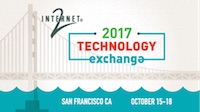 Dr. Julio Ibarra and Jeronimo Bezerra presented the latest updates on the AmLight Express and Protect (ExP) (NSF Award #1451018) and the AtlanticWave-Software Defined Exchange (SDX) (NSF Award #1451024) projects. Dr. Julio Ibarra and Jeronimo Bezerra presented the latest updates on the AmLight Express and Protect (ExP) (NSF Award #1451018) and the AtlanticWave-Software Defined Exchange (SDX) (NSF Award #1451024) projects.
This year’s I2 TechEx was held in downtown San Francisco from October 15–18, and featured over 90 presentations, 50 working meetings, 10 in-depth tutorials, and 5 co-located workshops on a broad spectrum of topics related to advanced networking, information security, trust and identity, web-scale computing, and applications for research support.
Internet2’s annual Technology Exchange conference is a premier technical event in the global R&E community, convening the community’s technology visionaries—including chief technologists, scientists, engineers, architects, operators and students from around the U.S. and the globe. Technology Exchange content focuses primarily on implementation challenges, best common practices, and future directions.
For the Internet2 Technology Exchange program click here.
For the AmLight ExP’s presentation click here.
For the AtlanticWave-SDX’s presentation click here.
The First National Research Platform (NRP) )Workshop
Bozeman, Montana, August 7-8, 2017
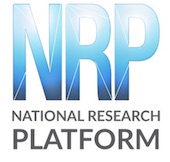 Dr.Heidi Morgan and Jeronimo Bezerra presented Large Synoptic Survey Telescope (LSST) Scaling Issues and Network Needs (part of session Towards A Global Research Platform) at the First National Research Platform (NRP). The NRP workshop was held at Montana State University in Bozeman, Montana on August 7 & 8, 2017. The purpose of this workshop was to bring together representatives from interested institutions to discuss implementation strategies for deployment of interoperable Science DMZs at a national scale. The viewpoints of administrators, campus IT managers, ESnet, CENIC, Internet2, XSEDE, and the National Science Foundation was be presented. Sessions of the NRP workshop was also be devoted to science-driver application researchers, describing their needs for high-speed data transfer, including their successes and frustrations. Discussions were focused on requirements from the domain scientists and the networking architecture, policies, tools and security necessary to deploy a 200-institution National Research Platform. All participants were encouraged to ask questions and share their thoughts on the topics under discussion. Dr.Heidi Morgan and Jeronimo Bezerra presented Large Synoptic Survey Telescope (LSST) Scaling Issues and Network Needs (part of session Towards A Global Research Platform) at the First National Research Platform (NRP). The NRP workshop was held at Montana State University in Bozeman, Montana on August 7 & 8, 2017. The purpose of this workshop was to bring together representatives from interested institutions to discuss implementation strategies for deployment of interoperable Science DMZs at a national scale. The viewpoints of administrators, campus IT managers, ESnet, CENIC, Internet2, XSEDE, and the National Science Foundation was be presented. Sessions of the NRP workshop was also be devoted to science-driver application researchers, describing their needs for high-speed data transfer, including their successes and frustrations. Discussions were focused on requirements from the domain scientists and the networking architecture, policies, tools and security necessary to deploy a 200-institution National Research Platform. All participants were encouraged to ask questions and share their thoughts on the topics under discussion.
For the last three years, the National Science Foundation (NSF) has made a series of competitive grants to over 100 U.S. universities to aggressively upgrade their campus network capacity for greatly enhanced science data access. NSF is now building on that distributed investment by funding a $5 million, five-year award to UC San Diego and UC Berkeley to establish a Pacific Research Platform (PRP), a science-driven high-capacity data-centric “freeway system” on a large regional scale. Within a few years, the PRP will give participating universities and other research institutions the ability to move data 1,000 times faster compared to speeds on today’s inter-campus shared Internet.
Download presentation here.
For video presentation click here.
AmLight SDN and automation at TERENA Networking Conference (TNC17)
Linz, Austria, May 29- June 2, 2017
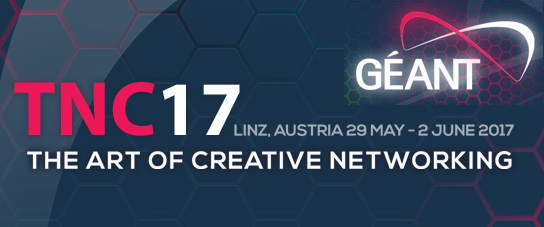 AmLight Team (Jeronimo Bezerra, Jorge Marcos, Dr. Julio Ibarra, Dr.Heidi Morgan and Dr.Luis Lopez) presented Handling Network Events in a Production SDN Environment (part of session SDN and automation) at the Terena Networking Conference (TNC) in Linz, Austria. Along with that, they participated in a Global Lambda Integrated Facility (GLIF) and Global Network Architecture (GNA) meetings. Through keynotes speeches by renowned specialists, varying parallel sessions, demonstrations, and presentations, the Conference presents participants with a unique overview of the latest developments in research networking, both in the technical field and in the area of application and management. AmLight Team (Jeronimo Bezerra, Jorge Marcos, Dr. Julio Ibarra, Dr.Heidi Morgan and Dr.Luis Lopez) presented Handling Network Events in a Production SDN Environment (part of session SDN and automation) at the Terena Networking Conference (TNC) in Linz, Austria. Along with that, they participated in a Global Lambda Integrated Facility (GLIF) and Global Network Architecture (GNA) meetings. Through keynotes speeches by renowned specialists, varying parallel sessions, demonstrations, and presentations, the Conference presents participants with a unique overview of the latest developments in research networking, both in the technical field and in the area of application and management.
AmLight ExP project is supported by NSF Award #1451018
Download the AmLight ExP presentation here.
Download the abstract here.
Internet2 Global Summit 2017
Washington, DC, April 23-26, 2017
 Dr. Heidi Morgan, Dr. Julio Ibarra, and Jeronimo Bezerra, AmLight ExP Chief Network Engineer, presented "Inter-domain SDN Data Plane Validation: Next Steps at AmLight" in collaboration with Marcos Schwarz from RNP (Rede Nacional De Ensino E Pesquisa) Brazil. The theme for the 2017 Global Summit focused on Bringing Networks Together: Connecting People and Technology with Research and Education. The research and education (R&E) community is in the business of building more than one kind of network. Putting foundational and innovative technologies to work across the globe, the Internet2 community has created a unique network infrastructure dedicated to supporting the research and scholarship missions of our members. Dr. Heidi Morgan, Dr. Julio Ibarra, and Jeronimo Bezerra, AmLight ExP Chief Network Engineer, presented "Inter-domain SDN Data Plane Validation: Next Steps at AmLight" in collaboration with Marcos Schwarz from RNP (Rede Nacional De Ensino E Pesquisa) Brazil. The theme for the 2017 Global Summit focused on Bringing Networks Together: Connecting People and Technology with Research and Education. The research and education (R&E) community is in the business of building more than one kind of network. Putting foundational and innovative technologies to work across the globe, the Internet2 community has created a unique network infrastructure dedicated to supporting the research and scholarship missions of our members.
The Internet2 community has also built a global service framework of trust, identity and access management services where people can more easily and securely pursue the research and education solutions that will deepen their lives and widen their influence on the lives of those around them.
The capabilities these technical infrastructures make possible are increasingly dependent on the creativity and understanding of the people using them. The 2017 Internet2 Global Summit will take a good look at how we can use knowledge and practice oriented networks of people to harness and enable the power of technologies that are innovative and disruptive in order to build and sustain a collaborative community that continues to thrive and lead.
AmLight ExP project is supported by NSF Award #1451018
For AmLight ExP presentation click here.
For Internet 2 Global Summit 2017 program click here.
AMPATH supports the deployment of anycast for improvement of B-Root DNS Services
Miami, FL, April 20, 2017
Florida International University’s Center for Internet Augmented Research and Assessment (CIARA) is pleased to support the improvement of the B-Root DNS service. B-Root will be activating anycast on May 1, 2017, providing service from a new site in Miami in addition to the current site in Los Angeles. Florida International University (FIU) and AMPATH are hosting the new hardware in Miami, and University of Southern California (USC) will provide the hardware support for this second site.
The B Root Domain Name Server (DNS) is operated by the Internet and Networked Systems Division at the Information Sciences Institute (ISI) along with USC’s Information Technology Services. B Root (b.root-servers.net and its predecessors) has been operational since 1987. USC/ISI has operated Internet root nameservers since the inception of the root DNS system, with the b.root-server service in the Los Angeles area.
As part of this deployment, renumbering B-Root’s IPv6 address to 2001:500:200::b, will be effective on June 1, 2017. Planned renumbering for IPv4 is addressed later in 2017. Renumbering will help support anycast with more resilient routing. Service on old IPv6 and IPv4 addresses will be provided for at least one year after renumbering.
Anycast is an IP unicast service that it is spread through multiple locations with the same IP number (single anycast address is assigned to multiple hosts), where the routers in between are selecting the best and nearest destination.
Benefits to anycast implementations are: one IP address in every location, service reliability, high availability, locality & latency improvements, load balancing, and a distributed response to DoS.
For full pressrelease click here
GENI Regional workshop (GRW) & GENI Engineering Conference (GEC25)
Miami, FL, March 13-15, 2017
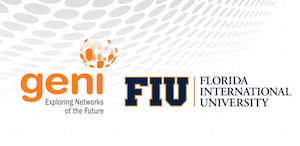 Florida International University is hosting GENI Regional workshop (GRW) on March 13 and a GENI Engineering Conference (GEC25) on March 14-15, 2017 at the Kovens Conference Center, Biscayne Bay Campus. Florida International University is hosting GENI Regional workshop (GRW) on March 13 and a GENI Engineering Conference (GEC25) on March 14-15, 2017 at the Kovens Conference Center, Biscayne Bay Campus.
Global Environment for Network Innovations (GENI) provides a virtual laboratory for networking and distributed systems research and education. It is well suited for exploring networks at scale, thereby promoting innovations in network science, security, services, and applications. GRW offers an opportunity to learn about GENI and how you can use it for your education and research needs.
GENI GEC25 will provide a 2-day program that provides content of general interest to experimenters, developers, and practitioners. The program will be of interest to not only U.S. participants, but also potentially participants from Latin America, Canada, Europe, and Asia.
GENI Regional Workshop (GRW): Monday, March 13, 2017
More information is available here.
Registration for GRW is FREE. Space is limited so please register as soon as possible by cliking here.
GENI Engineering Conference (GEC25): Tuesday, March 14 to Wednesday (1:00 pm), March 15, 2017. More information is available here.
Registration for the GEC25 is $250 until February 19, 2017, after the 19th, the fee will be $300. Please register as soon as possible by cliking here.
South American Astronomy Coordination Committee (SAACC) Spring Meeting
Miami, FL, January 10-11, 2017
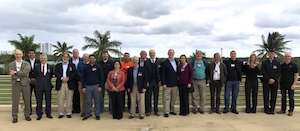 Hosted by FIU CIARA, the AmLight SAACC Spring meeting took place on January 10-11, 2017 at the Kovens Conference Center at the FIU Biscayne Bay Campus. The two-day meeting was organized in 2 parts: SAACC Meeting on Tuesday, January 10th, and Engineering Meeting on Wednesday, January 11th. The meeting gathered participants from several universities, organizations and research institutions from USA, Latin America, and Europe. Presentations from AURA, NRAO, ALMA, LSST, AmLight, REUNA, RNP, RedCLARA, and ANSP are available online here. Hosted by FIU CIARA, the AmLight SAACC Spring meeting took place on January 10-11, 2017 at the Kovens Conference Center at the FIU Biscayne Bay Campus. The two-day meeting was organized in 2 parts: SAACC Meeting on Tuesday, January 10th, and Engineering Meeting on Wednesday, January 11th. The meeting gathered participants from several universities, organizations and research institutions from USA, Latin America, and Europe. Presentations from AURA, NRAO, ALMA, LSST, AmLight, REUNA, RNP, RedCLARA, and ANSP are available online here.
The SAACC is comprised of representatives from the various astronomy projects who are conducting projects or operating observatories in South America. The initial chair of the SAACC, Dr. R. Chris Smith, director of the Cerro Tololo Inter-American Observatory and head of mission for AURA Observatory in Chile, provides oversight of the Chilean activities of CTIO, Gemini, SOAR, and LSST.
The SAACC is now in its 7th year and serves not only to provide input and advice to the AmLight PI, Dr. Julio Ibarra, Assistant Vice-President of the CIARA FIU and the Steering Committee on program and network needs, but also as a venue for coordinating the needs of these astronomical projects and institutions to improve their resource planning and implementation of operational connections between these distant facilities and users in the continental US and Latin-American Countries.
For more details click here.

2016
Super Computing Conference 2016
Salt Lake City, UT, November 13-18, 2016
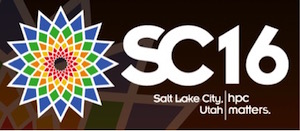 During the Super Computing 2016 (SC16), network engineers from AmLight, Academic Network of São Paulo (ANSP), State University of São Paulo (UNESP), Florida LambdaRail (FLR) and California Institute of Technology (Caltech) leveraged the AmLight-ExP network to demonstrate the new 200G capacity between South America and the U.S. A total of 176Gbps of aggregated traffic was measured between, São Paulo, Miami and Salt Lake City, Utah, where the Super Computing 2016 was hosted. The figure below shows a sustained flow rate of ~85Gbps, with peaks of 97Gbps, generated using the FDT software. For this demonstration, two high-end servers were installed in São Paulo (one at São Paulo Research and Analysis Center (SPRACE)/UNESP and one at ANSP) and one server was installed at AMPATH/NAP of the Americas, Miami, FL. At the SC16, Caltech provided a few 100G servers. During the Super Computing 2016 (SC16), network engineers from AmLight, Academic Network of São Paulo (ANSP), State University of São Paulo (UNESP), Florida LambdaRail (FLR) and California Institute of Technology (Caltech) leveraged the AmLight-ExP network to demonstrate the new 200G capacity between South America and the U.S. A total of 176Gbps of aggregated traffic was measured between, São Paulo, Miami and Salt Lake City, Utah, where the Super Computing 2016 was hosted. The figure below shows a sustained flow rate of ~85Gbps, with peaks of 97Gbps, generated using the FDT software. For this demonstration, two high-end servers were installed in São Paulo (one at São Paulo Research and Analysis Center (SPRACE)/UNESP and one at ANSP) and one server was installed at AMPATH/NAP of the Americas, Miami, FL. At the SC16, Caltech provided a few 100G servers.
“We are now the only academic institution in Latin America capable of transferring data at 100 Gbps from/to the United States, through a DWDM infrastructure that includes two 100G channels from the UNESP Center for Scientific Computing to the headquarter of the Academic Network at São Paulo (ANSP), thus enabling us to improve the data transfer rate between our CMS Tier-2 and the remaining sites of the Worldwide LHC Computing Grid by one order of magnitude”, said Sergio Novaes, PI of SPRACE and scientific director of UNESP Center for Scientific Computing.
In parallel with the high-performance network demonstration, Dr. Julio Ibarra, PI and Co-Founder of the Florida International University (FIU) Center for Internet Augmented Research and Assessment (CIARA), where these projects are based in the U.S., presented to the SC16 attendees the AmLight-ExP project titled “Creating new opportunities for US and Latin America research and education collaboration through the development of an intercontinental 100G optical network infrastructure”. The AmLight Express and Protect (ExP) project implements a hybrid network strategy that combines optical spectrum (Express) and leased capacity (Protect) that builds a reliable, leading-edge diverse network infrastructure for research and education (NSF Award#ACI-1451018).

Figure 1 Demonstrated traffic in the Atlantic 100Gbps link
“Much recognition needs to go to the network engineers and the researchers who worked tirelessly before and during SC16 to configure and tune the network devices and servers to achieve these unprecedented results. I would like to congratulate our collaborators at UNESP, ANSP, Florida LambdaRail, and Caltech on this achievement, and the National Science Foundation for their support”, said Dr. Julio Ibarra, PI of the AmLight-ExP project.
“We have only been able to achieve this unprecedented result due to the efforts of a remarkable team of system and network engineers and the support of partners such as ANSP, AMPATH, Caltech, and companies such as Huawei, Intel and Padtec among others. The partnerships aimed at generating innovative R&D projects that UNESP CSC has established with high-tech companies were essential to achieve this result. But we intend to go further: new experiments involving 100Gbps international channels and software-controlled network resources are already being planned”, said Dr. Rogerio Iope, member of SPRACE engineering team and executive manager of UNSEP Center for Scientific Computing.
For full press release please click here.
Internet 2 Technology Exchange co-hosted with FIU
Miami, FL, September 25-29, 2016
 The 2016 Technology Exchange presented by Internet2 is co-hosted by Florida International University, the University of Florida, and Florida LambdaRail from September 25-29 in Miami. The Internet2 TechEx organized U.S. and global technology leaders and visionaries including pioneers, technologists, architects, scientists, operators and students in the fields of networking, security, trust and identity, virtualization, cloud services, high-performance computing, and storage to share expertise in a forum designed to facilitate the cross-pollination of technical ideas and information. The 2016 Technology Exchange presented by Internet2 is co-hosted by Florida International University, the University of Florida, and Florida LambdaRail from September 25-29 in Miami. The Internet2 TechEx organized U.S. and global technology leaders and visionaries including pioneers, technologists, architects, scientists, operators and students in the fields of networking, security, trust and identity, virtualization, cloud services, high-performance computing, and storage to share expertise in a forum designed to facilitate the cross-pollination of technical ideas and information.
AmLight and partners sessions and presentations:
09/25 1:00 PM - Performing Arts and Advanced Networking New World Symphony
06/26 9:30 AM - A Secure SDN Science DMZ
09/26 8:40 AM - Troubleshooting AmLight: Handling Network Events in a Production SDN Environment
09/26 3:10 PM - Programmable Privacy-Preserving Network Measurement for Network Usage Analysis and Troubleshooting
09/28 10:20 AM - Creating New Opportunities for U.S.-Latin America R&E Collaborations
09/28 11:10 AM - Interconnecting Spectrum Between Multiple Domains to Support Science Applications: A Use Case with FLR
09/29 01:30 PM - Challenges When Designing a Distributed SDX
09/29 04:10 PM - Assessing the Quality of Flow Measurements from OpenFlow Devices Lightning talk
AmLigth Team at TICAL 2016
Buenos Aires, Argentina, September 13-15, 2016
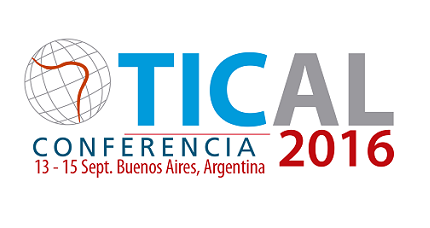 Dr. Heidi Morgan, Dr. Julio Ibarra, Dr. Chip Cox and Jeronimo Bezerra presented “AmLight Express and Protect: Sirviendo comunidades de investigación y educación entre EEUU y America Latina” in Spanish at TICAL 2016. The theme was about the AmLight-ExP project and the 100G network infrastructure. Dr. Heidi Morgan, Dr. Julio Ibarra, Dr. Chip Cox and Jeronimo Bezerra presented “AmLight Express and Protect: Sirviendo comunidades de investigación y educación entre EEUU y America Latina” in Spanish at TICAL 2016. The theme was about the AmLight-ExP project and the 100G network infrastructure.
In addition to that, Humberto Galiza, AmLight Senior Network Engineer, presented “Deploying SDN experiments in Latin America: the ONOS and SDN-IP application use case at AmLight” also in Spanish.
TICAL is a Network of ICT Directors from Latin American universities created in 2011 by RedCLARA. The sixth edition of the TICAL Conferences took place in Buenos Aires, Argentina, with approximately 300 participants from different countries in Latin America.
Discussions about how big data and predictive analytics can change the global Information and Communication Technologies (ICT) scenario and the importance of collaborative security set the tone on the first day of the activities of the event. Network & mobile infrastructure, academic services, services to support institutional management, and the governance & legal aspects for the delivery of technology services of ICT are the dominant themes of the TICAL Community. The conference also opened up the possibility of making connections between institutions, thus promoting the creation of collaboration links in order to make the most of the synergies in the group.
For Dr. Julio Ibarra presentation click here.
For Humberto Galiza presentation click here.
For more information about TICAL2016 and the program click here.
Dr. Luis Lopez awarded the Brazilian Army the Medal of the Peacemaker (Medalha do Pacificador)
Brasilia, Brazil, August 25, 2016
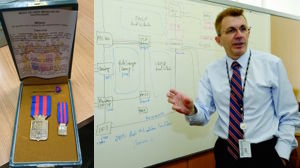 Professor Dr. Luis Fernandez Lopez awarded the Peacemaker Medal (Medalha do Pacificador), an honor given to civil and military personalities due to relevant services provided to the Brazilian Army, raising the prestige of the institution or developing friendly relations between the Brazilian Army and the other nations.
The award was given on August 25th celebrating the Brazilian Soldier Day. This year, only two militaries and nine civilians awarded the Peacemaker Medal. The Army gives the medal to the people that the institution believes by their attitude, dedication and professional ability, provided important achievements to the country. Congratulations Prof. Dr. Luis Lopez! Professor Dr. Luis Fernandez Lopez awarded the Peacemaker Medal (Medalha do Pacificador), an honor given to civil and military personalities due to relevant services provided to the Brazilian Army, raising the prestige of the institution or developing friendly relations between the Brazilian Army and the other nations.
The award was given on August 25th celebrating the Brazilian Soldier Day. This year, only two militaries and nine civilians awarded the Peacemaker Medal. The Army gives the medal to the people that the institution believes by their attitude, dedication and professional ability, provided important achievements to the country. Congratulations Prof. Dr. Luis Lopez!
TERENA Networking Conference (TNC16)
Prague, Czech Republic, June 12-16, 2016
 Dr. Heidi Morgan, Dr. Julio Ibarra, and Jeronimo Bezerra participated in TNC 16 with presentation “Coexisting Production and Experimental Testbeds: The AmLight experience after one year” at the session “SDN data plane”. The article presented by Jeronimo Bezerra describes and discusses how production and experimental networks may coexist using the same OpenFlow-controlled infrastructure, represented here by the Amlight community’s network connections between North and South America. In order to avoid undue interference with production traffic, the team has developed a sanitizer module, which filters and validates the controller messages used by the experimental networks. (NSF Awards # ACI 1451018 and 0963053) Dr. Heidi Morgan, Dr. Julio Ibarra, and Jeronimo Bezerra participated in TNC 16 with presentation “Coexisting Production and Experimental Testbeds: The AmLight experience after one year” at the session “SDN data plane”. The article presented by Jeronimo Bezerra describes and discusses how production and experimental networks may coexist using the same OpenFlow-controlled infrastructure, represented here by the Amlight community’s network connections between North and South America. In order to avoid undue interference with production traffic, the team has developed a sanitizer module, which filters and validates the controller messages used by the experimental networks. (NSF Awards # ACI 1451018 and 0963053)
The TNC16 Networking Conference is the largest and most prestigious European research networking conference, with more than 650 participants attending this annual event. TNC brings together decision makers, managers, networking and collaboration specialists, and identity and access management experts from all major European networking and research organizations, universities, worldwide sister institutions, as well as industry representatives.
Through keynotes speeches by renowned specialists, varying parallel sessions, demonstrations, and presentations, the Conference presents participants with a unique overview of the latest developments in research networking, both in the technical field and in the area of application and management.
To download “Coexisting Production and Experimental Testbeds: The AmLight experience after one year” presentaton click here.
To watch video record of the session "SDN data plane" click here.
For full TNC16 program click here.
The Brazilian Symposium on Computer Networks and Distributed Systems
Salvador, Bahia, Brazil, May 30- June 3, 2016
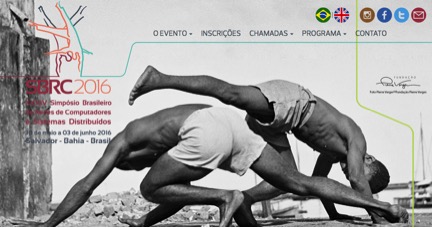 AmLight Team (NSF Awards # ACI 1451018 and 0963053) participated in the Brazilian Symposium on Computer Networks and Distributed Systems (SBRC), an annual event promoted by Brazilian Computer Society (SBC) and the National Laboratory of Computer Networks (LARC). For more than three decades, SBRC has become the most important national scientific event on computer networks and distributed systems, and one of the most crowded in the computer science field. AmLight Team (NSF Awards # ACI 1451018 and 0963053) participated in the Brazilian Symposium on Computer Networks and Distributed Systems (SBRC), an annual event promoted by Brazilian Computer Society (SBC) and the National Laboratory of Computer Networks (LARC). For more than three decades, SBRC has become the most important national scientific event on computer networks and distributed systems, and one of the most crowded in the computer science field.
The 34th edition of this Symposium is held from May, 30th until June 3rd in Salvador, Bahia. The event coordination is under the conjunct responsibility of the Department of Computer Science of Federal University of Bahia (UFBA) and the Federal Institute of Bahia (IFBA). The event is composed of technical sessions, mini courses, panel discussions and debates, workshops, tools salon, speakers, tutorials presented by internationally renowned researchers.
AmLight Team presented 2 academic papers: (1) Moving an IP network to SDN: a global use case deployment experience at AmLight, (2) AmLights OpenFlow Sniffer dissected: Troubleshooting production networks at VII Workshop Experimental Future Internet Research (WPEIF) and participated in a panel session "100Gbps: challenges, implications and consequences" at the XVII Workshop of the National Network of Education and Research (WRNP)
To download "Moving an IP network to SDN: a global use case deployment experience at AmLight" presentaton and academic paper.
To download "AmLights OpenFlow Sniffer dissected: Troubleshooting production networks" presentation and academic paper.
For full SBRC program click here.
Internet2 Global Summit 2016
Chicago, IL, May 15-18, 2016
 The theme for the 2016 Global Summit in Chicago—site of the first official meeting that eventually led to the formation of Internet2 focused on honoring the members who have shaped and developed Internet2 over the past 20 years, and showcasing visionaries whose work and strategies will shape the next 20 years for Internet2 and the entire R&E community. Dr. Julio Ibarra, Dr. Heidi Morgan, and Jeronimo Bezerra participated in Internet2 Global Summit 2016 collaborative session presentations. The theme for the 2016 Global Summit in Chicago—site of the first official meeting that eventually led to the formation of Internet2 focused on honoring the members who have shaped and developed Internet2 over the past 20 years, and showcasing visionaries whose work and strategies will shape the next 20 years for Internet2 and the entire R&E community. Dr. Julio Ibarra, Dr. Heidi Morgan, and Jeronimo Bezerra participated in Internet2 Global Summit 2016 collaborative session presentations.
Since its inception, Internet2 has connected people, networks, technologies, and solutions across the research and education (R&E) ecosystem. Working together, the Internet2 community continues to transform and elevate the development of revolutionary innovations in network and infrastructure technologies—from building the world’s fastest network, to expanding to meet global needs, to growing an extensive portfolio of end-to-end global network services, cloud services, and trust and identity capabilities—for the benefit of educators around the nation and the globe.
For "SDN Optimized Advanced Network Services for Experiments" pdf presentation click here.
For "The Latin American Landscape: Updates and Discussion with NREN Leaders" pdf presentation click here.
For "Open Exchange Points and SDX’s – Attributes for Understanding" pdf presentation click here.
For full program click here.
Americas Lightpaths Express and Protect Activates First US – Latin America 100G Networking Link Enhancing Infrastructure for Research and Education
Miami, Florida, May 11, 2016
 Florida International University’s Center for Internet Augmented Research and Assessment (CIARA) is pleased to announce the first 100G research and education network link between the U.S. and Latin America, a major component of the five-year AmLight ExP (IRNC BACKBONE: Americas Lightpaths Express and Protect) NSF Award#ACI-1451018. Florida International University’s Center for Internet Augmented Research and Assessment (CIARA) is pleased to announce the first 100G research and education network link between the U.S. and Latin America, a major component of the five-year AmLight ExP (IRNC BACKBONE: Americas Lightpaths Express and Protect) NSF Award#ACI-1451018.
On April 18, the AmLight Consortium activated the first 100G link of the AmLight-ExP project. It has 106ms delay and it goes via the Atlantic between Miami, FL and Sao Paulo, Brazil. The 100G link is under evaluation for the next 30 days. “To date, we have not seen any packet loss or errors and, to evaluate it, we are using an IXIA 100G packet generator,” said Jeronimo Bezerra AmLight Chief Network Engineer.
The AmLight Consortium is a group of not-for-profit universities, state, national and regional research and education networks including the AmLight ExP project at Florida International University, RNP, ANSP, RedClara, REUNA, FLR, AURA, Latin American Nautilus, and Internet2.
Robert Grillo, Vice President and CIO at Florida International University said, “This milestone for FIU sets new standards for high speed networking and bandwidth in the Americas that will promote new and innovative activities for all education and research institutions. Our vision will continue to advance scientific research and scholarship across the globe in collaboration with all our partners.”.
For full press release click here.
To download pdf click here.
Angola Cables & Americas Lightpaths Consortium Sign Memorandum of Understanding; Infrastructure for Research and Education
Miami, FL, April 1, 2016
 Angola Cables, SA and Florida International University’s Center for Internet Augmented Research and Assessment (CIARA) are pleased to announce the signing of a memorandum of understanding (MOU) to jointly collaborate on the development of a next-generation Internet network for research and education between Africa, the U.S. and Latin America. Angola Cables, SA and Florida International University’s Center for Internet Augmented Research and Assessment (CIARA) are pleased to announce the signing of a memorandum of understanding (MOU) to jointly collaborate on the development of a next-generation Internet network for research and education between Africa, the U.S. and Latin America.
The major goal of the MOU between Angola Cables and the AmLight Consortium is to link the researchers, students, knowledge creation, and knowledge sharing communities of the the nations of Africa, the US, Brazil, and other Latin American countries towards building effective multi-institutional research collaborations. The FIU AmLight Consortium Principal Investigator, Dr. Julio Ibarra, said,” This is the first step to provide a bridge from the current infrastructure, to one that will provide access to information abundance and unprecedented resources for research and education communities.” Antonio Nunes, CEO of Angola Cables said, “The new research and education infrastructure will enable research and education amongst the people of Africa and the Americas through the operation of production network infrastructure for communication and collaboration. This is one of the purposes of SACS, our main project, to give people the opportunity to share ideas and knowledge and improve social and economic development.”
To view full pressrelease click here.
To download a pdf version click here.
Open Networking Summit 2016
Santa Clara, CA, March 14-17, 2016
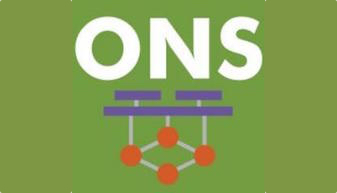 Jeronimo Bezerra, CIARA IT Assistant Director, presented an overview of the AmLight migration to an SDN approach and describe the experience of using ONOS/SDN-IP at Open Network Summit (ONS) 2016. Jeronimo Bezerra, CIARA IT Assistant Director, presented an overview of the AmLight migration to an SDN approach and describe the experience of using ONOS/SDN-IP at Open Network Summit (ONS) 2016.
ONS 2016 brought together the global SDN / NFV ecosystem and open source community to showcase solutions that are transforming networking for service providers, data centers and enterprises and to help developers and architects keep up with the SDN/NFV tools and technologies ready for evaluation and deployment. The focus of the 2016 event was on enabling the understanding of the open networking landscape and how it advances SDN and NFV through pragmatic use-cases, making ONS the ideal forum for companies to share their thought leadership positions and production innovations in the area of open source networking.
For video presentation click here.
2016 Network Performing Arts Production Workshop
Miami, FL, March 21-23, 2016
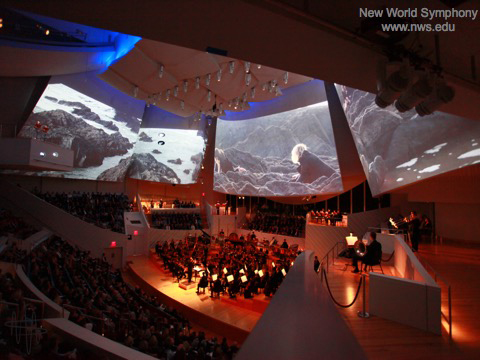 AMPATH will participate in the annual three-day conference hosted by New World Symphony and sponsored by Internet2 and GÉANT. The workshops will allow academics, artists, technology professionals and arts administrators to discuss artistic endeavors that utilize advanced networking applications; learn about and use cutting-edge distance-education technology; and explore new ways of incorporating audio and visual technology in performances. AMPATH will participate in the annual three-day conference hosted by New World Symphony and sponsored by Internet2 and GÉANT. The workshops will allow academics, artists, technology professionals and arts administrators to discuss artistic endeavors that utilize advanced networking applications; learn about and use cutting-edge distance-education technology; and explore new ways of incorporating audio and visual technology in performances.
Innovative presentations about artistic interaction via network an overview of the emerging trends and technologies will be featured throughout the workshop (LOLA project). The Online Orchestra(Falmouth University) will allow people who live hundreds of miles apart to make music together for the first time. The Online Orchestra is a research project funded by the Arts and Humanities Research Council (AHRC). The objective is to use the Internet to give children and amateur musicians who live in remote communities around the country the same opportunities to play in an orchestra as those who live in larger towns and cities.
For full program click here.
For registration click here.
CIARA’s OSDC-PIRE Fellowship Opens Doors
Miami, FL, February 8, 2016
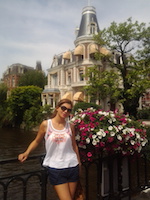 When Dr. Fatemeh Abyarjoo began her participation as an Open Science Data Cloud International Research and Education (OSDC-PIRE) fellow through CIARA, she did not know it would be a life-changing experience. Before her fellowship, Dr. Abyarjoo was pursuing her doctorate at FIU in Electrical Engineering. At the time, she was researching the feasibility of a virtual reality glove used to track human hand motion, which would be used in multiple applications — in healthcare (monitoring the rehabilitation after a stroke or seizure or observing elderly patients) in athletics (recording athlete’s movements to assist trainers and coaches), and recreationally (virtual reality gaming). In her research, Dr. Abyarjoo gathered real-time information all day long from three sensors located within the gloves. Each of these sensors had a sampling grade of 213 samples per second; as one can imagine, this generated a huge amount of data, and she faced limitations in managing, storing, and processing data. When Dr. Fatemeh Abyarjoo began her participation as an Open Science Data Cloud International Research and Education (OSDC-PIRE) fellow through CIARA, she did not know it would be a life-changing experience. Before her fellowship, Dr. Abyarjoo was pursuing her doctorate at FIU in Electrical Engineering. At the time, she was researching the feasibility of a virtual reality glove used to track human hand motion, which would be used in multiple applications — in healthcare (monitoring the rehabilitation after a stroke or seizure or observing elderly patients) in athletics (recording athlete’s movements to assist trainers and coaches), and recreationally (virtual reality gaming). In her research, Dr. Abyarjoo gathered real-time information all day long from three sensors located within the gloves. Each of these sensors had a sampling grade of 213 samples per second; as one can imagine, this generated a huge amount of data, and she faced limitations in managing, storing, and processing data.
In summer 2015, Dr. Abyarjoo decided to pursue a fellowship to assist her in completes her doctorate. She chose the OSDC-PIRE project from FIU’s Center for Internet Augmented Research and Assessment (CIARA), which provides research and education experiences through training and study at universities and research institutes around the world with leading scientists in the field of computing. To complete her thesis, she traveled to the University of Amsterdam in the Netherlands. In this collaborative environment, Dr. Abyarjoo thrived.
“It was really interesting because graduate school did not allow me to be exposed to other fields which required big data. In that program, my colleagues were from different departments — I was exposed to people from economy, biology, physics, media — people with different backgrounds,” said Dr. Abyarjoo. “Seeing how this field (big data) is applicable to other fields was a really good experience, and getting feedback was valuable as you cannot find it when you are in a specific department, where you have same-minded people around you. Having the background from other people with different backgrounds was very valuable”.
Because of Dr. Abyarjoo’s previous familiarity with mathematics and algorithms, as she became more familiar with cloud computing, she found that she had a base knowledge of multiple applications in various fields that interested her — finance, marketing, economy, politics, etc. Because of her participation in the CIARA program, after Dr. Abyarjoo graduated with her doctorate in Electrical Engineering from FIU, she switched careers from engineering to data science and now works in the financial industry.
Two years ago, Dr. Abyarjoo did not imagine herself switching from engineering to science, and had no idea of the various applications of big data. Because of her exposure to big data analytics during her OSDC-PIRE fellowship, Dr. Abyarjoo found that she had a passion for big data, and now has landed her dream job as a data scientist. “Everyone talks about big data, but nobody knows what it is - there is vague knowledge and understanding,” said Dr. Abyarjoo, “If you know big data — that opens doors”.
NSF Award# IIA-1129076, $4,224,324, 2010 – 2015, PIRE: Training and Workshops in Data Intensive Computing Using The Open Science Data Cloud
For more information about research and other opportunities available from CIARA, email us at contacts@amlight.net or call 305-348-4105.

2015
Super Computing Conference 2015
Austin, TX, November 15-20, 2015
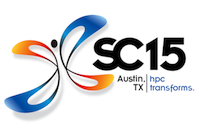 CIARA FIU participates in demonstration at Super Computing Conference "SDN Optimized High-Performance Data Transfer Systems for Exascale Science" CIARA FIU participates in demonstration at Super Computing Conference "SDN Optimized High-Performance Data Transfer Systems for Exascale Science"
The next generation of major science programs face unprecedented challenges in harnessing the wealth of knowledge hidden in Exabytes of globally distributed scientific data. Researchers from Caltech, FIU, Stanford, Univ of Michigan, Vanderbilt, UCSD, UNESP, along with other partner teams have come together to meet these challenges, by leveraging the recent major advances in software defined and Terabit/sec networks, workflow optimization methodologies, and state of the art long distance data transfer methods. This demonstration focuses on network path-building and flow optimizations using SDN and intelligent traffic engineering techniques, built on top of a 100G OpenFlow ring at the show site and connected to remote sites including the Pacific Research Platform (PRP). Remote sites will be interconnected using dedicated WAN paths provisioned using NSI dynamic circuits. The demonstrations include (1) the use of Open vSwitch (OVS) to extend the wide area dynamic circuits storage to storage, with stable shaped flows at any level up to wire speed, (2) a pair of data transfer nodes (DTNs) designed for an aggregate 400Gbps flow through 100GE switches from Dell, Inventec and Mellanox, and (3) the use of Named Data Networking (NDN) to distribute and cache large high energy physics and climate science datasets.
In addition to the demo CIARA FIU participates in Special workshop “SDN for Scientific Networking”, a technical half-day workshop held in conjunction with SuperComputing’15, that brings together domain scientists, HPC experts, network operators and security practitioners for a discussion of the current state of Software Defined Networking (SDN).
CIARA presentations at SC15:
Title: "OpenWave: U.S.-Brazil 100G Experimental Alien Wave" Download pdf
Time: 10:00am - 10:20am, Nov 17th at Caltech Booth
Presenters: Julio Ibarra, Heidi Morgan, Donald Cox, and Louis Fox
Title: "LSST Project Update" Download pdf, Click here to watch video about LSST
Time: 10:00am - 10:20am, Nov 19th at Caltech Booth
Presenters: Heidi Morgan
Title: "Data Transfer in a Science DMZ using SDN with Applications for Precision Medicine in Cloud and High-performance Computing" Download pdf
Time: 8:40am - 9:00am, Nov 20th
Presenters: Nam Pho, Dino Magri, Fernando Redigolo, Byoung-Do Kim, Timothy Feeney, Heidi Morgan, Chirag Patel, Chris Botka and Tereza Carvalho
Title: "AtlanticWave-SDX: An International SDX to Support Science Data Applications"
Download pdf presentation, Download academic paper
Time: 9:20am - 9:40am, Nov 20th
Presenters: Joaquín Chung, Jacob Cox, Julio Ibarra, Jeronimo Bezerra, Heidi Morgan, Russell Clark and Henry Owen
For more details please click here.
For Caltech article please click here.
Second SwitchOn Workshop
Sao Paulo, Brazil, October 15-16, 2015
 The SwitchOn workshop, with the participation of Brazilian and American researchers, took place in University of Sao Paulo Medical School, Brazil on October 15-16, 2015 The SwitchOn workshop, with the participation of Brazilian and American researchers, took place in University of Sao Paulo Medical School, Brazil on October 15-16, 2015
Organized by CIARA/FIU (the FIU Center of Internet Augmented Research and Assessment) and University of Sao Paulo Medical School, the event aimed to encourage collaboration between researchers from Brazil and the United States in research on Future Internet.
Over the course of two days of activities, researchers from several American and Brazilian universities and research centers had the opportunity to make presentations and exchange information on the development of their research projects.
In addition, thematic breakout sessions were organized to enable discussion of issues of common interest to the research groups: “Future Networks Design and Applications”, “Clouds and Data Center Networking” and Cyberinfrastructure “.
The event was supported by the National Science Foundation (NSF), University of Sao Paulo Medical School and by the supplier of networking equipment, Brocade, who also had an opportunity to deliver presentations on their R&D projects.
For more details please click here.
15th Annual Global LambdaGrid Workshop
September 29-30, 2015, Prague, Czech Republic
 AMPATH participate in the 15th Annual Global LambdaGrid Workshop at Prague, Czech Republic. AMPATH participate in the 15th Annual Global LambdaGrid Workshop at Prague, Czech Republic.
Jeronimo Bezerra, AMPATH Senior Network Engineer, presented "Running production and experimentation at AmLight SDN: Lessons Learned and Future."
Chip Cox presented "OpenWave: Deploying a 100G experimental alien wave between the US and Brazil."
GLIF is an international virtual organisation that promotes the paradigm of lambda networking. The GLIF participants are National Research and Education Networks (NRENs), consortia and institutions working with lambdas. The GLIF participants jointly make lambdas available as an integrated global facility for use by scientists and projects involved in data-intensive scientific research.
The 15th Annual Global LambdaGrid Workshop brings together leading network engineers worldwide to collaborate and exchange knowledge on new lambda networking technologies, middleware and applications.
Website | Schedule | Participants | Presentation
National Science Foundation (NSF) Research Experience Undergraduate (REU) Software Defined Networking (SDN) Student Fellowships
Miami, FL July 28, 2015
 The Center for Internet Augmented Research and Assessment (CIARA) at Florida International University’s Modesto Maidique Campus is recruiting two undergraduate computer science and / or engineering students to participate in projects involving the building and operation of SDN networks to support research between the U.S. and Brazil. The fellowships are funded under the Award Abstract #1451018 IRNC: Backbone: AmLight Express and Protect (ExP). The Center for Internet Augmented Research and Assessment (CIARA) at Florida International University’s Modesto Maidique Campus is recruiting two undergraduate computer science and / or engineering students to participate in projects involving the building and operation of SDN networks to support research between the U.S. and Brazil. The fellowships are funded under the Award Abstract #1451018 IRNC: Backbone: AmLight Express and Protect (ExP).
This NSF Funded Undergraduate Fellowship pays a stipend of $6,000 total per student over the annual appointment. Stipend is paid either monthly or quarterly when project deliverables are met. This is a Temporary Grant-Funded fellowship. Undergraduate student participants in REU Supplements must be U.S. citizens, U.S. nationals, or permanent residents of the United States.
Synopsis of Program: The Research Experiences for Undergraduates (REU) program supports active research participation by undergraduate students in any of the areas of research funded by the National Science Foundation. REU projects involve students in meaningful ways in ongoing research programs or in research projects specifically designed for the REU program
For details how to apply click here.
TERENA Networking Conference (TNC15)
Porto, Portugal June 15-18, 2015
 Dr. Julio Ibarra and Dr. Heidi Morgan participated in session “Operational aspects of SDN” at TNC15 in Porto, Portugal with presentation “Use of SDN in the AmLight intercontinental R&E network “. This session described various operational aspects and their implications of of Software Defined Networking. Dr. Julio Ibarra and Dr. Heidi Morgan participated in session “Operational aspects of SDN” at TNC15 in Porto, Portugal with presentation “Use of SDN in the AmLight intercontinental R&E network “. This session described various operational aspects and their implications of of Software Defined Networking.
The TNC15 Networking Conference is the largest and most prestigious European research networking conference, with more than 650 participants attending this annual event. TNC brings together decision makers, managers, networking and collaboration specialists, and identity and access management experts from all major European networking and research organisations, universities, worldwide sister institutions, as well as industry representatives.
Through keynotes speeches by renowned specialists, varying parallel sessions, demonstrations and presentations, the Conference presents participants with a unique overview of the latest developments in research networking, both in the technical field and in the area of application and management.
For Dr. Julio Ibarra’s presentation click here.
For Video record click here.
For TNC15 info click here.
CIARA at OSDC PIRE 2015 Data- Intensive Research Workshop
Big Data and Cloud Computing
June 8-12, 2015, Amsterdam, Netherlands

FIU CIARA participates in the third OSDC workshop in Amsterdam, Netherlands (opensciencedatacloud.org funded in part by the NSF PIRE program) will gather young researchers and experts to address today's challenges and to develop understanding in how best to exploit our growing wealth of data. The Open Science Data Cloud PIRE project provides international research and education experiences through training and study at universities and research institutes around the world with leading scientists in the field of computing. OSDC-PIRE goal is to increase the participants with expertise in managing and analyzing data. The creation of a strong cadre of students with a global perspective on scientific data management will support research endeavors in many other areas vital to the US. International Collaboration.
Organization:
Robert Grossman, PhD, University of Chicago
Maria Patterson, PhD, University of Chicago
Heidi Morgan, PhD, Florida International University
Paola Grosso, PhD, University of Amsterdam
Cees de Laat, PhD, University of Amsterdam
Miroslav Zivkovic, PhD, University of Amsterdam
For Dr. Heidi Morgan presenation click here.
For more details check OSDC PIRE website here.
33rd Brazilian Symposium on Computer Networks and Distributed Systems
Vitória, Brazil May 18-22, 2015
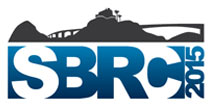 The Brazilian Symposium on Computer Networks and Distributed Systems (SBRC) is an annual event promoted by the Brazilian Computer Society (SBC) and the National Laboratory of Computer Networks(LARC). Over more than three decades of achievement, SBRC has become the most important national scientific event on computer networks and distributed systems in Brazil, and one of the busiest in the area of Computer Science. The Brazilian Symposium on Computer Networks and Distributed Systems (SBRC) is an annual event promoted by the Brazilian Computer Society (SBC) and the National Laboratory of Computer Networks(LARC). Over more than three decades of achievement, SBRC has become the most important national scientific event on computer networks and distributed systems in Brazil, and one of the busiest in the area of Computer Science.
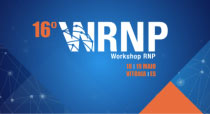 Dr. Julio Ibarra and Senior Netwrok Engineer Jeronimo Bezerra, from Florida International University (CIARA), pointed SDN technology as the future of international academic collaboration in resentation "AmLight ExP & AtlanticWave-SDX: new projects supporting Future Internet Research between U.S. & South America" at workshop for Experimental Research for
Future Internet (WPEIF2015). Additional presentation " AmLight SDN : Future of
International Academic collaboration" was presened on portugues at Brazilian National Research and Educational Network workshop (16th WRNP). Dr. Julio Ibarra and Senior Netwrok Engineer Jeronimo Bezerra, from Florida International University (CIARA), pointed SDN technology as the future of international academic collaboration in resentation "AmLight ExP & AtlanticWave-SDX: new projects supporting Future Internet Research between U.S. & South America" at workshop for Experimental Research for
Future Internet (WPEIF2015). Additional presentation " AmLight SDN : Future of
International Academic collaboration" was presened on portugues at Brazilian National Research and Educational Network workshop (16th WRNP).
For WRNP presentation click here.
For WPEIF presentation click here.
Read RNP full article here.
For details from The Brazilian Symposium on Computer Networks and Distributed Systems (SBRC) click here.
14th IFIP/IEEE Symposium
Ottawa, Canada, May 11-15, 2015
 At 14th IFIP/IEEE Symposium, Jeronimo Bezerra presented an academic paper “Benefits brought by the use of OpenFlow/SDN in the AmLight intercontinental research and education network” . At 14th IFIP/IEEE Symposium, Jeronimo Bezerra presented an academic paper “Benefits brought by the use of OpenFlow/SDN in the AmLight intercontinental research and education network” .
The 14th IFIP/IEEE Symposium theme, “Integrated Management in the Age of Big Data” is examining the potential of Big Data to improve the quality of management in a number of areas, including: Network Management, Service Management, & Business Management, as well as in management approaches and methodologies. The emergence of network virtualized function also creates a great opportunity for traditional network management, and the instrumentation when the hardware is generic. With a strong technical program, keynote speakers, expert panels, & vendor exhibits as well as Dissertation and Young Professionals (GOLD) sessions this conference is providing opportunities for both education and networking.
For reference click here.
For copy of the paper click here.
FIU showcases tech innovations at eMerge Americas
Miami, FL, May 1-5, 2015
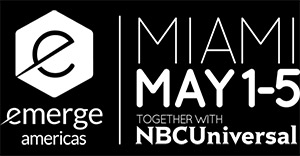 FIU has partnered with the Technology Foundation of the Americas to host eMerge Americas Techweek, a conference that brings together civic leaders, industry titans, entrepreneurs and global thought leaders with the purpose of establishing a technology hub for the Americas. The conference is an opportunity for entrepreneurs and investors to come together to develop and fund innovative projects and discuss the role of education in a tech-driven economy. FIU has partnered with the Technology Foundation of the Americas to host eMerge Americas Techweek, a conference that brings together civic leaders, industry titans, entrepreneurs and global thought leaders with the purpose of establishing a technology hub for the Americas. The conference is an opportunity for entrepreneurs and investors to come together to develop and fund innovative projects and discuss the role of education in a tech-driven economy.
At its pavilion, on May 5 and 6, FIU CIARA showcased work recently funded by the National Science Foundation to develop greater network infrastructure in the Americas - OpenWave 100G project and Americas Lightpaths (AmLight).
For event website click here.
For FIU article click here
Internet2 -Global Summit 2015
Washington, DC, April 26-30, 2015
 CIARA participated in Internet2 Global Summit 2015 in session "Innovation in Advanced Networking" with a netcast presented by Jeronimo Bezerra (CIARA Senior Network Engineer) and Marcos Schwarz (Rede Nacional De Ensino E Pesquisa-RNP). CIARA participated in Internet2 Global Summit 2015 in session "Innovation in Advanced Networking" with a netcast presented by Jeronimo Bezerra (CIARA Senior Network Engineer) and Marcos Schwarz (Rede Nacional De Ensino E Pesquisa-RNP).
The Global Summit is Internet2’s annual meeting that showcases how the research and education (R&E) community is transforming the way research and scholarship are conceived and conducted. The 2015 meeting will focus on the advancement of research capabilities through collaborative innovations in IT infrastructure and applications. Through strong academic leadership, perceptive global engagement and advanced innovations in networking and services, the Internet2 community continues its legacy of leading the way in expanding and transforming the global R&E community’s capabilities to advance research and academic excellence.
For pdf presentation click here.
For full program click here.
AtlanticWave-SDX: A Distributed Intercontinental Experimental Software Defined Exchange for Research & Education Networking
Miami, Florida, April 15, 2015
 Florida International University’s Center for Internet Augmented Research and Assessment (CIARA) is pleased to announce AtlanticWave-Software Defined Exchange: A Distributed Intercontinental Experimental Software Defined Exchange (SDX) NSF Award ACI#1451024. Florida International University’s Center for Internet Augmented Research and Assessment (CIARA) is pleased to announce AtlanticWave-Software Defined Exchange: A Distributed Intercontinental Experimental Software Defined Exchange (SDX) NSF Award ACI#1451024.
Software Defined Networking (SDN) deployments that cross multiple domains are constructed manually, involving significant coordination and effort by network operators. Americas Lightpaths (AmLight) is a production infrastructure for communication and collaboration between the U.S. and Western Hemisphere science and engineering research and education communities. In August 2014, AmLight evolved to become a full SDN. Demand is growing to develop the capability to support end-to-end network services, capable of spanning multiple SDN domains.
For CIARA FIU full press release click here.
For Georgia Tech press release click here.
Americas Lightpaths Express and Protect enhances Infrastructure for Research and Education
Miami, Florida, April 7, 2015
 Florida International University’s Center for Internet Augmented Research and Assessment (CIARA) is pleased to announce the five-year AmLight ExP (IRNC BACKBONE: Americas Lightpaths Express and Protect) NSF Award#ACI-1451018. Florida International University’s Center for Internet Augmented Research and Assessment (CIARA) is pleased to announce the five-year AmLight ExP (IRNC BACKBONE: Americas Lightpaths Express and Protect) NSF Award#ACI-1451018.
Scientific research and educational activities carried out between the U.S. and Latin American countries have been evolving, benefiting from the shared investments made by the U.S., Brazil and other countries in Latin America. Astronomy, High-Energy Physics, Comparative research in Biodiversity, Ecology and Genomics, Materials Science, Seismology, Future Internet Research, Ultra-High Definition (UHD) video and streaming research are some of the areas of collaborative science research activities, supported by research infrastructures and cyberinfrastructure distributed across the U.S. and Latin America, with diverse requirements for network services. "As data generated through scientific activities increases, so too does the demand for high-throughput production network services to transport data between the locations where they are collected or generated, and subsequently processed, analyzed and archived. These services must also support the advanced access and data mining uses of the scientific users distributed throughout the Western hemisphere and the world, together with the needs of the teachers and students using these datasets to open the minds of the next generations of researchers as well as citizen scientists," said Dr. R. Chris Smith, Director and Head of Mission of AURA Observatory in Chile.
For full press release click here.
Focused Technical Workshop: International OpenFlow/SDN Testbeds
Miami, March 31- April 2, 2015
 FIU and Internet2 hosted a multi-day workshop that will bring together network, software, and data management experts to discuss International OpenFlow/SDN Testbeds at the Kovens Conference Center. FIU and Internet2 hosted a multi-day workshop that will bring together network, software, and data management experts to discuss International OpenFlow/SDN Testbeds at the Kovens Conference Center.
The goal of the workshop was to initiate an active dialogue among those supporting and planning OpenFlow/SDN testbeds. Possible outcomes include developing best practices for specific challenge areas; expanding community knowledge base (through shared experiences and brainstorming on challenges and possible solutions); and establishing longer-term relationship building in motion. The workshop also hopes to provide broad, concrete, technical, immediately useful tools, and resources for improved testbed development and operations.
For pdf presentation by Dr. Julio Ibarra click here.
For prf presentation by Senior Network Engineer Jerronimo Bezerra click here.
For workshop program click here.
More details at Internet2 blog.
NANOG 63 Meeting
San Antonio on February 2-4, 2015
 CIARA participated at NANOG 63 with presentation "Migratng AmLight from legacy to SDN: Challenges, Results and Next Steps " .The North American Network Operators Group or NANOG, is the professional association for Internet engineering and architecture. Our core focus is on the technologies and systems that make the Internet function: core routing and switching; Internet inter-domain routing; the domain name system; peering and interconnection; and Internet core security. We also cover associated areas with a direct impact on Internet architecture such as data centers and optical networking. CIARA participated at NANOG 63 with presentation "Migratng AmLight from legacy to SDN: Challenges, Results and Next Steps " .The North American Network Operators Group or NANOG, is the professional association for Internet engineering and architecture. Our core focus is on the technologies and systems that make the Internet function: core routing and switching; Internet inter-domain routing; the domain name system; peering and interconnection; and Internet core security. We also cover associated areas with a direct impact on Internet architecture such as data centers and optical networking.
For pdf presentation by CIARA Senior Network Engineer Jeronimo Bezerra click here.
For video presentation click here.
For AmLight SDN website click here.
For NANOG website click here.
SwitchOn Workshop
Miami on January 8-9, 2015
 The SwitchOn workshop, with the participation of Brazilian and American researchers, took place in Miami, USA, in January 2015 The SwitchOn workshop, with the participation of Brazilian and American researchers, took place in Miami, USA, in January 2015
January 8 and 9, 2015 saw the staging of the workshop SwitchOn - Research Collaboration Education, in Miami, USA. The activities took place at the Kovens Conference Center on the Biscayne Bay campus of Florida International University (FIU), North Miami.
Organized by CIARA/FIU (the FIU Center of Internet Augmented Research and Assessment), the event aimed to encourage collaboration between researchers from Brazil and the United States in research on Future Internet.
Over the course of two days of activities, researchers from several American and Brazilian universities and research centers had the opportunity to make presentations and exchange information on the development of their research projects.
In addition, thematic breakout sessions were organized to enable discussion of issues of common interest to the research groups: “Future Networks Design”, “Clouds” and Cyberinfrastructure “.
The event was supported by the National Science Foundation (NSF) and by the suppliers of networking equipment, Brocade and Padtec, who also had an opportunity to deliver presentations on their R & D projects.
For more details please click here.

2014
Report of the 2014 NSF Cybersecurity Summit for Large Facilities and Cyberinfrastructure
Large Facility Cybersecurity Challenges and Responses
August 26 ‐ August 28, 2014
Westin Arlington Gateway ‐ Arlington, VAMLIGHT Network Upgrade adds Software-Defined Networking capability between the U.S. and South America. This event was supported in part by the National Science Foundation under Grant Number 1234408. Any opinions, findings, and conclusions or recommendations expressed at the event or in this report are those of the authors and do not necessarily reflect the views of the
National Science Foundation.
About this Report
Drafts of this report were circulated for comment to the Program Committee (November 5,
2014) and summit participants (December 3, 2014).
Citing this Report
Please cite as: Craig Jackson, James Marsteller, Von Welch. Report of the 2014 NSF
Cybersecurity Summit for Cyberinfrastructure and Large Facilities: Large Facility Cybersecurity
Challenges and Responses click here.
For the latest information on the Summit please click here.

AMLIGHT Network Upgrade adds Software-Defined Networking capability between the U.S. and South America
Miami, Florida- December 5, 2014
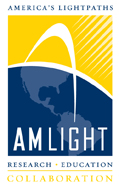 Florida International University’s Center for Internet Augmented Research and Assessment (CIARA) is pleased to announce an upgrade to the AMLIGHT network that creates the first Software-Defined Network to interconnect South America to the U.S., for research and education. Florida International University’s Center for Internet Augmented Research and Assessment (CIARA) is pleased to announce an upgrade to the AMLIGHT network that creates the first Software-Defined Network to interconnect South America to the U.S., for research and education.
The AMLIGHT collaboration has evolved to accommodate new capabilities to continually support research and collaboration requirements between South America and the U.S. But, due to technology and network protocols’ limitations, researchers were not able use AMLIGHT as a real platform for innovation, only as a transit network. With the deployment of Openflow, in August 2014, AMLIGHT became a Software-Defined Network. As a result, U.S. - South American researchers and their global collaborators can now benefit from improved network operations and support for programmability. With the improvement of network operations, provisioning activities are taking seconds to be accomplished, instead of days using the old-fashioned legacy approach. With network programmability, researchers can develop network-aware applications with access to AMLIGHT's network devices and provision the network accordingly to their needs. Voice over IP, big data, and video streaming applications are now able to provision their circuits on top of AMLIGHT, following specific network requirements such as low delay, fewer hops, and fewer packet errors.
For full press release click here.
For Caltech press release from Super Computing 2014 click here.

FIU awarded for AMLIGHT to provide an Advanced International Network for the Large Synoptic Survey Telescope (LSST) through 2031
Miami, Florida- November 12, 2014
 Florida International University’s Center for Internet Augmented Research and Assessment (CIARA) is pleased to announce AMLIGHT’s long-term support for a high-speed network, linking the NSF-funded Large Synoptic Survey Telescope (LSST) to the National Center for SuperComputing Applications (NCSA) and beyond through a sub-award from the Association of Universities for Research in Astronomy (AURA). This unprecedented long-term infrastructure will provide committed bandwidth capacity for LSST’s explicit needs, and communal bursts within the AMLIGHT collaboration. Florida International University’s Center for Internet Augmented Research and Assessment (CIARA) is pleased to announce AMLIGHT’s long-term support for a high-speed network, linking the NSF-funded Large Synoptic Survey Telescope (LSST) to the National Center for SuperComputing Applications (NCSA) and beyond through a sub-award from the Association of Universities for Research in Astronomy (AURA). This unprecedented long-term infrastructure will provide committed bandwidth capacity for LSST’s explicit needs, and communal bursts within the AMLIGHT collaboration.
The network architecture is a critical component of the design of LSST. AMLIGHT has contributed to the design of the network architecture for LSST, and supported the evolution of the regional network infrastructure since site planning in 2006. The network architecture allows for a design of LSST utilizing the computational resources of NCSA in Illinois to process in near real time the data from the telescope in Northern Chile.
The AMLIGHT collaboration will deploy multiple 100G links from Miami, to Fortaleza, Brazil, to São Paulo, and to Santiago, Chile, to provide the underlying infrastructure to support LSST’s committed bandwidth, and burst needs. Partners in the U.S. that interconnect with AMLIGHT and will help transport LSST’s data to NCSA include Florida LambdaRail, Internet2, and ESnet.
For full press release click here.
WorldCity's Tech Connections: Bandwidth Boom: Is Latin America ready?
Hyatt Regency Coral Gables, Friday, October 10, 2014
 Dr. Julio Ibarra will represent FIU CIARA at WordCity Tech Connections "Bandwidth Boom: Is Latin America ready?". FIU: College of Engineering & Computing is proud to showcase its different technology efforts from around the world! Tech Connections, a part of WorldCity's event Series, will take place at the Hyatt Regency Coral Gables on Friday, October 10th (08:00 AM - 09:30 AM). Dr. Julio Ibarra will represent FIU CIARA at WordCity Tech Connections "Bandwidth Boom: Is Latin America ready?". FIU: College of Engineering & Computing is proud to showcase its different technology efforts from around the world! Tech Connections, a part of WorldCity's event Series, will take place at the Hyatt Regency Coral Gables on Friday, October 10th (08:00 AM - 09:30 AM).
Limited complimentary registration to first attendees, register as "Current Tech Connections Corporate Member".
Registration | Website | About WordCity | Event Article
CineGrid Brasil 2014
University of São Paulo (USP) - Brazil, August, 28-29, 2014
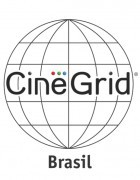 Dr. Julio Ibarra and Dr. Luis Lopez present research projects at CineGrid Brazil 2014 International Workshop in August 28-29, 2014, hosted by the University of São Paulo (USP).
This will be the Second CineGrid Brazil event with international attendees and speakers coming from the digital cinema and computing industry as well as academia and government. This CineGrid BR will be hosted in partnership with the 25th anniversary of Rede ANSP (Academic Network of São Paulo) held August 25-27 and both events will share attendees, infrastructure and speakers.
CineGrid Brazil is organized by CineGrid members and follows CineGrid’s mission to build an interdisciplinary community that is focused on the research, development, and demonstration of networked collaborative tools to enable the production, use, preservation, and exchange of very-high-quality digital media over photonic networks.
CineGrid Brazil is supported by USP, Rede ANSP, CAPES, CNPq, Mackenzie University, Federal University of Paraiba (UFPB) and Federal University of São Paulo (UNIFESP), RNP (National Academic Network of Brazil) Dr. Julio Ibarra and Dr. Luis Lopez present research projects at CineGrid Brazil 2014 International Workshop in August 28-29, 2014, hosted by the University of São Paulo (USP).
This will be the Second CineGrid Brazil event with international attendees and speakers coming from the digital cinema and computing industry as well as academia and government. This CineGrid BR will be hosted in partnership with the 25th anniversary of Rede ANSP (Academic Network of São Paulo) held August 25-27 and both events will share attendees, infrastructure and speakers.
CineGrid Brazil is organized by CineGrid members and follows CineGrid’s mission to build an interdisciplinary community that is focused on the research, development, and demonstration of networked collaborative tools to enable the production, use, preservation, and exchange of very-high-quality digital media over photonic networks.
CineGrid Brazil is supported by USP, Rede ANSP, CAPES, CNPq, Mackenzie University, Federal University of Paraiba (UFPB) and Federal University of São Paulo (UNIFESP), RNP (National Academic Network of Brazil)
All the BMA6 activities will take place in the University City (USP-Butantã).
On the three mornings, thematic symposiums will be developed in the
István Jancsó Auditorium of the Guita and José Mindlin Brasiliana Library.
Facilities in this new auditorium, in addition to the traditional features,
include the capability for image capture and the transmission of IPTV.
Courses will be offered in the afternoon, in the LaSSu (Laboratory for
Sustainability) building, in USP's Polytechnic School.
Website | Program | Program PDF
Article Portugues: Technologies of the cinema have scientific applications. By Elton Alisson - FAPESP News Agency
6th Biannual Meeting of ANSP( Academic Network at São Paulo), in conjunction with the "CineGrid Brazil 2014" International Conference
São Paulo - SP - Brazil,August, 25-29, 2014
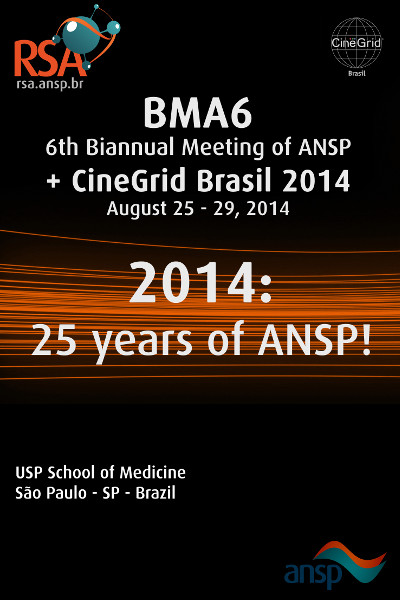 CIARA will participate in the 6th Biannual Meeting of ANSP (BMA6) in São Paulo at the University of São Paulo's Butantã campus from 25 to 27 August 2014. This will be a special meeting commemorating the 25th anniversary of the ANSP project!
As one of the objectives of the BMA is to promote closer ties and integration among the members of the ANSP Ecosystem and, in
particular, among the institutions that develop innovative research projects, BMA6 will be held in conjunction with CineGrid Brazil 2014, an international conference dedicated to the discussion and dissemination of video streaming projects that require high bandwidth. The activities of BMA6 take place from 25 to 27 August and those of CineGrid on 28 and 29 August. CIARA will participate in the 6th Biannual Meeting of ANSP (BMA6) in São Paulo at the University of São Paulo's Butantã campus from 25 to 27 August 2014. This will be a special meeting commemorating the 25th anniversary of the ANSP project!
As one of the objectives of the BMA is to promote closer ties and integration among the members of the ANSP Ecosystem and, in
particular, among the institutions that develop innovative research projects, BMA6 will be held in conjunction with CineGrid Brazil 2014, an international conference dedicated to the discussion and dissemination of video streaming projects that require high bandwidth. The activities of BMA6 take place from 25 to 27 August and those of CineGrid on 28 and 29 August.
All the BMA6 activities will take place in the University City (USP-Butantã).
On the three mornings, thematic symposiums will be developed in the
István Jancsó Auditorium of the Guita and José Mindlin Brasiliana Library.
Facilities in this new auditorium, in addition to the traditional features,
include the capability for image capture and the transmission of IPTV.
Courses will be offered in the afternoon, in the LaSSu (Laboratory for
Sustainability) building, in USP's Polytechnic School.
Program | Newsletter | Pictures | Impact of BMA6 article |
Article Portugues: The speed of the academic internet’s international connection will be doubled. By Elton Alisson - FAPESP News Agency
14th Annual Global LambdaGrid Workshop
September 29- October 1, 2014, Queenstown, New Zealand
 AMPATH participate in the 14th Annual Global LambdaGrid Workshop at Queenstown, New Zealand. AMPATH participate in the 14th Annual Global LambdaGrid Workshop at Queenstown, New Zealand.
Jeronimo Bezerra, AMPATH Senior Network Engineer, will present "Moving towards SDN at AmLight, AMPATH and SouthernLight"
GLIF is an international virtual organisation that promotes the paradigm of lambda networking. The GLIF participants are National Research and Education Networks (NRENs), consortia and institutions working with lambdas. The GLIF participants jointly make lambdas available as an integrated global facility for use by scientists and projects involved in data-intensive scientific research.
The 14th Annual Global LambdaGrid Workshop brings together leading network engineers worldwide to collaborate and exchange knowledge on new lambda networking technologies, middleware and applications.
Website | Schedule | Participants | Presentation

AmLight Consortium Research & Education Network
Helps Transmit FIFA World Cup in 8K from Brazil to Japan
Miami, Florida, July 22, 2014
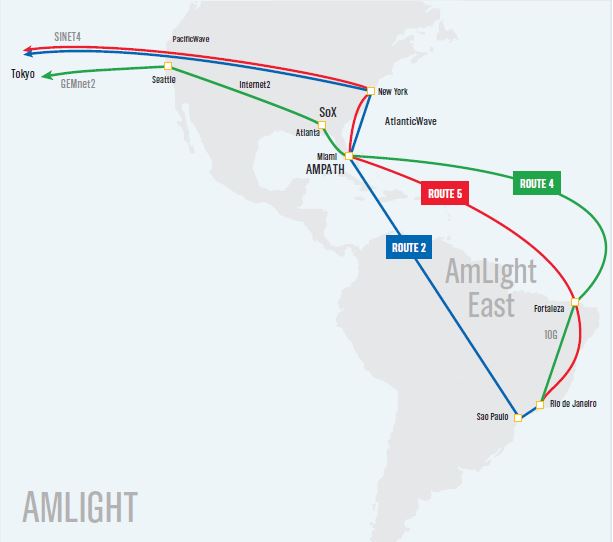 While the ball was rolling in the Brazilian stadiums between June 14th and July 13th, the Research & Education (R&E) networks played an important role in helping Japanese television to transmit the FIFA World Cup in 8K resolution (7.680 x 4.320 pixels) to Japan. The huge distance between Brazil and Japan set new challenges for streaming digital images spanning multiple domains over long-distance networks.
The project was led by the Japanese public television company, NHK, which has been experimenting and improving its new 8K streaming technology (branded "Super Hi-Vision" or SHV) since the 2012 London Olympic Games. NHK technology is currently able to compress SHV video flows to 300Mbps -- the same video would require almost 24 Gbps to be streamed if it were uncompressed. The current state of the art of digital television prevents 8K signals from being transmitted over long distances; therefore, this project relies on the technological support of Nippon Telegraph and Telephone Corp. (NTT) Network Innovation Labs, RNP (the National Education and Research Network of Brazil) , ANSP (The Academic Network of Sao Paulo) and other research networks worldwide. While the ball was rolling in the Brazilian stadiums between June 14th and July 13th, the Research & Education (R&E) networks played an important role in helping Japanese television to transmit the FIFA World Cup in 8K resolution (7.680 x 4.320 pixels) to Japan. The huge distance between Brazil and Japan set new challenges for streaming digital images spanning multiple domains over long-distance networks.
The project was led by the Japanese public television company, NHK, which has been experimenting and improving its new 8K streaming technology (branded "Super Hi-Vision" or SHV) since the 2012 London Olympic Games. NHK technology is currently able to compress SHV video flows to 300Mbps -- the same video would require almost 24 Gbps to be streamed if it were uncompressed. The current state of the art of digital television prevents 8K signals from being transmitted over long distances; therefore, this project relies on the technological support of Nippon Telegraph and Telephone Corp. (NTT) Network Innovation Labs, RNP (the National Education and Research Network of Brazil) , ANSP (The Academic Network of Sao Paulo) and other research networks worldwide.
For full press release click here.
CIARA at OSDC PIRE 2014 Data- Intensive Research Workshop
Big Data and Cloud Computing
June 16-20, 2014, Amsterdam, Netherlands

FIU CIARA participates in the third OSDC workshop in Amsterdam, Netherlands (opensciencedatacloud.org funded in part by the NSF PIRE program) will gather young researchers and experts to address today's challenges and to develop understanding in how best to exploit our growing wealth of data. The Open Science Data Cloud PIRE project provides international research and education experiences through training and study at universities and research institutes around the world with leading scientists in the field of computing. OSDC-PIRE goal is to increase the participants with expertise in managing and analyzing data. The creation of a strong cadre of students with a global perspective on scientific data management will support research endeavors in many other areas vital to the US. International Collaboration.
Organization:
Prof. Robert Grossman PhD, University of Chicago
Prof. Heidi Alvarez PhD, Florida International University
Prof. Paola Grosso PhD, University of Amsterdam
Prof. Cees de Laat PhD, University of Amsterdam
Please register at: https://osdc-pire-2014-amsterdam.eventbrite.com
|Download Program | Visit OSDC website | OSDC-PIRE Fellowship Application| Pico Presentation | Facebook Page | Workshop Presentations
TICAL2014 Conference
26 - 28 May, 2014 - Cancun Center, Cancun, Mexico
 Over than 400 attendees, parallel sessions, plenary sessions, forums, demonstrations and a variety of meetings and presentations gave life to three days of an intense work on issues related to Information Technologies and Communications on Higher Education institutions in the region. Over than 400 attendees, parallel sessions, plenary sessions, forums, demonstrations and a variety of meetings and presentations gave life to three days of an intense work on issues related to Information Technologies and Communications on Higher Education institutions in the region.
In order to enhance the work and the role of the Information and Communication Technologies (ICT) Directors of the universities of the region, since early 2011 the Information and Communication Technology Directors Network of Latin American universities has built a collaborative space that seeks to contribute to the continuous improvement of its institutions.
The TICAL Conference is the place where the community come together, which is feed primarily with the experiences, knowledge and initiatives presented by universities, providing significant and unprecedented solutions around ICT topics for higher education institutions in all the areas of the university labor.
Website | English Publication | Program
FIU showcases tech innovations at eMerge Americas
eMerge Americas Techweek, Tuesday, May 6, 2014, Miami Beach Convention Center
 FIU has partnered with the Technology Foundation of the Americas to host eMerge Americas Techweek, a conference that brings together civic leaders, industry titans, entrepreneurs and global thought leaders with the purpose of establishing a technology hub for the Americas. The conference is an opportunity for entrepreneurs and investors to come together to develop and fund innovative projects and discuss the role of education in a tech-driven economy.
FIU President Mark B. Rosenberg together with J.P. Morgan’s head of U.S. Southeast Private Bank, Phil Conway, and Florida State Rep. Erik Fresen, will host a discussion about the use of innovation and technology in education reform at 10:20 a.m. on Tuesday, May 6 at the Miami Beach Convention Center. FIU has partnered with the Technology Foundation of the Americas to host eMerge Americas Techweek, a conference that brings together civic leaders, industry titans, entrepreneurs and global thought leaders with the purpose of establishing a technology hub for the Americas. The conference is an opportunity for entrepreneurs and investors to come together to develop and fund innovative projects and discuss the role of education in a tech-driven economy.
FIU President Mark B. Rosenberg together with J.P. Morgan’s head of U.S. Southeast Private Bank, Phil Conway, and Florida State Rep. Erik Fresen, will host a discussion about the use of innovation and technology in education reform at 10:20 a.m. on Tuesday, May 6 at the Miami Beach Convention Center.
On hand at the conference will be representatives of the Florida Small Business Development Center at FIU, who will be providing no-cost consulting to entrepreneurs and businesses. Representatives of the FIU Applied Research Center will be available as well.
At its pavilion, on May 5 and 6, FIU will showcase work recently funded by the National Science Foundation to develop greater network infrastructure in the Americas - OpenWave 100G project and Americas Lightpaths (AmLight).

Academic Networks: Security Today and Tomorrow,
5th Biannual Meeting of ANSP( Academic Network at São Paulo)
São Paulo - SP - Brazil, April, 22-25, 2014
 Constantly striving to improve its services, the Academic Network at São Paulo (ANSP), has developed as one of its strategies, a means to building a closer relationship with its user entities and companies working in the Information Technologies and Communications market. With this objective, it created the concept of the ANSP Ecosystem and its biannual meetings. Constantly striving to improve its services, the Academic Network at São Paulo (ANSP), has developed as one of its strategies, a means to building a closer relationship with its user entities and companies working in the Information Technologies and Communications market. With this objective, it created the concept of the ANSP Ecosystem and its biannual meetings.
The ANSP Ecosystem aims to develop synergy for the exchange of ideas and technologies, for the testing of systems, protocols and equipment, in a skilled and demanding environment, and to establish the conditions to accelerate the dissemination of the various services and products of manufacturers and suppliers in the academic community.
The ANSP Biannual Meetings are the forum in which the ecosystem is reflected in the dissemination of the knowledge produced and the discussion of problems encountered both by ANSP's users and by the suppliers of equipment and services. Thus, the meetings consist of lectures, seminars, courses, workshops and any other means that may help increase and share knowledge among the participants.
ANSP's Biannual Meetings are open to all who wish to benefit from this privileged environment offered by the ANSP Ecosystem.
For more info click here.
Program | Presentation | Pictures
ANSP News: Demi Getschko is the first Brazilian to be nominated to the Internet Hall of Fame at a ceremony on 8 April, 2014, in Hong Kong.
The "Internet Hall of Fame", created in 2012 by the "Internet Society", honors leaders and innovators from around the world who have made extraordinary contributions to the change in the lives of citizens using the Internet. The awards are presented in three categories: "Pioneers Circle", "Innovators" and "Global Connectors".
Demi Getschko, an electrical engineer, was nominated in the category of "Global Connectors", which recognizes those who have made significant contributions to the growth and overall Internet use. Read more
2013 ANSP Yearbook
ANSP Newsletter
White Paper: NFV - Networks Functions Virtualization
Testimony of Prof. Cansian about Network Security
New Era in Latin American and Caribbean R&E Networking: Projects & Infrastructure Developments
2014 Internet2 Global Summit, Denver, CO, 6-11 April, 2014
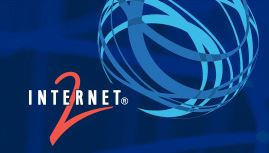 CIARA participated in 2014 Internet2 Global Summit with series of presentations "New Era in Latin American and Caribbean R&E Networking: Projects & Infrastructure Developments"
The theme for the 2014 Internet2 Global Summit was "Welcome to the New Era!" We are entering an exciting new era of innovation and transformation—driven by the research and education (R&E) community. Together, we are building a new unified, global platform of advanced network, cloud, and trust solutions to transform university operations and harness big data, catalyze team science, and propel a new cycle of international invention.
The Internet2 Global Summit program for 2014 featured keynotes from top R&E leaders, presentations from noted experts, and sessions focused on partnerships and advanced technologies, all designed to unleash your R&E potential. CIARA participated in 2014 Internet2 Global Summit with series of presentations "New Era in Latin American and Caribbean R&E Networking: Projects & Infrastructure Developments"
The theme for the 2014 Internet2 Global Summit was "Welcome to the New Era!" We are entering an exciting new era of innovation and transformation—driven by the research and education (R&E) community. Together, we are building a new unified, global platform of advanced network, cloud, and trust solutions to transform university operations and harness big data, catalyze team science, and propel a new cycle of international invention.
The Internet2 Global Summit program for 2014 featured keynotes from top R&E leaders, presentations from noted experts, and sessions focused on partnerships and advanced technologies, all designed to unleash your R&E potential.
Videos | Program | Presentations
BIG DATA BIG NETWORK 2
Mexico-California Research Collaboration Workshop
February 10-11, 2014, Calit2's Qualcomm Institute, UC San Diego

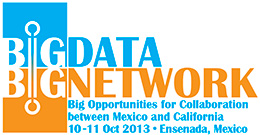 CIARA participate in Big Data, Big Network 2 is a two-day, invitation-only workshop to be held Feb. 10-11, 2014 at the Qualcomm Institute, the UC San Diego division of the California Institute for Telecommunications and Information Technology (Calit2) in Atkinson Hall on the UCSD campus in La Jolla, California. CIARA participate in Big Data, Big Network 2 is a two-day, invitation-only workshop to be held Feb. 10-11, 2014 at the Qualcomm Institute, the UC San Diego division of the California Institute for Telecommunications and Information Technology (Calit2) in Atkinson Hall on the UCSD campus in La Jolla, California.
BDBN2 is a follow-on workshop to the one held in October 2013 at the Centro de Investigación Científica y Educación Superior de Ensenada (CICESE, the Ensenada Center for Scientific Research and Higher Education). The purpose of that workshop was to enhance cross-border science and engineering research and education applications enabled by the AmLight West 10G connection operated by the Corporation for Education Network Initiatives in California (CENIC) in collaboration with Mexico’s Corporación Universitaria para el Desarrollo de Internet (CUDI, the University Corporation for Internet Development).
At the Ensenada workshop we identified existing and prospective users of the 10GigE network between Mexico and California, and we promoted new cross-border collaborations. The goal of this follow-on workshop at UC San Diego is to further document and promote Mexico-California research collaborations. We also aim to provide information and training to previously identified users on how best to use high-speed networking and display walls for research collaboration.
The BDBN2 workshop will focus on the use of networking and visualization resources in support of cross-border research, and it will include hands-on training and technology demonstrations as well as presentations.
During the workshop, investigators from the U.S. and Mexico will showcase and demonstrate applications and science drivers that benefit from advanced cyberinfrastructure.
The planned program and list of speakers will be posted on the website in January 2014.
If you have any questions or would like to register early for this workshop, please contact Greg Hidley at ghidley@ucsd.edu and include the title "BDBN2" in the subject line.
For information about the inaugural October 2013 Big Data Big Network Workshop hosted by CICESE in Ensenada, please click here.
Big Data, Big Network 2 | Registration | Program | Logistics | Presentations

AmLight supports wide-area network demonstrations in Super Computing 2013 (SC13)
Miami, Florida, February 3, 2014
 Florida International University FIU's AmLight project supported two long-haul network experiments that spanned the continents of South and North America. AmLight allocated up to 20Gbps of bandwidth capacity between Miami and São Paulo. With support from Florida LambdaRail (FLR), National LambdaRail (NLR) and Internet2, the 20Gbps of bandwidth capacity was extended from Miami to the SC13 show floor in Denver, Colorado. Layer2 lightpaths were provisioned from São Paulo to the show floor in Denver, overlayed on the AmLight, FLR, NLR and Internet2 AL2S backbone networks. The network diagram in Figure 1 illustrates the wide area and local area networks for High-Energy Physics (HEP) deployed by the Caltech team and partners, including the connections for the LHC CMS Tier2 Computing Centers in Rio de Janeiro (HEPGRID) and São Paulo (SPRACE), provided respectively by RNP and ANSP through the International Exchange Points in São Paulo (SouthernLight) and Miami (AMPATH), FLR, NLR and Internet2 AL2S. Florida International University FIU's AmLight project supported two long-haul network experiments that spanned the continents of South and North America. AmLight allocated up to 20Gbps of bandwidth capacity between Miami and São Paulo. With support from Florida LambdaRail (FLR), National LambdaRail (NLR) and Internet2, the 20Gbps of bandwidth capacity was extended from Miami to the SC13 show floor in Denver, Colorado. Layer2 lightpaths were provisioned from São Paulo to the show floor in Denver, overlayed on the AmLight, FLR, NLR and Internet2 AL2S backbone networks. The network diagram in Figure 1 illustrates the wide area and local area networks for High-Energy Physics (HEP) deployed by the Caltech team and partners, including the connections for the LHC CMS Tier2 Computing Centers in Rio de Janeiro (HEPGRID) and São Paulo (SPRACE), provided respectively by RNP and ANSP through the International Exchange Points in São Paulo (SouthernLight) and Miami (AMPATH), FLR, NLR and Internet2 AL2S.
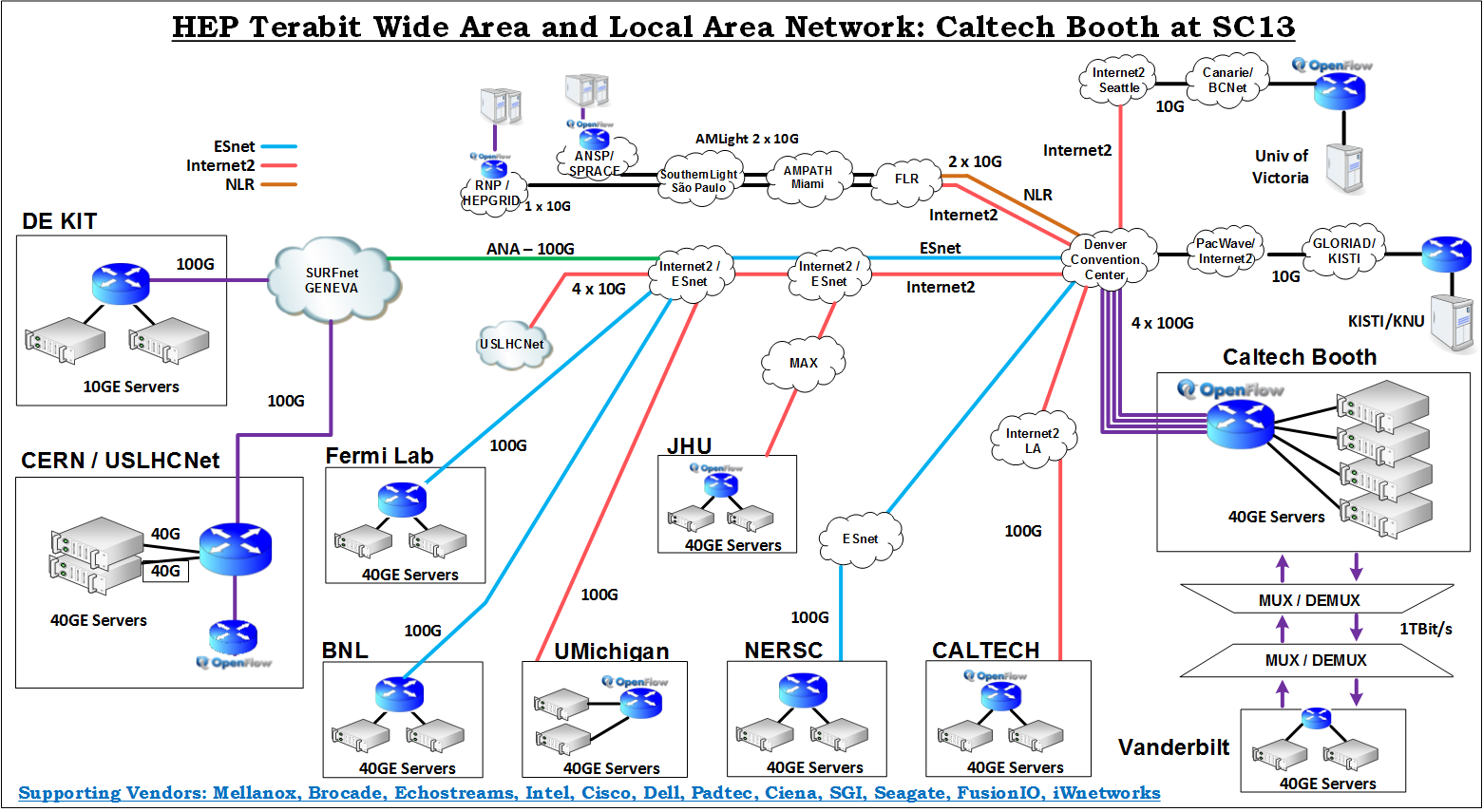
Figure 1 - HEP Terabit WAN and LAN for the Caltech Booth at SC13
The wide area network shown in Figure 1 represents the collaboration of many geographically distributed research and education networks, and computation and storage facilities, to form a global testbed environment, in order to conduct at-scale network experiments. The two experiments AmLight supported were (a) the GLIF Automated GOLE Network Services Interface (NSI) version 2.0 protocol; and (b) Openflow-based Multipath Networks in the WAN. The following is a description of these experiments and their results.
For full press release click here.
Big Data, Big Network: Mexico-US Cross-Border Research Workshop at CICESE in Ensenada, Baja Californiap
January 2014, CENIC Update, Volume 16 Issue 3: The quarterly newsletter of the Corporation for Education Network Initiatives in California
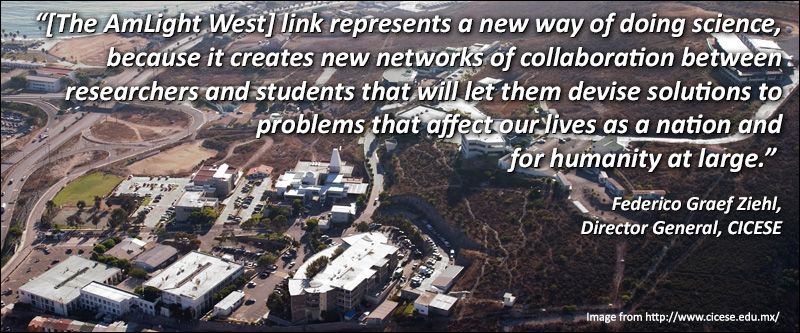
In 2010, the NSF International Research Networks Connections (IRNC) program funded Florida International University's Americas Lightpaths (AmLight) proposal, which included upgrading the network connection between Los Angeles, San Diego, and Tijuana to 10Gbps. In collaboration with CONACYT,CUDI, and other institutions in Mexico, funds were allocated to extend connectivity from Tijuana to Ensenada to connect CICESE at 10Gbps. The project enabled improvements in the last mile to benefit not only CICESE and collaborators located at the California Institute of Telecommunications and Information Technology (Calit2) but also the local campuses of the National Autonomous University of Mexico (UNAM) and the Autonomous University of Baja California(UABC) which, at the time, were expecting to be connected at this speed. The first light transmitted through the optical link from Calit2 to Tijuana and CICESE occurred in early March 2012. "This link represents a new way of doing science, because it creates new networks of collaboration between researchers and students that will let them devise solutions to problems that affect our lives as a nation and for humanity at large," said Federico Graef Ziehl, CICESE's Director General.
Click here to read full article from CENIC Update, Volume 16 Issue 3: The quarterly newsletter of the Corporation for Education Network Initiatives in California.

2013

100 Gigabit Undersea Network Innovation Bridges Education and Science Opportunities between the United States and Latin America
OpenWave Made Possible by NSF, the Brazilian Ministry of Science, Technology and
Innovation, the São Paulo State Research Foundation, and Florida International University
Miami, Florida, November 18, 2013
Florida International University's Center for Internet Augmented Research and Assessment (CIARA) is pleased to announce OpenWave, a breakthrough undertaking which connects the US to Brazil via an experimental ("alien") 100 Gigabits/second wave (optical transmission channel) by means of optical hardware that has never before been field tested over the distances involved.
OpenWave will use an already operating international undersea cable system to bridge the route between Miami, FL, and São Paulo, Brazil, including a 5600km submarine link between St. Croix, U.S. Virgin Islands, and Fortaleza, Brazil.
The 100G optical equipment has been tested with simulated distances of 5600km in a laboratory setting in Campinas, São Paulo state, Brazil, which has been in operation for over ten years. OpenWave will use this cable system to provide high-capacity, high-quality IP and circuit-oriented connections (hybrid network services) between research and education networks in the U.S. and the RNP and ANSP networks in Brazil, to support large-scale international e-Science ("Big Science") applications.
For full press release click here or download here.
Florida International University received a supplement to the Americas Lightpaths (AmLight) award (ACI-0963053) to deploy an unprecedented experimental 100G alien wave between the U.S. and Brazil - Presentation at SC13 and Schedule.
OSDC at Super Computing 2013 Conference - SC13
Denver, CO, November 17 - 22, 2013
 OSDC participating at SC13 with Session "Collaborative Opportunities with the Open Science Data Cloud". For a quarter of a century, the Supercomputing Conference has served as the crossroads for the entire HPC community. From users and program managers to colleagues and vendors...from government to private industry to academia...SC has provided unparalleled cooperation, unequaled collaboration, and unmatched exposure. OSDC participating at SC13 with Session "Collaborative Opportunities with the Open Science Data Cloud". For a quarter of a century, the Supercomputing Conference has served as the crossroads for the entire HPC community. From users and program managers to colleagues and vendors...from government to private industry to academia...SC has provided unparalleled cooperation, unequaled collaboration, and unmatched exposure.
And what better place to celebrate our 25th year than in Denver, Colorado? Located near the center of the continental United States, at the convergence of mountain and prairie, where high-rise buildings greet open range and the earth touches the sky, Denver is a community boldly moving into the future.
Spotlighting the most advanced scientific and technical applications in the world, SC13 will bring together the international supercomputing community for an exceptional program of technical papers, tutorials and timely research posters. The SC13 Exhibition Hall will feature exhibits of the latest and greatest technologies from industry, academia and government research organizations; many of these technologies will be seen for the first time in Denver.
OSDC Birds of a Feather | Website
Academic and Research technology access through Internet2 Training sessions
September 26, 2013, FUNGLODE, Santo Domingo, Dominican Republic
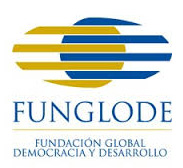 Fundacion Global Democracia y Desarrollo (FUNGLODE), The Center for Internet Augmented Research and Assessment (CIARA) at Florida International University (FIU) and the Nap del Caribe are pleased to sponsor the Academic and Research Technology access through Internet2 Training Sessions. This workshop will offer a special learning opportunity that describes the capabilities of the Academic and Research Technology through Internet2 which allows FUNGLODE and CIARA to expand their connectivity and involvement to other International Research and Education Institutions. Fundacion Global Democracia y Desarrollo (FUNGLODE), The Center for Internet Augmented Research and Assessment (CIARA) at Florida International University (FIU) and the Nap del Caribe are pleased to sponsor the Academic and Research Technology access through Internet2 Training Sessions. This workshop will offer a special learning opportunity that describes the capabilities of the Academic and Research Technology through Internet2 which allows FUNGLODE and CIARA to expand their connectivity and involvement to other International Research and Education Institutions.
Please see training session on spanish here.
Big Data, Big Network: Big Opportunities for Collaboration between Mexico and the United States
October 10-11, 2013
 CIARA participate in Big Data, Big Network, a two-day, invitation-only workshop on October 10-11, 2013 at the Centro de Investigación Científica y Educación Superior de Ensenada (Ensenada Center for Scientific Research and Higher Education, CICESE). The purpose of the workshop is to enhance cross-border science and engineering research and education applications enabled by the AmLight West 10G connection operated byCENIC in collaboration with Mexico’s Corporación Universitaria para el Desarrollo de Internet (University Corporation for Internet Development, CUDI). CIARA participate in Big Data, Big Network, a two-day, invitation-only workshop on October 10-11, 2013 at the Centro de Investigación Científica y Educación Superior de Ensenada (Ensenada Center for Scientific Research and Higher Education, CICESE). The purpose of the workshop is to enhance cross-border science and engineering research and education applications enabled by the AmLight West 10G connection operated byCENIC in collaboration with Mexico’s Corporación Universitaria para el Desarrollo de Internet (University Corporation for Internet Development, CUDI).
During the workshop, investigators from the US and Mexico will showcase and discuss applications and science drivers that will benefit from the use of the 10G connection. Areas of focus will include but are not limited to science gateways, oceanography, seismography, astronomy, nano-materials sciences, digital media, scientific instruments, and supercomputing centers.
For details please click here.
13th Annual Global LambdaGrid Workshop
October 2-4, 2013, Nanyang Technological University, Singapore
 AMPATH participate in the first Global LambdaGrid Workshop in the Southeast Asia region, hosted by SingAREN. AMPATH participate in the first Global LambdaGrid Workshop in the Southeast Asia region, hosted by SingAREN.
The 13th Annual Global LambdaGrid Workshop for Global Lambda Integrated Facility (GLIF) is hosted by Singapore Advanced Research and Education Network (SingAREN) on 2 - 4 October 2013. The co-organisers are Agency for Science, Technology and Research (A*STAR) and Nanyang Technological University (NTU).
GLIF is an international virtual organisation that promotes the paradigm of lambda networking. The GLIF participants are National Research and Education Networks (NRENs), consortia and institutions working with lambdas. The GLIF participants jointly make lambdas available as an integrated global facility for use by scientists and projects involved in data-intensive scientific research.
The 13th Annual Global LambdaGrid Workshop brings together leading network engineers worldwide to collaborate and exchange knowledge on new lambda networking technologies, middleware and applications.
Website | Schedule | Participants
Major Network Upgrade between Brazil and United States Enables International Collaboration and Innovation
AmLight 40 Gigabit Upgrade Made Possible by Brazil and U.S. Research & Education Networks ANSP, RNP and Florida International University
Miami, Florida, September 3, 2013
 Florida International University announced today that a three-year project upgraded the interconnectivity between the SouthernLight Exchange point in São Paulo, therefore doubling the network capacity between Latin America and the U.S. from twenty gigabits per second (Gb/s) to forty Gb/s.
This upgrade established a ring topology using four diverse ten Gb/s connections by moving data in both a clockwise and counterclockwise direction around a ring, providing redundancy in case of a fiber cut on one portion of the network links. Two of the four diverse ten Gb/s systems head east, with one stopping at Brazil's National Research and Education Network (RNP) exchange point in Rio de Janeiro, Brazil, continuing towards the new CearaLight Exchange point in Fortaleza, BR then on to Miami, Fla. The remaining two diverse 10 Gb/s systems are point west, with one stopping in Santiago, Chile then towards Miami via Panama.
"Academic Network of Sao Paulo (ANSP) provides connectivity to more than fifty institutions, which are responsible for more than forty percent of Brazilian science production. The present duplication of the international links is a natural continuation of our partnership with RNP and FIU established in 2004 and has been enhanced in one way or another every year since," said Dr Luis Lopez, Principal Investigator (PI) of ANSP. "Now, with a nominal connectivity of 40 G (and an expected minimum of no less than 30 G), our research community is able to increase even more their collaborations with other institutions, both in Brazil and abroad." Florida International University announced today that a three-year project upgraded the interconnectivity between the SouthernLight Exchange point in São Paulo, therefore doubling the network capacity between Latin America and the U.S. from twenty gigabits per second (Gb/s) to forty Gb/s.
This upgrade established a ring topology using four diverse ten Gb/s connections by moving data in both a clockwise and counterclockwise direction around a ring, providing redundancy in case of a fiber cut on one portion of the network links. Two of the four diverse ten Gb/s systems head east, with one stopping at Brazil's National Research and Education Network (RNP) exchange point in Rio de Janeiro, Brazil, continuing towards the new CearaLight Exchange point in Fortaleza, BR then on to Miami, Fla. The remaining two diverse 10 Gb/s systems are point west, with one stopping in Santiago, Chile then towards Miami via Panama.
"Academic Network of Sao Paulo (ANSP) provides connectivity to more than fifty institutions, which are responsible for more than forty percent of Brazilian science production. The present duplication of the international links is a natural continuation of our partnership with RNP and FIU established in 2004 and has been enhanced in one way or another every year since," said Dr Luis Lopez, Principal Investigator (PI) of ANSP. "Now, with a nominal connectivity of 40 G (and an expected minimum of no less than 30 G), our research community is able to increase even more their collaborations with other institutions, both in Brazil and abroad."
For full press release on English click here.
For full press release on Portuguese click here.
Graduate Research Fellowship Program (GRFP)

SUMMARY OF PROGRAM REQUIREMENTS
General Information
Program Title: Graduate Research Fellowship Program (GRFP)
Synopsis of Program:
The purpose of the NSF Graduate Research Fellowship Program (GRFP) is to help ensure the vitality and diversity of the scientific and engineering workforce of the United States. The program recognizes and supports outstanding graduate students who are pursuing research-based master's and doctoral degrees in fields within NSF's mission. The GRFP provides three years of support for the graduate education of individuals who have demonstrated their potential for significant achievements in science and engineering research.
Cognizant Program Officer(s):
Please note that the following information is current at the time of publishing. See program website for any updates to the points of contact.
Applications, contact: GRF Operations Center, telephone: (866) 673-4737, email: info@nsfgrfp.org
Gisele T. Muller-Parker, telephone: (703) 292-8694, email: grfp@nsf.gov
Pushpalatha Murthy, telephone: (703) 292-8694, email: grfp@nsf.gov
Doris L. Carver, telephone: (703) 292-8694, email: grfp@nsf.gov
For more information click here.
OSDC-PIRE Present Lightning Talk at TERENA Networking Conference (TNC)
Big Data and Cloud Computing
3-6 June 2013 Maastricht, Netherlands
 The TERENA Networking Conference (TNC) is the largest and most prestigious European research networking conference - over 500 participants including decision makers, networking specialists and managers from all major European networking and research organizations, universities, worldwide sister institutions and industry representatives attend. A Lightning Talk, presented by Dr. Julio Ibarra, on the Open Science Data Cloud Partnership for International Research and Education (OSDC-PIRE) Automated Provisioning in Cloud Computing using only open source applications was provided on June 3rd,2013. The talk entitled, "From bare metal to a compute or storage cloud" can be downloaded here. (NSF Award #1129076)
The TERENA Networking Conference (TNC) is the largest and most prestigious European research networking conference - over 500 participants including decision makers, networking specialists and managers from all major European networking and research organizations, universities, worldwide sister institutions and industry representatives attend. A Lightning Talk, presented by Dr. Julio Ibarra, on the Open Science Data Cloud Partnership for International Research and Education (OSDC-PIRE) Automated Provisioning in Cloud Computing using only open source applications was provided on June 3rd,2013. The talk entitled, "From bare metal to a compute or storage cloud" can be downloaded here. (NSF Award #1129076)
The TERENA conference features keynote speeches by renowned specialists and many parallel sessions. The Conference presents an overview of the latest developments in research networking, both in the technical field and in the areas of application and management.
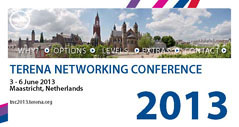 The TNC2013 was hosted by SURFnet, the Dutch National Research and Education Network in the picturesque city of Maastricht. The Treaty signed in Maastricht on February the 7th 1992 has made the city famous as the birthplace of the European Union and the single European currency, the euro. The Treaty has made Maastricht a symbol for Europe. SURFnet connects institutions in the Netherlands and the rest of the world via NetherLight (the international lightpath node in Amsterdam), AMS-IX (the world's largest Internet node), and the GÉANT network (the pan-European communications infrastructure). AMPATH, the International Exchange Point in Miami has a connection at AMS-IX. SURFnet will be celebrating its 25th anniversary and it sets the perfect scene for TNC2013. The TNC2013 was hosted by SURFnet, the Dutch National Research and Education Network in the picturesque city of Maastricht. The Treaty signed in Maastricht on February the 7th 1992 has made the city famous as the birthplace of the European Union and the single European currency, the euro. The Treaty has made Maastricht a symbol for Europe. SURFnet connects institutions in the Netherlands and the rest of the world via NetherLight (the international lightpath node in Amsterdam), AMS-IX (the world's largest Internet node), and the GÉANT network (the pan-European communications infrastructure). AMPATH, the International Exchange Point in Miami has a connection at AMS-IX. SURFnet will be celebrating its 25th anniversary and it sets the perfect scene for TNC2013.
CIARA at OSDC PIRE 2013 Data- Intensive Research Workshop
Big Data and Cloud Computing
June 17-21, 2013, Edinburgh, UK
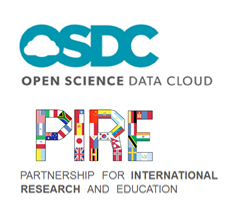
The second OSDC workshop in Edinburgh (opensciencedatacloud.org funded in part by the NSF PIRE program) will gather young researchers and experts to address today's challenges and to develop understanding in how best to exploit our growing wealth of data. How can we formulate questions and then use evidence from data to answer them without inadvertently introducing bias? How can we integrate data across boundaries from heterogeneous sources? How can we build machinery: hardware, software and internet protocols to enable this on a global scale? The participants, from North and South America, from Japan and from Europe will engage in talks, discussions, hands-on tutorials and debate. The outcome should be: new ideas, new understanding and lasting international alliances pursuing collaborative research.
Organization:
Prof. Robert Grossman PhD, University of Chicago
Prof. Heidi Alvarez PhD, Florida International University
Prof. Malcolm Atkinson PhD, University of Edinburgh Registration:
Please register at: http://osdc-pire-edinburgh2013.eventbrite.co.uk
|Download Program | Visit OSDC website | OSDC-PIRE Fellowship Application| Pico Presentation | Facebook Page |
Ampath participate in 2nd C@ribNET Assembly
"Collaboration, Cooperation, Community"
February 26-27, 2013

The 2nd C@ribNET Assembly will again bring together representatives of the Caribbean national research and education networks (NRENs) as well as leadership from the academic and research community, CARCOM agencies, government and as well as representatives from our international partners in Africa, North America, Latin America and Europe.
The Caribbean Heads of Government of the Caribbean Community (CARICOM) mandated the establishment of a Caribbean Research and Educational Network (C@ribNET), to be coordinated and managed by the Caribbean Knowledge and Learning Network (CKLN).
CKLN is pleased to announce that C@ribNET will be officially launched at this 2nd C@ribNET Assembly on February 26 in Port of Spain, Trinidad, under the theme "Collaboration, Cooperation, Community"
For more information visit website.
Dynamic Virtual Circuit Service Available on Americas Lightpaths (AmLight)
January 2013
Creating point-to-point dynamic virtual circuits is now possible between Miami, Florida and São Paulo, Brazil via the AmLight project. Using a web interface, authorized users may establish virtual circuits that cross one or more networks between the U.S. and Brazil supporting the U.S. Department of Energy - Energy Science Network (ESnet) On-Demand Secure Circuits and Advance Reservation System (OSCARS).
AmLight provides wide-bandwidth high-performance hybrid (packet and circuit) network services to research and education networks in the Americas participating in the AmLight project. Dynamic Virtual Circuit services are initially being supported through the AmLight East (Miami - São Paulo) connection. In the near future, dynamic circuit services will be supported through AmLight West (Los Angeles - Tijuana Mexico), AmLight Central (San Antonio - Mexico City) and AmLight Andes (Santiago Chile - Miami) connections.
AmLight's Dynamic Virtual Circuit Service is utilizing the Dynamic Network System (DYNES). The AMPATH International Exchange Point operates a DYNES regional node running the OSCARS system. The DYNES Inter-domain controller (IDC) at AMPATH is available to peer with IDCs of connected networks. The AMPATH IDC has been peered with IDCs on Internet2's ION network and with an IDC operated by RNP in
Brazil.
How to use the AmLight Virtual Circuit Service:
To use the AmLight Virtual Circuit Service users must first be authorized. Authorization may be requested by opening a ticket at the AMPATH Network Operations Center (NOC) and requesting authorization to use the AmLight Virtual Circuit Service.
Users may open a service request by contacting the AMPATH NOC either via the Web or telephone. To open a service request via the Web, please visit http://noc.ampath.net/ampath/support.html, then select "Submit a Request". By telephone, please call +1-317-274-7781 (24x7x365 ). Once authorization is granted, instructions to access the AmLIght Virtual Circuit service will be provided via email.
About AmLight: AmLight aims to enhance science research and education in the Americas by interconnecting key points of aggregation, providing operation of production infrastructure, engaging U.S. and western hemisphere science and engineering research and education communities, creating an open instrument for collaboration, and maximizing benefits of all investors.
AmLight is funded by the National Science Foundation (NSF), award #OCI-0963053 to Florida International University, and the Academic Network of Sao Paulo (award #2003/13708-0).
About DYNES: Dynamic Network System (DYNES) is an NSF-funded project (grant number 0958998) that integrates existing and emerging protocols and software for dynamic circuit provisioning and scheduling, in-depth end-to-end network path and end-system monitoring, and higher level services for management on a national scale. For more information about DYNES, please visit the DYNES project website at http://www.internet2.edu/ion/dynes.html.

2012
Super Computing 2012 Conference - SC12

Salt Lake City, UT, November 11 - 16, 2012
For 24 years, SC has been at the forefront in gathering the best and brightest minds in supercomputing together, with our unparalleled technical papers, tutorials, posters and speakers. SC12 will take a major step forward not only in supercomputing, but in super-conferencing, with everything designed to make the 2012 conference the most 'you' friendly conference in the world.
For more information visit website.
View OSDC poster
| Tukay poster | UDR poster | Matsu poster
NSF awards $500,000 grant to Division of IT
October 8, 2012
 The National Science Foundation has awarded a $500,000 grant to FIU's Division of Information Technology to create and build a dedicated network for the university's researchers.
This new network — which is a scientific network within the university's existing network — is known as a science DMZ, or science demilitarized zone. It will be optimized for high-performance scientific use rather than for general-purpose business systems. The National Science Foundation has awarded a $500,000 grant to FIU's Division of Information Technology to create and build a dedicated network for the university's researchers.
This new network — which is a scientific network within the university's existing network — is known as a science DMZ, or science demilitarized zone. It will be optimized for high-performance scientific use rather than for general-purpose business systems.
"This NSF funding for FIU will enhance our ability to support researchers at the state, national and international levels," says Robert Grillo, vice president and chief information officer for the Division of Information Technology. The award was effective Oct. 1 and runs through Sept. 30, 2014.
The project, titled "Campus Cyberinfrastructure-Network Infrastructure Engineering (CC-NIE) Network Infrastructure: FlowSurge: Supporting Science Data Flows Towards Discovery, Innovation and Education," will be carried out under the direction of Julio Ibarra, Heidi Alvarez and Maria Rosa Drake from the Division of IT, along with Eric Johnson from the School of Computer Science.
The network will be supported by technology that is gaining adoption in research environments referred to as OpenFlow and Software Defined Networking (SDN). FIU's project, called FlowSurge, will enable the university's Division of IT to "scale the network, or dynamically allocate network resources to researchers, very quickly," according to Grillo. Presently, university employees all use the same network, regardless of the type of work they are performing, leaving little opportunity to adjust the network in a nimble fashion for the benefit of the researchers.
"Right now, we have to collaborate with the researchers if large amounts of data sets need to be processed," explains Grillo. "With this new network, a researcher will have more flexibility to process their work independent of the requirements of a traditional campus network. This will be an enormous improvement for everyone involved."
The work of researchers typically involves the transfer of high-volume data sets and remote experiment control, necessitating the need for the creation of a science DMZ.
For details click here.
New World Symphony and Internet2 Prepare for Workshop on Performing Arts Production over Advanced Networks
January 26, 2012
 If you happen to be wandering through the streets of Miami Beach after dark, you may notice a strange glow coming from an incongruously open and green area nestled in the midst of the urban restaurants, street artists, and art deco hotels. If you then choose to stroll toward the glow, if your timing is right you may be greeted with the sweet sounds of the New World Symphony playing over their outdoor intelligent array of 162 speakers and displayed on a ridiculously large 7,000 square foot outdoor screen. This, my friends, is a Wallcast on New World’s freshly opened New World Center, designed by world-renowned architect Frank Gehry. And this is the venue where Internet2 and New World Symphony will be holding our Performing Arts Production Over Advanced Networks Workshop this coming March 4-6. If you happen to be wandering through the streets of Miami Beach after dark, you may notice a strange glow coming from an incongruously open and green area nestled in the midst of the urban restaurants, street artists, and art deco hotels. If you then choose to stroll toward the glow, if your timing is right you may be greeted with the sweet sounds of the New World Symphony playing over their outdoor intelligent array of 162 speakers and displayed on a ridiculously large 7,000 square foot outdoor screen. This, my friends, is a Wallcast on New World’s freshly opened New World Center, designed by world-renowned architect Frank Gehry. And this is the venue where Internet2 and New World Symphony will be holding our Performing Arts Production Over Advanced Networks Workshop this coming March 4-6.
While this is the first time the workshop will be held in this fancy new venue (which is just as technically amazing on the inside as it is on the outside), the workshop itself has existed for a number of years now, and it’s been a pleasure seeing it evolve. The goal of this workshop is to bring colleagues in the performing arts field together to learn and discuss cutting edge methods to take advantage of advanced networking technology for artistic purposes. For example, New World Symphony has provided a shining example for many years with their ongoing remote master classes, executed using DVTS software pushing 30Mbs over their Internet2 Network connection. This year we will be excited to discuss and demonstrate LOLA, which provides the unprecedented capability for musicians to perform together from remote locations by leveraging a never before seen low level of latency. It’s pretty exciting stuff.
This year, I’ll be giving a talk with my colleague Justin Trieger, the New World Symphony Internet2 Systems Manager, where we discuss how to pick the appropriate video and audio technology for your application. We’ll also be facilitating a hands-on free-for-all where participants can get face time with LOLA, DVTS, ConferenceXP, EchoDamp, a Polycom HDX, a Cisco MXP, and various cameras, lights, and microphones.
In any case, registration is now open, and if you’re doing performing arts at an Internet2 connected institution, I sincerely hope to see you there.
March 4-6, 2012
Explore in depth the elements needed to do everything from simple one-on-one interactions to large scale stage productions and distance learning via advanced networks. The workshop is designed for an audience of educators, technologists, administrators, deans, CIOs and all interested parties are invited to attend.

2011
AMPATH to launch support for Dynamic Hybrid Networking
Download this Press Release as PDF
PRESS RELEASE
Media Contact:
Heidi Alvarez, Director
Center for Internet Augmented Research and Assessment (CIARA)
Florida International University
305-348-2006
heidi@fiu.edu
Miami, Florida, August 1, 2011 – CIARA announced today that it will begin a five year project to bring advanced network services to the AMPATH Open Exchange Point in Miami.
AMPATH will support dynamic hybrid (packet and circuit) network services in both production and experimental environments through the following activities:
• Deployment and operation of a production-level traffic monitoring and reporting system for dynamic circuit network services, including those used in international connections.
• Upgrade of the AMPATH GOLE (GLIF Open Lightpath Exchange) to support the dynamic provisioning of GLIF lightpaths.
• Deployment of OpenFlow switches and controllers to interconnect OpenFlow networks in Brazil with those of Internet2 and GENI.
• Deployment and operation of an experimental traffic monitoring and reporting system to prototype the Coral Reef passive monitor to support OpenFlow.
• Engagement with users and science projects, and collaboration with developers, engineers, operators and science communities to develop use cases demonstrating the increasing utility of the adoption of dynamic circuit network services.
“With the establishment of dynamic hybrid networking at AMPATH, we will be able to bridge important research underway in Brazil with the GENI efforts in the U.S. Over the coming years, these services will grow in both accessibility and impact.”, said Dr. Chip Cox, Chief Operations Officer of AMPATH.
“RNP welcomes AMPATH’s adoption of dynamic circuit services, which will promote significant advances in providing support for international cooperation between Brazil and the United States, both in the field of e-Science and in Future Internet experimentation within GENI”, commented Dr Michael Stanton, Director of Research and Development at Brazil’s National Research and Education Network.
The OpenFlow service effectively makes network devices part of a programmable infrastructure allowing networks to be defined in software. Although this is not an entirely new approach, it is being widely adopted internationally to develop new approaches to network architecture.
This research into the evolution of the Internet is of global scale, and requires a global team to harmonise interoperabiility. AMPATH is supporting this innovation throughout the Americas through the support of a NSF supplement to the AMLIGHT project (PI Julio Ibarra). The end result will be an enabling network supporting critical research, science and education seamlessly meeting needs today, and preparing for tomorrow.
About CIARA: Florida International University’s Center for Internet Augmented Research and Assessment (CIARA) has developed an international, high-performance research connection point in Miami, Florida, called AMPATH (AMericasPATH; www.ampath.fiu.edu). AMPATH extends participation to underrepresented groups in Latin America and the Caribbean, in science and engineering research and education through the use of high-performance network connections. AMPATH is home to the Americas Lightpaths (AmLight) high-performance network links connecting Latin America to the U.S., funded by the National Science Foundation (NSF), award #OCI-0963053 and the Academic Network of Sao Paulo (award #2003/13708-0). AmLight aims to enhance science research and education in the Americas by interconnecting key points of aggregation, providing operation of production infrastructure, engaging U.S. and western hemisphere science and engineering research and education communities, creating an open instrument for collaboration, and maximizing benefits of all investors.
CIARA Receives $875,000 Grant from the National ScienceFoundation as sub-contract on $3,500,000 Award to the University of Chicago
Open Science Data Cloud (OSDC); Partnerships for International Research and Education (PIRE)
April 15, 2011
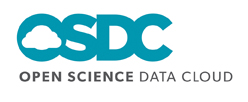 Miami, FL. – The NSF has awarded a 5-year grant to the OCC Open Science Data Cloud project. Florida International University has been selected as a participant and will be sending students to Brazil this summer to conduct research for the OSDC-PIRE program. Miami, FL. – The NSF has awarded a 5-year grant to the OCC Open Science Data Cloud project. Florida International University has been selected as a participant and will be sending students to Brazil this summer to conduct research for the OSDC-PIRE program.
The international PIRE project aims to narrow the growing gap between the capability of modern scientific instruments to produce data and the ability of researchers to manage, analyze, and share those data in a reliable and timely manner.
The emerging technology of cloud computing is a step forward from the current cyberinfrastructure. Cloud computing involves clusters ,the "clouds", of distributed computers that provide potentially less expensive, more flexible, and more powerful on-demand resources and services over a network, usually the Internet, while providing the scale and the reliability of a data center.
Scientists at the University of Chicago, the University of Illinois at Chicago, and Florida International University will collaborate with six international research groups located in Europe (Amsterdam and Edinburgh), Asia (Seoul and Beijing), and South America (Rio de Janeiro and Sao Paulo). The team includes experts in cloud computing, high-performance networking, e-Science, education and outreach.
Renowned astronomer, Dr. Alex Szalay of Johns Hopkins University, is working with the OSDC for developing cloud computing infrastructure for managing and analyzing the Sloan Digital Sky Survey astronomical dataset. Dr. Kevin White from the University of Chicago is partnering for developing cloud computing infrastructure for analyzing biological data
This PIRE team intends to help develop a large-scale system of distributed computing capabilities – the Open Science Data Cloud (OSDC) – to provide long term persistent storage for scientific data and state-of-the-art services for integrating, analyzing, sharing and archiving scientific data.
In addition to the research dimensions of this project, OSDC-PIRE will conduct workshops in the use of the cloud cyberinfrastructure aimed at many domain scientists and their students. Graduate students and early career scientists can apply to work with our OSDC foreign partners.
"The Open Science Data Cloud will contain over 1 petabyte (1000 terabytes)* of persistent scientific data from a variety of fields. It will not only store the data but also allow scientists to compute over it," said Dr. Robert Grossman, Chair of the Open Science Data Cloud. "This is the first time that such a large amount of scientific data has been made available to the scientific community in this way. We are expecting lots of surprises in how the OSDC will be used."
Dr. Heidi Alvarez of FIU-CIARA, is a Co-Principal Investigator of the project.
"Our vision is to load diverse datasets that have been available but separate within the next five years," said Dr. Alvarez. "This project will create storage systems that can withstand the test of time."
*For comparison, Google processes 24 petabytes a day, while AT&T has about 19 petabytes of data transferred through their networks each day.
CIARA Receives $5.4M Grant from the National Science Foundation
January 28, 2011
Miami, FL. – Florida International University has been awarded $5.4 million from the National Science Foundation (NSF) to lead the project to enhance network infrastructure for science research and education between the U.S. and Latin America. The Center for Internet Research and Assessment (CIARA), part of FIU’s Division of Information Technology, will manage the project on behalf of FIU. The project, Americas Lightpaths, named AmLight, builds upon the achievements of FIU’s previous NSF awards in international research network connections.
With the support of the NSF and the contributions of national and international partnerships, the AmLight project establishes lightpaths between the U.S. and Latin America from four geographical locations: Miami-São Paulo, Santiago-São Paulo, San Diego-Tijuana, and San Antonio-Mexico City. “Lightpaths” refers to physical network connections between two or more networks based upon photonic technologies.
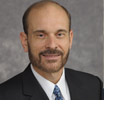 “Lightpaths are essential, because they provide the technological capacity needed to support the high-bandwidth requirements of science applications. The U.S. research and education community will be connected to 18 countries and an estimated 100 million students, faculty, and researchers through these lightpaths”, says Julio Ibarra, Assistant VP and Principal Investigator of AmLight. “Lightpaths are essential, because they provide the technological capacity needed to support the high-bandwidth requirements of science applications. The U.S. research and education community will be connected to 18 countries and an estimated 100 million students, faculty, and researchers through these lightpaths”, says Julio Ibarra, Assistant VP and Principal Investigator of AmLight.
The AmLight award will have an immediate impact on several FIU research projects of international scope. One of these projects is PrimoGENI which implements a real-time network simulation for the NSF Global Environment for Network Innovations (GENI).
 “PrimoGENI coupled with AmLight network resources extends the GENI infrastructure to partnership programs in Brazil to prototype future Internet network architectures”, says Jason Liu, Assistant Professor and Principal Investigator of PrimoGENI. “PrimoGENI coupled with AmLight network resources extends the GENI infrastructure to partnership programs in Brazil to prototype future Internet network architectures”, says Jason Liu, Assistant Professor and Principal Investigator of PrimoGENI.
The Cyberinfrastructure - Partnerships for International Research and Education (CI-PIRE) project creates a hub of international collaboration to enable research discoveries by supporting science and engineering applications with Cyberinfrastructure.
 “CI-PIRE relies upon the AmLight network resources to provide researchers and fellows unconstrained access to CI resources in the U.S. and Latin America”, said Masoud Sadjadi, Associate Professor and Principal Investigator of CI-PIRE. “CI-PIRE relies upon the AmLight network resources to provide researchers and fellows unconstrained access to CI resources in the U.S. and Latin America”, said Masoud Sadjadi, Associate Professor and Principal Investigator of CI-PIRE.
FIU’s faculty and students are also able to connect to off-site locations and conduct research observations by leveraging the infrastructure FIU has established between the U.S. and Latin America via AmLight. For example, as a member of the Southern Association for Research in Astronomy (SARA) Observatory, FIU is able to remotely operate a telescope located in northern Chile using the AmLight infrastructure.
 “Although I’ve never even been to Chile, I can still use the SARA telescope located there to do research from campus.” says Dr. James Webb, professor of physics at FIU. “Although I’ve never even been to Chile, I can still use the SARA telescope located there to do research from campus.” says Dr. James Webb, professor of physics at FIU.
CIARA, in close cooperation with its national and international partners, will lead the AmLight initiative to connect research and education communities in the U.S. with their counterparts in Latin America.
 “Experience in the implementation and operation of large-scale international network infrastructure by CIARA was a key reason why FIU was awarded to lead this project on behalf of the NSF”, said Dr. Min Yao, FIU Vice President and CIO. “Experience in the implementation and operation of large-scale international network infrastructure by CIARA was a key reason why FIU was awarded to lead this project on behalf of the NSF”, said Dr. Min Yao, FIU Vice President and CIO.

2010

Haiti Fundraising Kick-off Event
FIU Panther Pit (Graham Center), May 18th, 2010.
On Tuesday, May 18th, Columbus Networks sponsored a fundraising event at FIU to help raise awareness and financial support for victims of the Haiti earthquake. Columbus Networks is a telecommunications services provider that offers broadband and IP services to: Telecom Carriers, TV Cable Companies, Internet Service Providers, Network Integrators.
View (Event Flyer | Students Letter | Event Pictures)
For more information visit Columbus Networks website.
InterAcademis Panel Program on Digital Knowledge Resources and Infrastructure in Developing Countries.
Montego Bay, Jamaica, May 12-14, 2010.
The Steering Committee of the InterAcademies Panel Program on Digital Knowledge Resources and Infrastructure in Developing Countries met in Montego Bay, Jamaica during 12-14th May, 2010 and a statement on "Building the CyberInfrastructure for 21st Centure e-Science in Central America and the Caribbean" was prepared.
View (Heidi Alvarez Presentation | Workshop Agenda | Steering Committee Meeting Agenda | Workshop Pictures)
 - The Crisis in Haiti: What can YOU Do to Help? - The Crisis in Haiti: What can YOU Do to Help?
LIVE WEBSTREAM, February 19, 2010. 10:00 AM - 1:00 PM EST
On Friday, February 19th from 10:00 AM – 1:00 PM EST, MAGPI sponsored an international videoconference and webcast to help raise awareness and financial support for victims of the Haiti earthquake. MAGPI members worked hard to line up some phenomenal speakers, representatives from aid agencies, and student presentations/performances as part of this international event. For more information please visit MAGPI website.
View event photos | Check out students helping Haiti blog | Facebook page for this event
Read the Press Release

2009
CineGrid 4th Annual International Workshop 2009
La Jolla, CA, December 6-9, 2009
CineGrid is a non-profit international membership organization administratively based in California. CineGrid's mission is to build an interdisciplinary community focused on the research, development and demonstration of networked collaborative tools, enabling the production, use and exchange of very high-quality digital media over high-speed photonic networks. CineGrid 4th Annual International Workshop was hosted by the California Institute for Telecommunications and Information Technology (Calit2) at University of California, San Diego (UCSD).
For more information visit website.
View "Enquanto a Noite Nao Chega" by Beto Souza (Video | Presentation)
Super Computing 2009 Conference
Portland, Oregon, November 14-20, 2009
Super Computing annual Conference 2009 (SC 09) was held at Portland, Oregon. Recognized globally as the premier international conference on High Performance Computing (HPC), networking, storage and analysis, SC09 will feature the most interesting and innovative HPC scientific and technical applications from around the world.
For more information visit SC 09 website.
Bandwidth Challenge (bwc) (CIARA team win's bwc | more info... | press release)
9th Annual Global LambdaGrid Workshop
Daejeon, Korea, October 27-28, 2009
GLIF, the Global Lambda Integrated Facility, is an international virtual organization that promotes the paradigm of lambda networking. GLIF provides lambdas internationally as an integrated facility to support data-intensive scientific research, and supports middleware development for lambda networking. It brings together some of the world's premier networking engineers who are working together to develop an international infrastructure by identifying equipment, connection requirements, and necessary engineering functions and services.
For more information visit website.
View Heidi Alvarez Presentation | View Julio Ibarra Presentation
Fall 2009 Internet2 Member Meeting
San Antonio, Texas, October 5-8, 2009
Internet2 is a not-for-profit advanced networking consortium comprising more than 200 U.S. universities in cooperation with 70 leading corporations, 45 government agencies, laboratories and other institutions of higher learning as well as over 50 international partner organizations.
For more information visit website.
World Symphony on track for 2011 building opening
Miami, Florida, September 17, 2009
The new world symphony's new home continues to sprout upon on Miami Beach and is about a year from completion, its president says.
Read Full Press Release.
Global Cyberbridges - California Institute for Telecommunication and Information Technology Student Summer Workshop
San Diego, California, June 30 - July 2, 2009
The GCB international program is comprised of a series of geographically distributed projects each supported for a one year period with the goal of having the graduate students and their faculty advisors adopt longer term collaborative strategies. There is a technology transfer relationship between FIU and Calit2 at UCSD in order to realize the vision of team science at all levels of graduate and post-graduate education and research. Calit2 has worked with GCB to move collaborative and visualization tools developed by OptIPuter into a production mode. Now we are able to incorporate both a graduate student project and a summer workshop for GCB students at Calit2 at UCSD, CA.
For more information visit website.
12th TRANS-EUROPEAN RESEARCH AND EDUCATION NETWORKING ASSOCIATION (TERENA) Networking Conference 2009
Malaga, Spain, June 8 - 11, 2009
The conference was held in University of Malaga, Spain.
For more information visit website.
View Heidi Alvarez Presentation.
10th workshop of Rede Nacional de Pesquisa (RNP)
Recife, Brazil, May 25 - 26, 2009
The conference was held in Recife, Brazil.
For more information visit website.
View Julio Ibarra Presentation.
Annual meeting of the Coordinating Committee for Intercontinental Research Networking (CCIRN)
Arlington, Virginia, April 30, 2009
CCIRN provides a forum for members to agree and progress a set of activities to achieve inter-operable networking services between participating international entities to support open research and scholarly pursuit.
For more information about the Atlantic Wave please visit the project website.
View Julio Ibarra Presentation.
2009 EduCause Learning Initiative Annual Meeting
Orlando, Florida, January 20 - 22, 2009
The 2009 EduCause Learning Initiative Annual Meeting, Participation and Collaboration: Social Learning for the 21st Century, to explore processes and practices focused on social learning and student success. In the ELI tradition, the annual meeting is a setting for interactive, hands-on learning and networking, with a variety of presentations, discussions, and workshops. Sessions will fall into one of three interest areas: learners, learning principles and practices, and learning technologies.
For more information visit website.
View Heidi Alvarez Presentation | View Masoud Sadjadi Presentation

2008
Ultralight/PLaNetS Tutorial Workshop 2008
Miami, Florida, December 2, 2008
Ultralight / PLaNetS Tutorial Workshop will be held on December 2, 2008 and hosted by Florida International University. The purpose of the tutorial in Education and Outreach is to disseminate the capabilities and use of the PLaNetS services to support LHC data analysis and other applications.
For more information visit website.
Florida LambdaRail Joins Forces with CiscoWave and UltraLight/PLaNetS to enable the AtlanticWave and Brazil’s CMS Tier2 facilities to participate in Super Computing 2008
Austin, Texas, November 18, 2008
Florida LambdaRail (FLR) joined forces with CiscoWave (C-Wave), UltraLight/PLaNetS and AtlanticWave (A-Wave) for the Super Computing 2008 event to enable Brazil’s CMS distributed Tier2 facility to participate in the bandwidth challenge competition.
Read full press release
Graduate Fellowships for Global Cyberbridges Informational Workshop 2008
Florida International University, October 29, 2008
Graduate Fellowships for Global Cyberbridges Informational Workshop, Wednesday, October 29th, from 1:00 to 2:00 pm at FIU's Graham University Center, Room 1215 (Conference Room).
For more information visit website
Workshop flier | View presentation
Caribbean Regional Emerging Networks Meeting 2008
New Orleans, Louisiana, October 13, 2008
The Caribbean Regional Emerging Networks will meet on October 13, 2008 as a side meeting to the Fall Internet2 Annual Members Meeting. The meeting will be held at the Sheraton New Orleans Hotel in New Orleans, Louisiana.
For more information visit website.
4th Caribbean Internet Governance Forum
Curacao, Netherlands Antilles, July 23-24, 2008
Caribbean Telecommunications Union (CTU) in association with the Latin American and Caribbean Internet Addresses Registry (LACNIC) host the 4th Caribbean Internet Governance Forum Implementing the Caribbean Internet Governance Agenda: From Proposal to Policy in Curacao, Netherlands Antilles, July 23-24, 2008. Heidi Alvarez was invited to present on the Internet2 evolution and AMPATH – the high performance exchange point in Florida which is facilitating peering and network research between education and research institutions. A presentation on this topic would be of particular interest to the Caribbean Knowledge and Learning Network delegates and serve to sensitize delegates on the value of research and education networking.
For more information visit website.
View Heidi Alvarez Presentation
Network Planning group for LSST telescope project
Miami, Florida, July 20 - 21, 2008
CIARA is hosting a network planning group for the LSST telescope project at Florida International University on July 20-21, 2008.
For more information on the Large Synoptic Survey Telescope, visit website.
Pan American Studies Institute - Cyberinfrastructure for international collaborativ biodiversity and ecological informatics
Costa Rica, June 1 - 13, 2008
PASI (Pan American Studies Institute) in Costa Rica was held on June 1-13, 2008.
For more information visit website.
Florida International Grid School 2008
Miami, Florida, January 23 - 25, 2008
Florida International Grid School 2008 has been scheduled for January 23-25, 2008 at Florida International University’s Wolfsonian Museum in Miami Beach, Florida.
For more information visit website.
NSF Sponsored Genomics Workshop
Lima, Peru, January 16 - 19, 2008
For more information visit International Collaborations in Cyberinfrastructure-enabled Genomics Workshop.

2007
Graduate Fellowships for Global Cyberbridges Informational Workshop 2007
Florida International University, Miami, Florida
Workshop1: Monday, November 26th, from 1:00 to 2:00 pm at FIU's Green Library Building, Room 835
Workshop2: Friday, November 30th, from 1:00 to 2:00 pm at FIU's Graham University Center, Room 305
View Workshop Flier

2006
Workshop on Cyberinfrastructure for International Biodiversity Research Collaboration
City of Knowledge, Panama, January 10 - 13, 2006
Biodiversity informatics is an interdisciplinary research and infrastructure development activity. It thrives on collaborations among environmental biologists, computer scientists, and network and software engineers. As environmental biology becomes increasingly data-driven, the nature of international collaborations in biodiversity will evolve to include more network-based interactions and communications. Expectations for essentially instantaneous access to data sets and to computational tools and services, will change the timing and logistics of collaborative work. The workshop examined trends where cyberinfrastructure is likely to effect change in biodiversity research informatics.
For more information visit website.

2005
Chinese American Networking Symposium 2005
Shenzhen, China, November 1 - 3, 2005
Networking experts from China and the United States gather annually at the Chinese-American Networking Symposium (CANS) to discuss new ideas and advancements in networking technologies. The annual programs, alternately held in the USA and China, including presentations by networking experts, panel discussions, and technical breakout sessions.
For more information visit website.
Pan American Studies Institute for E-Science 2005
Florida International University, May 15 - 21, 2005
The Pan American Studies Institute on Advanced Networking Technologies for E-Science was favorably reviewed and funded by the NSF Office of International Science and Engineering. The intellectual merit is that anew bridge between astronomy, physics and the advanced networking community will be created, fostering new discoveries. The PASI will not be a locus for fundamental research; rather it will incubate a new generation of scientists and engineers who are capable of fully integrating advanced networking into astronomy and physics research and education.

2004
Chinese American Networking Symposium 2004
Shenzhen, China, November 30 - December 2, 2004
Networking experts from China and the United States gather annually at the Chinese-American Networking Symposium (CANS) to discuss new ideas and advancements in networking technologies. The annual programs, alternately held in the USA and China, including presentations by networking experts, panel discussions, and technical breakout sessions.
For more information visit website.
Super Computing 2004 Conference
Pittsburgh, PA, November 6 - 12, 2004
The SC2004 conference will bring representatives from many technical communities together to exchange ideas, celebrate past successes and plan for the future. To reflect this important function, the conference theme is Bridging Communities, which represents not only the technical communities participating in the conference but the architecture of the city, too.
For more information visit website.
View Network Diagram
Learn More
Networks and Grids for HENP as Global e-Science (Presentation to SC2004)
Bandwidth Diagram 1
Bandwidth Diagram 2
Overall Network Diagram (with affiliates)
|
